Galway Metals (GWM.V, GAYMF) is a Canadian exploration stock with two prospective projects located in strategic locations. Fundamentally, some things stand out.
1. Insiders
Over 30% of outstanding shares are in the hands of management and insiders. High quality management as both CEO and Chief Geo come from Kirkland Lake Gold (KL.TO) where they also held management positions. Another reputable insider is Wesdome’s (WDO.TO) CEO Duncan Middlemiss, who has an advising role at Galway Metals. Connections like these could be important in a later stage should
exploration continue in the current direction.
In the past year, 5 insiders have been buying their own stock, of which CEO Robert Hinchcliffe invested the highest amount. Through 2018, he bought $285,000 worth of stock in the open market and another $100,000 in a private placement. Other insiders put in between $25,000 and $88,000 of their own money into Galway Metals.
Insiders are dedicated as well. When looking at their personal holdings, the biggest part of this is held in GWM shares. Data like this can be retrieved on marketscreener.com. Management in this business usually has seats on more than one company’s board, which means they hold more than just one stock. Therefore, it’s interesting to see the weight of these. Allocations at Galway Metals show conviction: CEO 89%, VP 73%
and Chief Geo 47%.
2. History
Galway Metals was spun out of the Galway Resources takeover by AUX in 2012. At the time, Galway Resources was sold for $340M. Management is largely the same since then, so they’re experienced in growing an exploration stage company to one that’s prepared for production. Galway Resources (GWY) shareholders received a 47% premium in that deal.
3. Projects
Galway Metals has 2 projects in Eastern Canada in mine friendly jurisdictions in areas where infrastructure such as roads, railways and mills are closeby. Both projects have an existing resource for both gold and industrial metals. One million ounces of gold have been mapped to date and if we add the other metals, there’s 1.8 million gold equivalent ounces. These past years there has been a resource upgrade yearly, and this year as well, they will upgrade their existing resources on both projects
Clarence Stream
Located in mining friendly New Brunswick and in the proximity of a processing mill and (rail)roads nearby. Management hints that this project can represent a new gold district in Canada. Findings to date continue to prove this out: This project has 5 discovered zones thus
far on the main NE-SW trend with high possibility for new discoveries going by soil anomalies. Galway just announced assays from their fifth and new discovered zone: 7.3g/t over 36.7m (38.1g/t over 6.5m). A 50m stepout has been drilled which intersected visual gold twice. Results from this are pending.
This new discovery is in the middle of two known zones (Jubilee and George Murphy) that are 2km apart. Galway controls 65km of this main NE-SW trend and management believes this shares the same structure and has similar geology as Marathon’s (MOZ.TO) Valentine Lake project. Only 5km have been drilled and all zones are open in every direction. Wide mineralization at shallow depths with grades which would make this suitable for open pit mining.
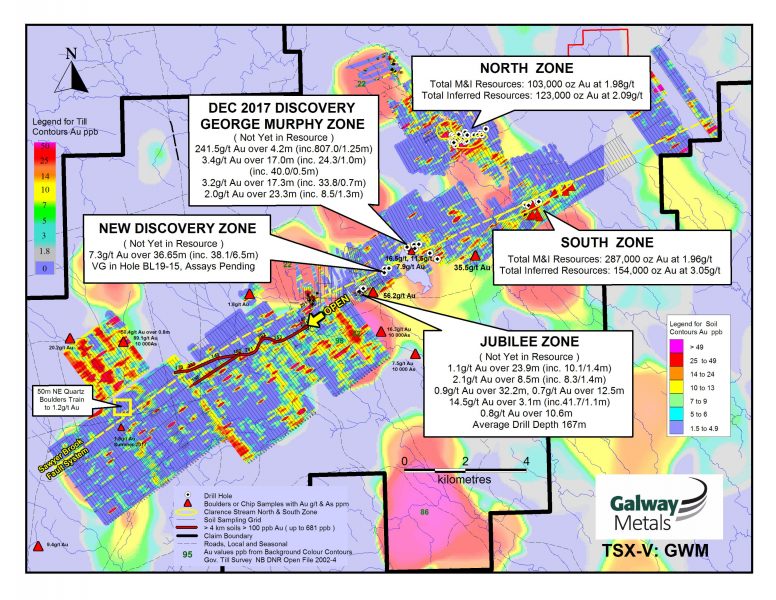
Estrades
Polymetallic project that saw production in 1990-1991:174,946 tonnes grading 6.4 g/t Au, 172.3 g/t Ag, 12.9% Zn and 1.1% Cu. Previous owner stopped production when metals prices dropped in 1991. Since then this former mine has been dormant for over 25 years. Located in mining friendly Québec with multiple deposits, active and historic mines in
the proximity. 31km of strike hosting 3 mineralized trends which hold a resource that’s high in Zinc (20.75% ZnEq) and Gold (11.28g/t AuEq).
Just like the Clarence Stream project, this is currently being drilled so news from here should flow in coming weeks.
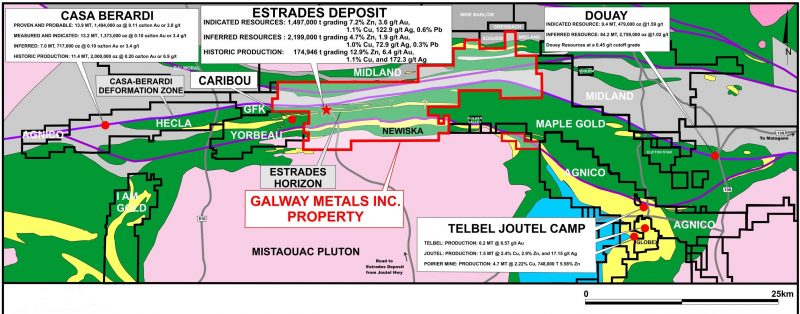
4. Cashed up
All that drilling costs money. Therefore, it’s interesting to know that Galway has about $7M in the bank after a recently closed private placement (in which 4 insiders participated), which means they can continue this aggressive exploration. Galway Metals doesn’t have any debt. Also of importance is that chief geo and vice president bought warrants with an execution price of $0.50, which -when executed- will add $750,000 to the treasury.
5. Catalysts 2019
Two catalysts this year for a revaluation. Catalyst # 1: Exploration success and new discoveries on Clarence Stream and Estrades. On Clarence stream, investors have a couple of pending results to look
forward to from drill cores that showed visual gold as well as future step-out holes from current zones. Catalyst # 2: Resource upgrade 2019 including the new zones. Management pointed at a resource upgrade this year that will – for the first time- include 2 new zones at Clarence Stream.
6. Comparables and valuation
When looking at other Eastern Canadian companies that share this continent scale trend, it’s easy to see their Clarence Stream project is favourably located in between known multi million ounce gold camps.
Similarities with Oceanagold’s Haile mine, which is an open pit mine that shares shallow depth in combination with high grades. Another similar case is Atlantic Gold over in Nova Scotia. This has the same
widespread gold occurrences on their property and built a central processing facility that’s currently being fed by the surrounding deposits.
Galway is not yet at this stage and management may not have the intention to mine it themselves. Just going by similar geological features and challenges, it’s positive to see nearby succeeded projects.
As valuation goes, when looking at the only metric we can currently apply – which is the enterprise value on a proven gold ounce basis- we’re sitting at $17.4/oz whereas this sector’s (pre feasibility) average is $52/oz. Noteworthy that this number is based on the current resource, that only holds 2 of the 5 zones at Clarence Stream.
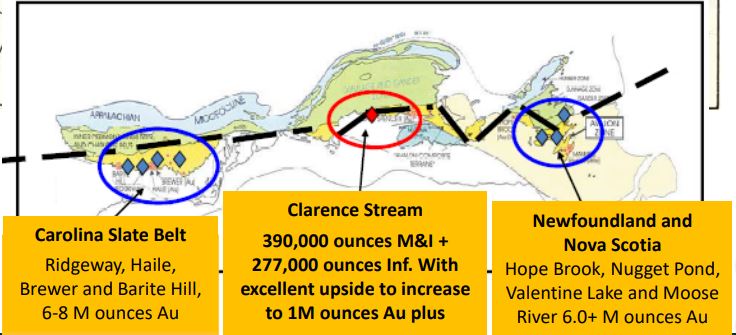
7. In Closing
As said in the intro, Galway has a lot going for it. Two catalysts this year that will continue to get fed from multiple fronts. Galway has a rather tight share float (107M) and they don’t need to collect funds any
time soon, meaning that their share price will benefit with a leverage effect when exploration continues to deliver. Management is experienced, respected, committed and on the buying side. Not to be taken for granted in any sector. Eastern Canadian gold deposits are on the rise and going by the fundamentals there’s good potential that this too will turn out to be a multi million ounce deposit, eyed by producing mining companies. Going by the EV/oz metric, there should be plenty of room for upside.
Jonas De Roose
February 22, 2019
Author Jonas De Roose is a Belgian retail investor in precious and base metals stocks with a drive for research and learning. He has a background in business development and marketing. He owns shares in Galway Metals and his article is not intended as investment advice. This article is based on his findings and based on his personal opinion. If you have suggestions regarding this company feel free to contact him at jonasderoose@hotmail.com.
- As U.S. markets re-open after the holiday, the world’s “queen of assets” continues her glorious ascent to higher prices. Please click here now. Double-click to enlarge this magnificent short term gold chart.
- The rise above $1332 ushers in my new short-term target: $1355!
- Please click here now. Gold is well on its way to becoming a mainstream asset like stocks and bonds.
- The reason for that is the “citizen wealth effect” created by the relentless rise of China and India. These gold-oriented nations are well on their way to becoming the most gargantuan economic empires in the history of the world.
- It’s simple mathematics: There are eight Chindians for every American, and about half of the Chindians are under the age of 35.
- It’s an unstoppable force that I refer to as, “The Gold Bull Era”.
- In the West, gold has been traditionally bought only when major stock, bond, currency, and real estate markets get into trouble.
- In contrast, Chindian citizens view gold as the “ultimate asset”, meaning they buy it in both good times and bad.
- This view is beginning to gain acceptance amongst Western analysts and money managers and I’m predicting it will continue to do so for many decades.
- Gold’s role as ultimate asset was showcased in the September-December period when it rose while U.S. stock markets tumbled.
- Most gold bugs were stunned by the incredible price action, and even more stunned as the GDX gold stocks ETF soared too!
- Now, gold is rallying while U.S. stock markets rise, and most analysts are again somewhat shocked as their attempted top calls for gold fail repeatedly.
- This type of “win-win” price action is unique to gold and I’ll boldly state that it is essentially here to stay!
- Please click here now. Double-click to enlarge. On this daily chart, gold looks like a freight train that cannot be stopped.
- From a big picture technical perspective, this type of daily chart action is expected and normal. To understand why I say that, please click here now. Double-click to enlarge what I consider to be the greatest weekly chart in the history of markets.
- Gold appears to be rallying from the final right shoulder in a multi-shouldered inverse H&S bull continuation pattern. Incredibly, that pattern itself appears to be just the head of a much more gargantuan pattern with a target price of $3000!
- In this situation, the current “freight train” technical action being showcased by gold on the daily chart is perfectly normal.
- Please click here now. Double-click to enlarge this key GDX daily chart. A spectacular bull flag breakout occurred on Friday.
- In pre-market action this morning, the price is gapping higher.
- Please click here now. Double-click to enlarge. That’s another look at GDX on a short-term chart.
- With the bull flag breakout now in play, stop-loss enthusiasts can now raise their protective profit-locks from $20.10 to $21.75.
- Please click here now. Double-click to enlarge this silver stocks ETF chart.
- A classic staircase chart pattern is developing. Traders can raise protective stop-loss orders from $24 to $26.
- I recommend that all investors carry some silver and associated miners in their portfolios and the $26 stop-loss level for SIL-NYSE allows investors to board this precious metals “freight train” with minimal risk and maximum potential reward!
Special Offer For Website Readers: Please send me an Email to freereports4@gracelandupdates.com and I’ll send you my free “Golden Cogs In The Bull Era Wheel!” report. I highlight six of the hottest mining stocks in the world that are poised to lead the sector in 2019, with pinpoint tactics to help traders and investors get richer!
Thanks!!
Stewart Thomson
Graceland Updates
Email:
Graceland Updates daily between 4am-7am. They are sent out around 8am-9am. The newsletter is attractively priced and the format is a unique numbered point form. Giving clarity of each point and saving valuable reading time.
Risks, Disclaimers, Legal
Stewart Thomson is no longer an investment advisor. The information provided by Stewart and Graceland Updates is for general information purposes only. Before taking any action on any investment, it is imperative that you consult with multiple properly licensed, experienced and qualified investment advisors and get numerous opinions before taking any action. Your minimum risk on any investment in the world is: 100% loss of all your money. You may be taking or preparing to take leveraged positions in investments and not know it, exposing yourself to unlimited risks. This is highly concerning if you are an investor in any derivatives products. There is an approx $700 trillion OTC Derivatives Iceberg with a tiny portion written off officially. The bottom line:
Are You Prepared?
Roughly one year ago and prior to that we observed that the gold stocks could be following the recovery template from what we deemed a “mega bear market.”
We define that as a bear market that is over two and a half years in time and over 80% in price. It cuts both ways.
The gold stocks from 2011 to January 2016 had declined more than 80% and for more than four years. It was a textbook mega bear market.
The sharp recovery in 2016 quickly faded and left us wondering if there was a historical comparison.
Turns out, there are three strong and relevant comparisons.
The housing sector declined 81% from its peak in 2005 to the market bottom in March 2009. Then it rebounded 137% before correcting 42% over 18 months. The correction ended with a false new low.
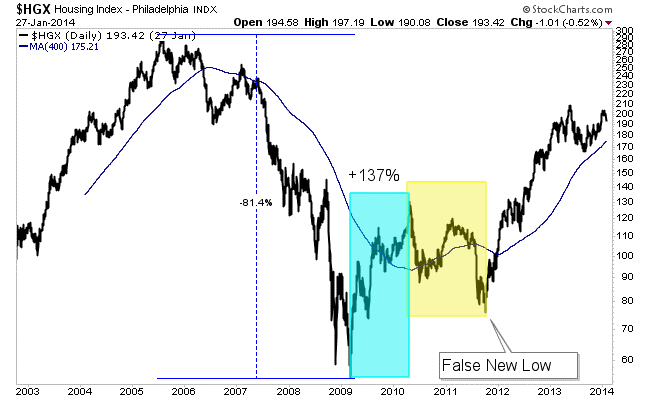
The S&P 500 crashed nearly 90% over a nearly three year period. Then it rebounded 177% before correcting for 20 months. That correction also ended in a false new low.
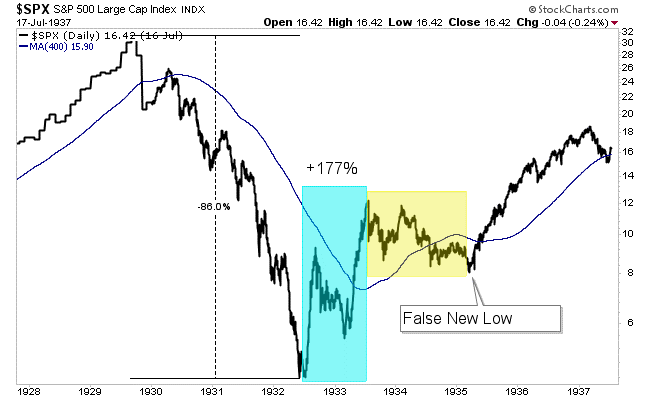
Thailand from 1994 through 2000 is quite similar to the gold stocks from 2011 through 2016. Before its 200% move higher from 2002 through 2003, Thailand corrected 54% over a 2-year and 5-month period.
Note that its final low at the end of 2001 could have been a false new low if not for the initial sharp correction down to L1.
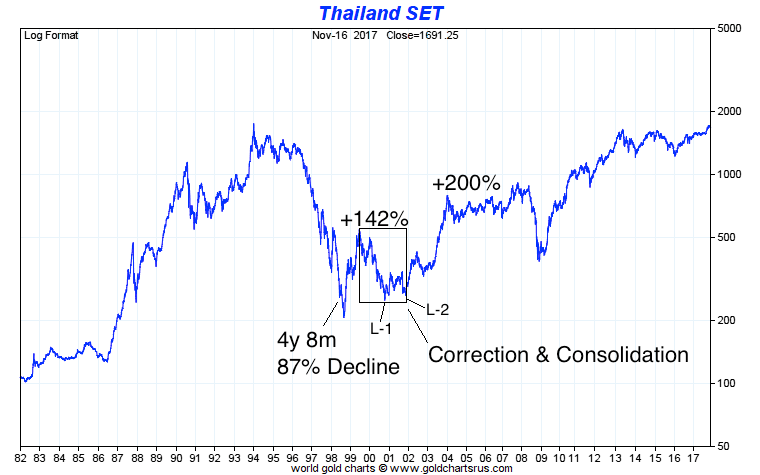
The template for a recovery from a mega bear market is as follows.
Following the bear market low, a sharp rally begins that lasts only six to twelve months. Then the market endures a significant correction that lasts a minimum of 18 months and ends with a breakdown to new lows (which ends up being a false move).
Then the major wave higher begins.
Here is the data on those three examples, another one (Mortgage sector) and the gold stocks (GDX).

Note how the time between the bear market bottom and the correction low (for the gold stocks) is almost identical to three of the four examples. Also, note how the second leg higher surpassed the initial rebound in each example (ex S&P 500).
Here is how GDX stacks up (visually) with the others. Its rebound (and potentially second leg higher) began after the false breakdown in September.
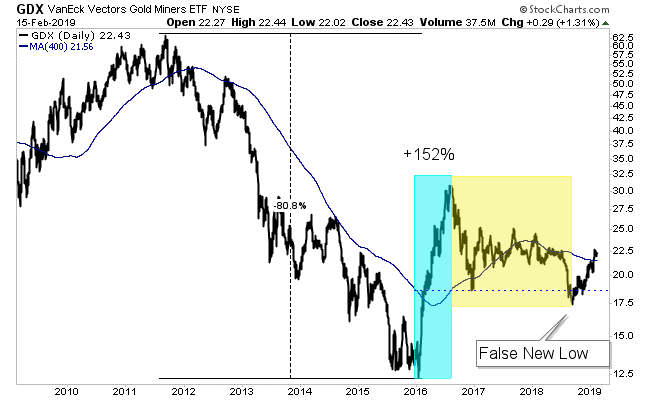
Last week we asked the question whether gold stocks would correct or consolidate in a bullish fashion. The evidence now favors a bullish consolidation. As a result, we are looking at potential near-term upside targets of $1350-$1360 for Gold, $25 for GDX and $37 for GDXJ.
The short-term trend is healthy and this historical comparison is table-pounding bullish. We’ve been increasing our exposure and will continue to do so. Plenty of great values remain and there is time to position yourself to take advantage. To learn what stocks we are buying and think have 3x to 5x potential consider learning more about our premium service.
February 20, 2019
by Jordan Roy-Byrne
The world’s two biggest gold miners both announced mega-mergers over the past 5 months or so. These huge deals briefly garnered some interest in the usually-forgotten gold-stock sector, and fleeting praise from Wall Street analysts. But gold-stock mega-mergers are bad news for gold-miner shareholders on all sides. They reveal the serious struggles of major gold miners, and really retard future upside in their stocks.
For decades the largest gold miners in the world have been Newmont Mining (NEM) and Barrick Gold (ABX). These behemoths have long dwarfed all their peers in operational scope. While the gold miners are in the process of reporting Q4’18 results now, their latest complete set remains Q3’18’s. As after every quarterly earnings season, I analyzed them in depth for the major gold miners of GDX back in mid-November.
The GDX VanEck Vectors Gold Miners ETF is the world’s leading and dominant gold-stock investment vehicle. In Q3 alone NEM and ABX mined a staggering 1286k and 1149k ounces of gold! To put this in perspective, the average of the next 8 largest gold miners rounding out the top 10 was just 508k ounces. Newmont and Barrick have long been in a league of their own, with commensurate market capitalizations.
In mid-November NEM and ABX were worth $17.1b and $14.9b, granting them massive 11.0% and 9.5% weightings within GDX. These two gold giants alone accounted for over 1/5th of GDX! That gives them outsized influence in not only that ETF, but in the entire gold-stock sector. GDX is the sector benchmark of choice for gold stocks these days, so the fortunes of NEM and ABX stocks really affect overall performance.
Gold-mining stocks are generally divided into three tiers based on their production. Anything over 1000k ounces annually is considered a major, which works out to 250k per quarter. NEM and ABX produced so much gold in Q3 they exceeded this threshold by a colossal 5.1x and 4.6x! They are really super-majors. Mid-tier gold miners produce between 300k to 1000k ounces every year, while juniors are under 300k.
Back on September 24th, 2018, Barrick Gold shocked the gold-stock world. It announced it was merging with Randgold (GOLD), which was really an all-stock acquisition of GOLD by ABX worth $6.5b. Barrick shareholders would own 2/3rds of the new combined company, while Randgold’s would own the rest. To avoid confusion, this essay uses the classic ABX and GOLD stock symbols to represent Barrick and Randgold.
ABX had been Barrick’s ticker for decades, but was just recently abandoned on January 2nd. With this mega-merger finished, the new company took over the excellent GOLD symbol going forward. That is a wise decision, as anyone who types “gold” into any brokerage account will see Barrick Gold. Years ago before Randgold got that coveted symbol, another major miner had it and really seemed to benefit from it.
In Q3 Randgold was the 10th-largest gold miner in the world producing 309k ounces. Added on top of Barrick’s 1149k, the new combined 1458k would take back the top-gold-miner crown from Newmont which produced 1286k that quarter. Apparently size matters a lot when you’re a gold-mining executive. But with both ABX and GOLD suffering chronic declining production, that mega-merger reeked of desperation.
Newmont’s leadership wasn’t happy with losing the pole position among global gold miners. So it soon got to work on looking for a mega-merger of its own. On January 14th, NEM announced it was acquiring major miner Goldcorp (GG) in an all-stock deal worth $10.0b! That looked like one-upmanship taking it to Barrick. NEM and GG shareholders would own about 2/3rds and 1/3rd of the new combined colossus.
Goldcorp was the world’s 7th-largest gold miner in Q3’18, producing 503k ounces of gold. Added on to Newmont’s 1286k, that creates a new monster running at an unprecedented 1789k-ounce quarterly rate! If bigger is better, these new combined super-major gold miners ought to be the best seen in history. But unfortunately in gold mining that isn’t true, and these new giants will likely fare worse than if they hadn’t merged.
In their merger announcements, the CEOs of all 4 of these major gold miners tried hard to sell their deals as wonderful news for shareholders. They argued that synergies and cost savings would make these new combined titans more effective at producing superior returns for their shareholders going forward. And as always with any large merger, Wall Street analysts universally applauded these mega-mergers as good.
Sadly the opposite is likely true, these deals are bad news for all the owners of Newmont and Barrick as well as former owners of Goldcorp and Randgold. These new giant super-majors are even bad news for the gold-mining sector as a whole. The odds are really high that their stocks will really underperform the smaller major, mid-tier, and junior gold miners in coming years. That will hurt this entire sector on multiple fronts.
Contrary to their CEOs’ marketing propaganda, none of these four major gold miners approached these deals from positions of strength. They’ve all been struggling with weakening production and rising costs. Gold mines are wasting assets that are constantly depleting, and it is increasingly challenging to find new gold to mine economically at the scale and pace the majors need. These mergers didn’t solve that core problem!
This table looks at the quarterly production, its year-over-year change, and all-in sustaining costs per ounce mined of Barrick, Randgold, Newmont, and Goldcorp during today’s secular gold bull. It started in late Q4’15 out of deep 6.1-year secular lows in gold. Barrick deleted Randgold’s old website, so there is no Q4’15 GOLD data. And as of Wednesday afternoon NEM and GG hadn’t yet reported full Q4’18 results.
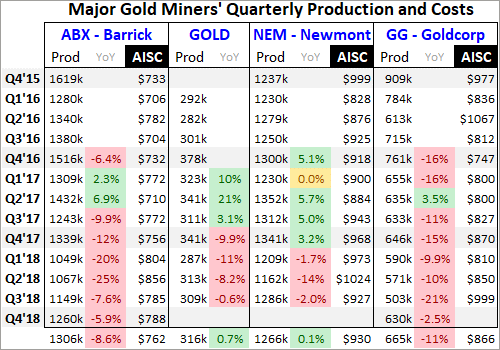
Barrick and Newmont didn’t just effectively dilute their shareholders by 50% for some relatively-meager cost-saving synergies, but because they can’t grow their production internally. ABX’s gold mined each quarter has been falling sharply on balance for years! It has seen brutal YoY drops as high as 25.5%, which ought to be impossible for a world-class gold major. 7 of the last 9 quarters have seen big declines.
Barrick’s average quarterly production since Q4’16 plunged an astounding 8.6% YoY. The reason Barrick’s management blew $6.5b in stock buying Randgold is they desperately needed more production to mask the precipitous drop in their own. Barrick’s total 2018 production of 4525k ounces was 18.0% below the 5516k it mined only a couple years earlier in 2016. At best adding Randgold just regains those losses.
And GOLD has been suffering the same production struggles as ABX. Over its past 4 reported quarters, Randgold’s gold mined has fallen an average of 7.4% YoY. Can bringing two rapidly-depleting major gold miners together magically make a stronger one? I doubt it. Barrick’s reported production will enjoy a big temporary boost for its first four quarters as a merged company, and then waning production will again be unmasked.
While the new giant Barrick will have more capital to develop new gold mines and expand existing ones, it seems unlikely that will be enough to turn this super-major around. Barrick and Randgold operated about 12 and 4 gold mines respectively pre-merger. So bringing another few online in coming years might not move the needle enough to outpace depletion. And it takes over a decade to permit and build new mines.
The entire gold-mining industry has been greatly starved of capital largely since 2013, with 2016 being a modest exception. Thus the big investments necessary to find new large-scale gold deposits and slowly advance them to mine builds have been severely lacking. So this whole industry’s pipeline of new gold to mine has been crippled, all but pinched shut. Declining miners merging does little to solve this problem.
Newmont has fared way better than Barrick in recent years, actually enjoying strong production growth on balance from Q4’16 to Q4’17. But this past year even mighty NEM has started to suffer from waning gold production. It averaged 5.9% YoY declines in the first three quarters of 2018. I suspect NEM is just a little behind ABX in rolling over into depletion outpacing mining growth. ABX’s merger forced NEM to act.
While Goldcorp was long celebrated as the world’s best major gold miner, it has been struggling for years with slowing production. Over the last 9 quarters GG only saw one modest production gain, with its gold mined dropping a colossal 11.0% YoY each quarter on average! So although GG produces about twice as much gold as Randgold, it might be a worse acquisition target due to its faster pace of shrinking production.
Like ABX and GOLD, it’s hard to imagine combining two more weakening majors NEM and GG will yield a way to stop and reverse their falling production. Again for their first four quarters together this new giant Newmont will appear to see big annual production growth. But once that post-merger comparison rolls past, the declining gold across all its mines will again be revealed. Mega-mergers can’t negate mine depletion.
Randgold didn’t even bother reporting industry-standard all-in sustaining costs, which is why they’re not included above. But its cash costs were often on the high side, so it’s likely the new combined company will drag overall mining costs higher. Barrick’s major-leading low AISCs aren’t likely to last with GOLD’s mines thrown in the mix, which means higher costs and lower overall profitability for Barrick going forward.
Newmont should benefit more from Goldcorp’s lower cost structure. NEM averaged $975 AISCs in the first three quarters of 2018, way higher than the $877 average in Q3’18 among the GDX gold miners. GG’s AISCs averaged $886 over that 9-month span, so the new combined Newmont should benefit from lower costs. But that may not last long, as weakening production eventually pushes per-ounce costs higher.
Gold-mining costs are largely fixed quarter after quarter, with actual mining requiring the same levels of infrastructure, equipment, and employees. So slowing production yields fewer ounces to spread mining’s big fixed costs across. If these new super-major gold behemoths can’t arrest their depleting production, their costs will inevitably rise in the future hurting profitability. Again these mega-mergers didn’t solve that problem.
So it looks like the managements of Barrick and Newmont just issued $6.5b and $10.0b of new stock so they could report big merger-driven production surges for a single year! Once those pre- and post-merger year-over-year comparisons pass, the vexing waning-production problems at all four of these predecessor gold miners will again become apparent. But that’s not even the biggest reason these mergers are bad news!
Even before these mergers as apparent in mid-November when I analyzed Q3’18 results, both Newmont and Barrick already had very-large market capitalizations of $17.1b and $14.9b. That again granted them massive 11.0% and 9.5% weightings in GDX. Like most stock indexes and ETFs, GDX’s components are weighted by market cap. Goldcorp and Randgold ranked 6th and 7th then in market cap and weightings.
Adding NEM and GG together as of mid-November would catapult their market cap and GDX weighting to $25.1b and 16.0%. Adding ABX and GOLD together yields a similar $22.3b market cap and 14.5% total GDX weighting. So these two super-majors alone could account for a crazy 30.5% of GDX’s weighting! That is almost scarily concentrated, although we don’t yet know how GDX’s managers will deal with this.
As of this week the new combined Barrick only has an 11.1% GDX weighting, while Newmont is at 8.2% since its mega-merger is not yet consummated. It will be interesting to see whether the new companies’ weightings going forward are kept in market-cap proportion or somehow limited. I hope it’s the latter, as many of the other gold miners in GDX have far-better growth prospects than these new super-majors.
ETF weightings aside, higher market caps create plenty of problems of their own. I’ve written essays in the past on picking great gold stocks, and surprisingly market capitalization is the single most important factor for future gains. The gold stocks with the largest market caps usually significantly underperform their smaller peers. These new super-majors are so darned big that they really compound this problem.
In mid-November when I analyzed the GDX miners’ Q3’18 results, the average market cap of its top 34 component stocks was $4.3b. Excluding NEM and ABX, that fell to $3.5b. It takes proportionally more capital inflows, investors buying shares, to push a larger stock higher than a smaller one. If the super-majors are worth $24b, it takes 6x as much buying of their stocks to drive the same gains as on a $4b company!
Imagine the different forces involved turning a supertanker versus a tugboat. The bigger any stock in the stock markets, the more inertia it has and thus the more capital is needed to overcome that and move the stock. And market-cap issues are not just a size thing in gold stocks. Smaller major, mid-tier, and junior gold miners have way fewer gold mines and much-lower production, which makes it far easier to grow output.
While Newmont is a temporary exception since it was bucking the major trend and growing production in 2017, Barrick, Randgold, and Goldcorp all really underperformed their sector in recent years. This chart looks at the indexed performance in ABX, GOLD, NEM, and GG stocks compared to the leading sector ETFs of GDX and the smaller GDXJ which largely tracks mid-tier gold miners under 1m ounces annually.
Both GDX and GDXJ fell to all-time lows back in mid-January 2016 when this gold-stock bull was born. So all 6 stocks are indexed to 100 as of that day, revealing their relative performance since. Despite their heavy weighting in GDX, the major gold miners generally lag their key sector benchmarks. ABX, GOLD, and GG have really struggled in recent years as their managers failed to stem big production declines.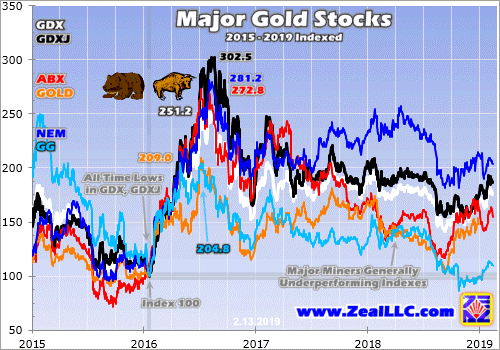
This chart is pretty damning, showing why the managers of Barrick and Newmont are desperate to show rising production even if only for a year after their wildly-expensive mega-mergers. ABX and GOLD have both been really underperforming their peers, scaring investors away while putting serious pressure on managements to turn things around. NEM resisted that, but its production started to decline too in 2018.
And GG has been a basket case, actually managing to fall below its deep secular lows of early 2016 in recent months! That’s a sad fate for what was the world’s best major gold miner for many years. NEM buying this dog is likely to drag down NEM’s stock performance to some midpoint between what it has done and how GG has fared. For the most part the largest gold miners haven’t been good investments.
The much-larger market caps coming from combining struggling majors into super-majors is highly likely to exacerbate this underperformance trend. The new Newmont and Barrick are way bigger and far more ponderous, and will require a lot more share buying to move their stock prices materially higher. But why will most investors even bother to buy these titans when many smaller mid-tier gold miners are thriving?
This next chart adds a single additional mid-tier gold miner to illustrate their outperformance. I chose IAMGOLD (IAG) for this example for a couple reasons. It produced 882k ounces in all of 2018, which makes it a larger mid-tier gold miner nearing that 1000k+ major threshold. And IAG is unremarkable fundamentally. It mined the same 882k ounces in 2017, so there was no production growth at all last year.
And its 2018 all-in sustaining costs are expected to come in on the high side near $1070 per ounce, which is worse than most of the majors. So there’s really nothing special about IAG operationally suggesting it should far outperform. If I wanted to cherry pick, there are other mid-tier miners that have trounced what IAG has done in recent years. Yet even IAG wildly outperformed the majors and sector ETFs during this gold bull.
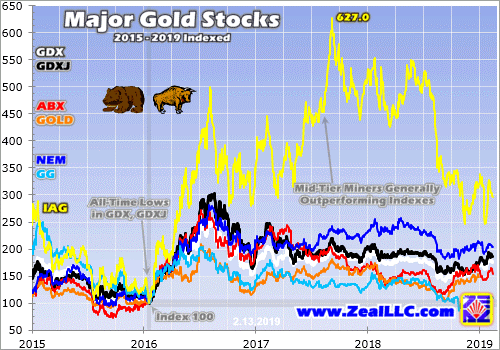
If Newmont and Barrick were the only gold-mining stocks, they’d certainly be worth owning during a secular gold bull. But why own these massive supertanker-like gold miners when smaller major, mid-tier, and junior gold miners’ stocks are performing way better? The smaller miners not only have lower market caps easier to bid higher with much-smaller capital inflows, but plenty also have superior fundamentals.
They tend to have just a few or less gold mines, making it much easier to grow production by expanding existing mines or building new ones. Those expansion events act as major psychological catalysts to get investors interested in those stocks, fueling disproportionally-large buying to catapult them higher. There is really no reason to deploy capital in large majors when mid-tiers are easily running circles around them.
Even if like me you don’t own Newmont or Barrick and have no intention of investing in them, they could cause problems for the entire gold-stock sector. Their hefty GDX weightings mean their stocks have way-outsized influence in how that leading ETF fares. If these super-majors’ giant stocks lag, they are going to retard GDX’s upside which in turn will leave traders less optimistic and more skeptical on gold miners’ outlook.
So mega-market-cap gold miners could significantly slow the overall sentiment shift from bearish back to bullish which is necessary to attract in buying. If capital inflows diminish because of the perception this sector isn’t rallying enough, the bull-market uplegs will unfold slower and maybe end smaller. Even more problematic, the super-majors’ high weightings in GDX suck ETF capital away from more-deserving miners.
Most investors prefer sector ETFs over individual stocks, so lots of capital will flow into GDX as investors get interested in gold stocks again. GDX’s managers have to allocate any differential buying pressure into its underlying component companies in proportion to their weightings. The newly-merged Barrick and Newmont will likely command much-bigger weightings, starving smaller component miners of capital inflows.
But despite these mega-mergers being bad for everyone except the managers of those companies paying themselves huge compensation, all is not gloom and doom. If the new Newmont and Barrick continue to suffer waning production after their initial merger-boost year, investors will shift capital out of them into the other gold miners. That will gradually throttle their market caps and thus weightings in GDX, mitigating damage.
And if these super-majors taint the performance or expected upside in GDX enough, GDXJ may very well usurp it as the gold-stock sector benchmark of choice! While falsely billed as a Junior Gold Miners ETF, GDXJ has really become a mid-tier gold miners’ ETF. It has been increasingly outperforming GDX, and that trend could accelerate since GDXJ will hopefully never include the larger majors led by NEM and ABX.
With so many fundamentally-superior smaller gold miners to pick from, investors have no need to own the larger majors. Plenty of mid-tier miners are still growing their production organically, by expanding their existing mines or building new ones. Their upside as gold continues marching higher in its bull market is enormous, dwarfing what is possible in the giant majors struggling with waning production. Avoid the latter!
One of my important missions at Zeal is relentlessly studying the gold-stock world to uncover the stocks with the greatest upside potential. The trading books in both our weekly and monthly newsletters are currently full of these better gold and silver miners. Most of these trades are relatively new, added in recent months as gold stocks recovered from deep lows. So it’s not too late to get deployed ahead of big gains!
To multiply your wealth in stocks you have to do some homework and stay abreast, which our popular newsletters really help. They explain what’s going on in the markets, why, and how to trade them with specific stocks. Walking the contrarian walk is very profitable. As of Q4, we’ve recommended and realized 1076 newsletter stock trades since 2001. Their average annualized realized gain including all losers is +16.1%! That’s nearly double the long-term stock-market average. Subscribe today for just $12 per issue!
The bottom line is gold-stock mega-mergers are bad news for everyone in this sector. Combining major gold miners already struggling with slowing production doesn’t solve the problem, but only masks it for a single year. The resulting super-majors’ massive market capitalizations saddle their share prices with big inertia. They are going to require much-larger capital inflows to rally materially, really retarding their upside.
Their higher weightings within sector ETFs will lead to worse perceived sector performance, delaying the necessary sentiment shift from bearish back to bullish. And the super-majors will suck up more of the capital allocated to gold-stock ETFs, starving smaller and more-worthy gold miners of buying. Thankfully some of these problems can be avoided by shunning Newmont and Barrick, and sticking with great mid-tier miners.
Adam Hamilton, CPA
February 19, 2019
Copyright 2000 – 2019 Zeal LLC (www.ZealLLC.com)
Executive Chairman Ivan Bebek and his team at Auryn Resources have already built and sold two successful exploration companies. But now they are convinced that they are on the cusp of two potential world-class discoveries that will far exceed their previous successes. In this interview, Ivan shares how Auryn assembled a top-notch technical and management team who have been able to locate and now pursue what they believe could turn out to be massive discoveries at their Committee Bay project in the Arctic and at their Sombrero property in Peru. Ivan discusses in detail not only the prospective nature of these projects, but also how he plans to fund up to four years of aggressive exploration with no shareholder dilution. Auryn Resources will see steady news flow throughout 2019, so this is an exploration story worth following.
Bill: Welcome back, and thanks for tuning into another Mining Stock Education episode. I’m Bill Powers your host. Joining me today is Ivan Bebek, executive chairman of Auryn Resources. Auryn is currently looking at numerous potential catalysts in 2019, so this is a story that you’ll definitely want to pay attention to. Auryn trades on the TSX and NYSE American under the ticker AUG. Fully diluted the company has under 97 million shares out with a current market cap of a little under US$100 million. So with that being said, Ivan, welcome to the podcast.
Ivan: Thank you so much. Pleasure to be here.
Bill: Ivan, as you know, we were able to meet in person at Minds and Money Toronto last October and we talked, it was supposed to be for 25 minutes, we ended up speaking for an hour and 15 minutes. And during the course of that conversation, we talked about one of your key projects, Sombrero, and you really got me excited by just the confidence and the belief that you’re onto something world class here. You’ve already built and sold two successful mining companies. I’d like to start off with you sharing regarding the anatomy of making a world class discovery. What does it take? You’ve done it twice, but this one seems to be even bigger with Auryn right now. What does it take to put together a team that can really pursue a world class discovery?
Ivan: Well thank you very much for having me on here, it was nice to meet you back in Toronto. So the anatomy of a team, it sounds easy once it’s done, but it’s actually not. We’ve been working together as a group for 13 years. My partner Shawn Wallace and myself, we started Keegan, we found 5 million ounces of gold in Ghana, West Africa that’s producing 10 million ounce gold mine. We did that with a really small team and we did that as our inaugural company to prove ourselves. We evolved as we went along, as you would, and I would say the main ingredient of creating a great team is success. And so finding 5 million ounces of gold was the first success.
We then poured into another exploration opportunity and we tried to improve on what we did with Keegan and expand that team and that’s where we came up with Cayden and where we sold it to Agnico Eagle for $205 million in 2014. Both share prices performed extremely well for shareholders. The first company went from $.49 to $9 per share. The second one went from $.67 a year before the takeout, to a $3.50 takeout share price, which doubled if you held shares Agnico for 14 months later.
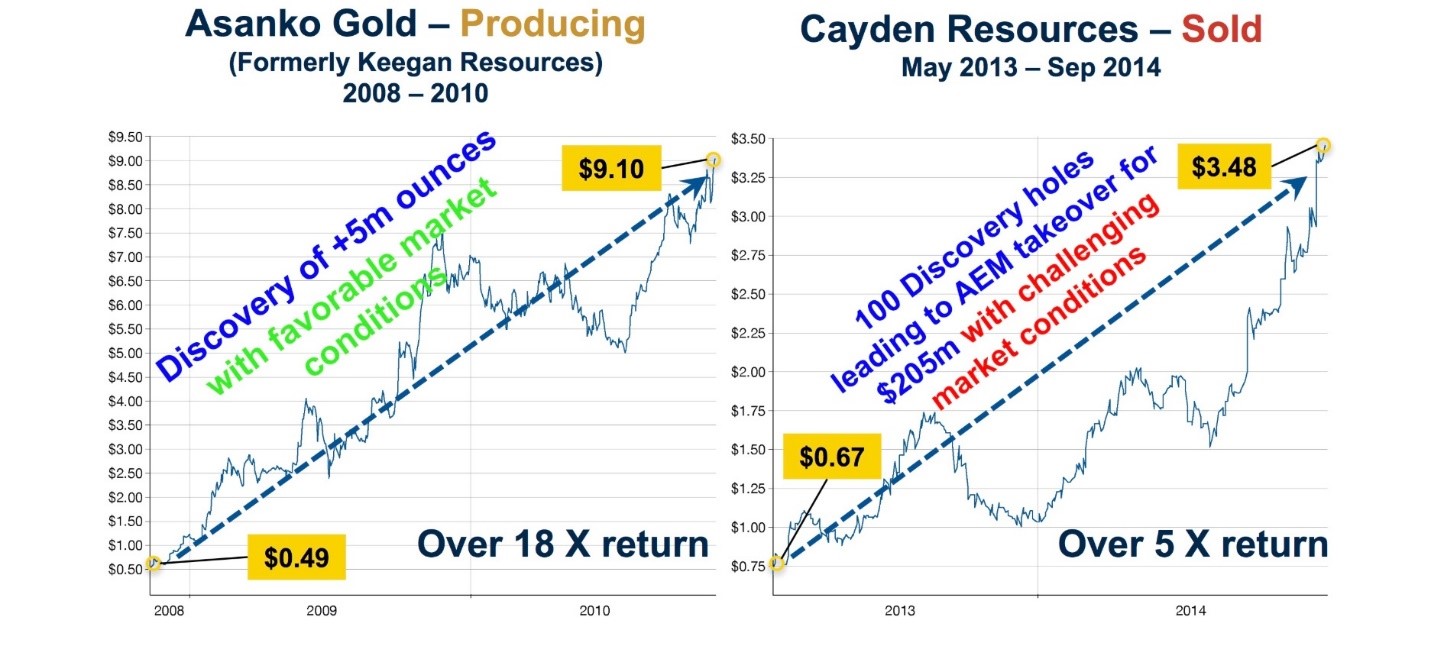
So not only did we attract a lot of these really high-quality geologists, Dan McCoy, who is our key geologists that brought us into Keegan and Cayden’s assets, he’s the gentleman who recruited these Newmont gentlemen, Michael Hendrickson and Dave Smithson and are leading the charge for Auryn. So we had technical success. We impressed our own geologists with our financial capabilities and then we had market success, which gave us the ability to raise a lot of money which being over $600 million since 2005 in combined good and bad markets, which is a fairly impressive number if you followed the last decade of mining stocks and whatnot.
So that comes down to how we came together with Auryn and how this anatomy of going after these major world-class discovery exists. And this is where we took him,. The gentlemen Dave Smithson and Michael Hendrickson, both from Newmont, Michael Hendrickson was a former structural geologist, Dave was the former global mapper. They were imperative on the Cayden sale. These gentlemen brought a bunch of world experts from Newmont, including the former chief geologist of Newmont, Antonio Arribas, who’s on our board, Antonio was also the VP of Geosciences for BHP, a $140 billion base metal company today. Anyway, these guys brought in some of these world experts; about six in particular, They all have different expertise, different backgrounds. So it’s not one geologist that’s doing every element of the science is each guy has done his own science as an expert and they work together as a team.

They found several million ounces for Newmont. They were imperative in our success and Cayden. And when we assembled Auryn we went out and said, “Hey guys, we want to do something bigger than we’ve done before. Five million ounces is great. It made people a lot of money, but we want to have a 10, 20 million ounce discovery or two on our belt and let’s go shopping. Let’s go do this. We have a lot of wind behind our back from Cayden and we’ve made a lot of people money, our ability to raise money is incredible.” And then we had went out and we built a seven project portfolio in Auryn. So first major part of the anatomy is technical team. We earned that through our successes of our first two companies.
Second major part is the portfolio project and if you remember 2014 when we put Auryn together and started to assemble the company, we went out and acquired stuff that was worth pennies on the dollar. We bought Committee Bay for $18 million. It cost us 13 million shares. That company used to trade at a $200 million valuation as North Country Gold in the last bull market. So these are the kinds of asset buys we were doing and we were buying major district opportunities, large scale, that’s a 300 kilometer long gold belt. And then in that process we met a guy named Miguel Cardozo. Miguel Cardozo is part of our team. He runs our Peruvian operations. Miguel’s credited with the discovery of Yanacocha as a gold deposit when he worked with Newmont in Peru. That’s a 60 million ounce epithermal discovery in Peru that he made where he led the charge of.
So this is kind of the people we got to work with. This is kind of the outlook we went and took on and what we internally described ourselves as intelligently as a junior exploration company with a majors’ exploration team and a majors’ exploration appetite. And so fast forward a few years, we’ve obviously raised quite a bit of money for Auryn, about $100 million to date. Along that path we met Goldcorp and Goldcorp recognized the scale of some of these gold projects and copper gold now with Sombrero coming online, and they came in and gave us $36 million dollars, which was the largest investment by a major into a junior in the entire market I think in the last 20 years as initial investment. So that was a tremendous validation to what we’ve assembled, and we’re now at the pinnacle of two massive discoveries. One being potentially at Committee Bay and the other one down being at Sombrero. And the way I’ve been describing this for the investing audience is I believe as an investor and as an executive with bias because it’s our company, but I’m still looking for something on the planet that rivals the exploration potential both in Sombrero and Committee Bay and I have not found it yet. So I think categorically these are two of the biggest exploration swings you can take as an investors, as an executive right now in the business.
Bill: So you’ve been in this business for 20 years, would you say that Sombrero ranks right at the top?
Ivan: I’d say by far, I’ve seen things as an investor, I got to be a shareholder an Aurelian, that was a tremendous discovery in Ecuador. I was a shareholder in Red Back mining, which was the discovery in Mauritania, that 30 million ounce deposit over in Africa. Looking at Sombrero pre drilling, we’re comparing it as an analog and the video on our website does a very good job of doing that to a mine called Las Bambas. Las Bambas is about equivalent of 50 million ounces of gold or $60 billion of metal. It’s copper-moly, we’re copper-gold, and that’s obviously a better factor for us, but the scale of what we’re exploring there it rivals the Las Bambas deposit in size and the more we look, and the more layers of data we take, the more confidence we have that we might be onto a big system like that. And it’s never been drilled before, the evidence is really, really strong and we’re continually signing (confidentiality agreements) on it, something I haven’t talked too much about, but several of the major mining companies around the world have come to us to sign confidentiality agreements so they could get a really close look at this before we start drilling it later this summer.
Bill: An astute investor is going to listen to us talk about the potential and they might ask themselves, well, if the potential is so great, how did MMG or BHP and some others in the region miss this opportunity? And what would be your response to such an investor?
Ivan: Well, my response would be the facts. I think about six different major companies, including the ones you have mentioned have walked on this property before and have taken a look. The first miss, and everyone’s recognizing this across that crowd because all of them have come back to sign confidentiality agreements and there’s obviously dialogue about why they missed it. The government actually mapped the volcanic rocks which cover most of the outcropping mineralizations covered by volcanic rocks. It was mapped at a very young age, that a lot of people didn’t believe would host the deposits next door, people were in a box in this part of Peru, there’s not just Las Bambas, there’s about five major copper-moly porphyries next door within 50 to 200 kilometers away, this major belt. We believe this is the extension of the belt, we believe it was missed because there’s volcanic rocks that cover a lot of the potential mineralization. People thought it was young.
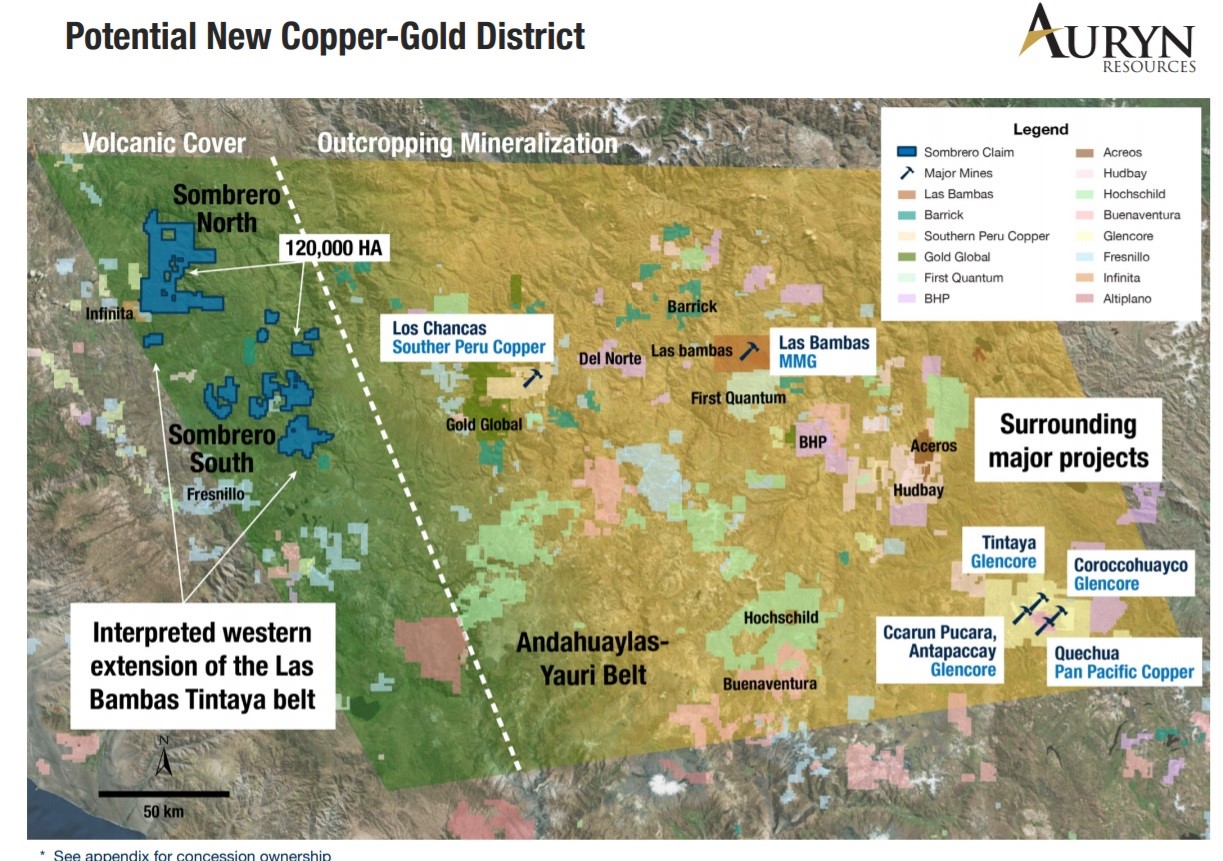
We are the first ever people to pull trenches on Sombrero. We got to pull back the cover, we got to pull back the gravels and we got to sample, one of those trenches ran 109 meters of .7% CuEq. That trench has gaps in it and we just gave ourselves zero in that calculation because we couldn’t sample the whole entire trench, but part of the trench ran 30 meters of 1.93% copper, which is spectacular. What’s even more impressive about that is that we’re trenching in the world of copper, gold porphyries, high grade copper-gold over 100 plus meters width. And that’s truly spectacular. So the guy’s like possibly MMG or BHP or any of the others that have missed this, had they seen these trenches that we’ve been pulling, we’ve got another 150 meters of a half a percent copper gold in another area. We got gold grades on surface up to a 193 grams per ton. We have copper up to 16%. There’s a tremendous metal budget here, there’s plus hundred meter widths of really, really high grade copper and gold being sampled by us. Nobody would have ignored any of this and that’s why everyone’s come to sign CA’s.
The crowd has definitely shifted and our geologists said we went outside the box and I’m going to quote Dave Smithson in here actually, his comment was, “We first came here and nobody liked it because they saw gold but they were looking for copper and we saw hill side on our second visit called “Good Lucky”. You could see on our website or in our presentation a really beautiful section of a hill where river cut a canyon and you could see mining at it in the side of the hill where they were mining high grade copper halfway down a 400 meter cliff. And then we went down to the bottom, we see bornite, which is high grade copper, huge metal for high grade copper if you know the copper world. But people were looking for copper and they were focusing on this project, considering it to possibly be a gold rich project, and obviously that changed dramatically for us and it’s been basically every visit we’ve done on the property since things have gotten better, we found more outcropping mineralization, we found sampled more high grade and a lot of other elements that are really giving us a strong indication this could be a major copper gold system.
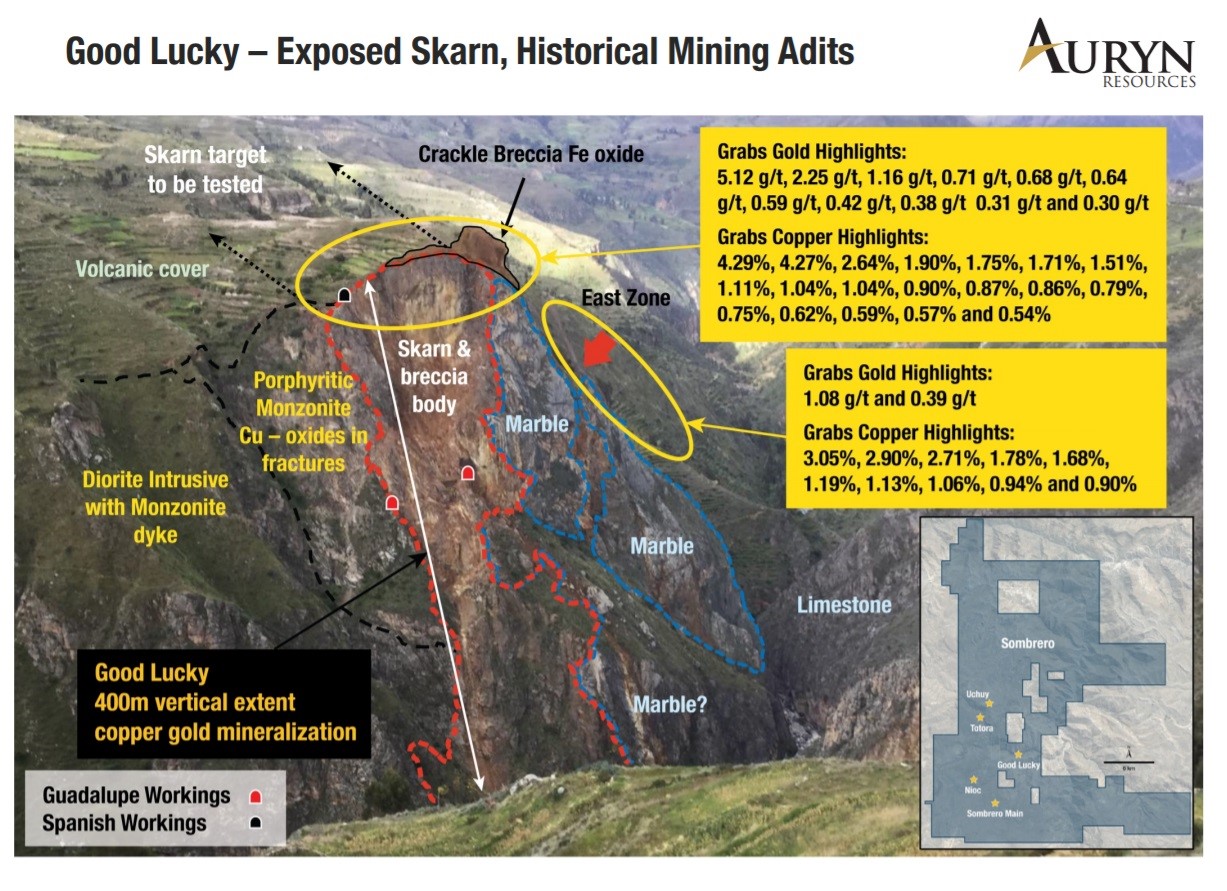
Bill: And after you discovered a lot of these excellent surface results, then you massively increased your land package. Can you talk about that?
Ivan: Yes. So we started with about 5,000 hectors, we got the project from Miguel Cardozo, the gentleman who found Yanacocha as a gold deposit. And we quickly got excited about it because we found copper gold at the edges of our property boundary. So we did what any smart, intelligent, aggressive junior would do, and we start staking ground all around us. We got to about 40,000 hectare land position through the staking. And then our guys, Michael Hendrickson and Dave Smithson, they turned and said, “Hey guys we have this very special way of sampling streams at the bottom of canyons to determine if there’s gold or copper or other metals running off the rocks that are predominantly covered. Can we go screen 8,000 square kilometers?
Jaw drops, that first 8,000 square kilometers, that’s a lot of screening. How much is this going to cost? It costs us about probably about US$700,000 to do this. Obviously we were well financed when we chose to do this, and then we increased our land position to 120,000 hectors. We did this for two reasons, one, first and foremost, because if we got Sombrero right and if this belt continues, that host some of the world’s largest copper porphyry deposits, we want to have as much of that as possible. And the second reason why we did it was we knew when we got on Sombero, everyone’s going to come if we start pulling hundred meter plus trenches of mineralization, which is exactly what’s happened as of now. So we wanted to be first. We were. We wanted to be greedy and we wanted to have the potential, not for one Las Bambas or Tintaya, we wanted multiple of those type of discoveries to be in our land position for the next decade of discoveries. And I believe we’d given ourselves the perfect shot. We got everything we wanted and now we’re comfortable to sign CA’s and let the big guys come in and take a look.
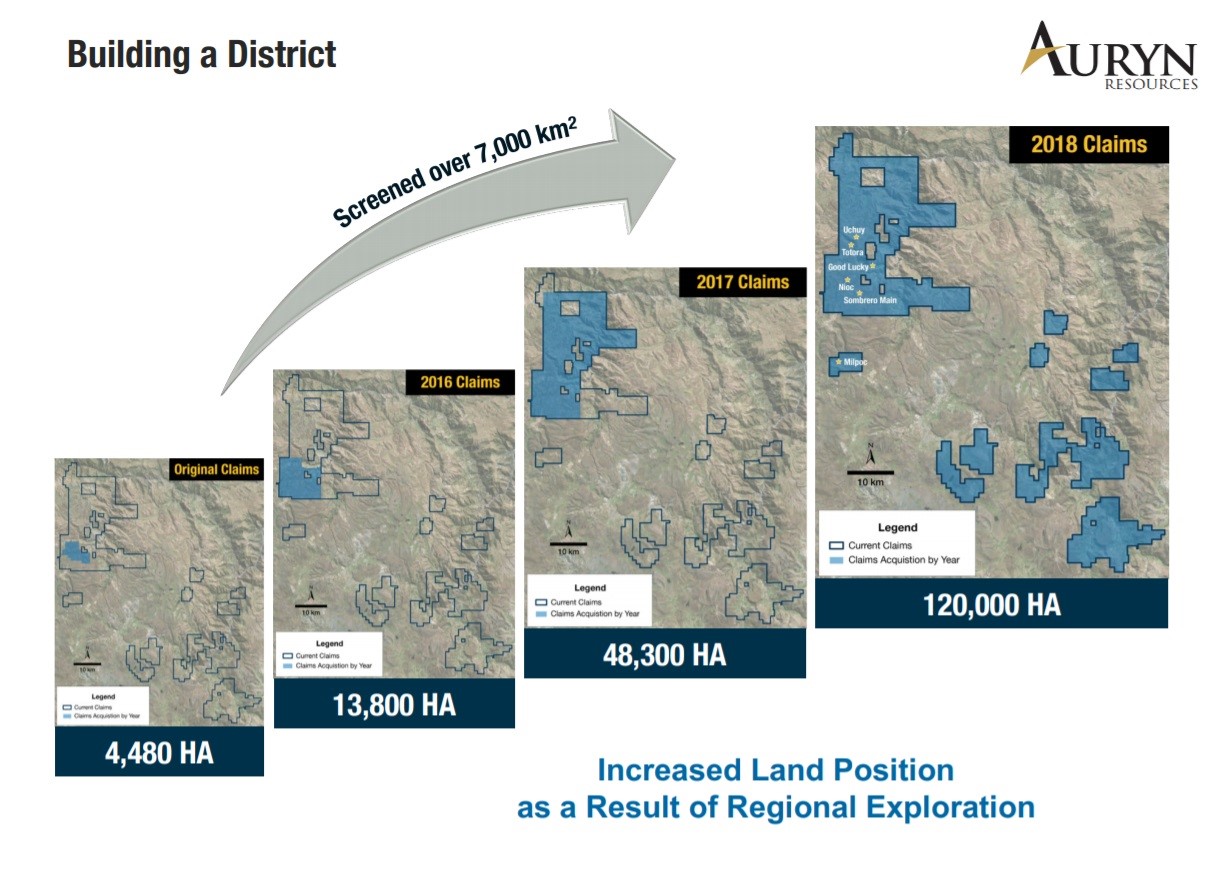
Bill: What is it going to cost to drill this project this year? Can you talk any more about the targets you have and the timeline that investors should look to this year?
Ivan: Yeah. So a couple things, right now we’re in the permitting phase, we’ve applied for 40 drill pads, which gives you a lot more room than the typical 20 you get in an initial permit, it takes a couple more months to get this permit but like I said, we’re in process, we are well on the way, we expect it June/July of this year. It can take a month or two longer, you never know. But right now we’re on track. We don’t see any foreseeable delays.
We’re going to drill 15,000 meters, is our plan on our first path, that will cost us about $5 million Canadian to do that first path of drilling, not a huge cost, we don’t have to worry about having money for that until we get permits later this summer. We’re about to resume trenching, we’ve only trenched and sampled one of five major centers that could be standalone flagship company making assets. So we’re about to get our trenching resuming to go on trench number two, number three, number four, number five, so by the time we’re actually drilling, we will have had five major centers all sampled, ready for permitting and drilling.
And so we’ve got our hands full, we’re going to have a lot of news for the market in terms of trenching these new areas. You kind of have to listen to the punchline, we’re comparing ourselves to Las Bambas and were saying that this thing could be as big as Las Bambas and we’re only on the first of five major targets, so we’re going to be following that up here quite shortly with trenching to show a bunch more things that could also be big discoveries like that. So perfect case from an exploration investor’s perspective, you’re waiting for drill permits while you keep adding more huge targets to the equation.
Bill: What about your relationship with the indigenous people and is there any infrastructure nearby?
Ivan: Yes. So a couple of things there. The local communities we took our time with them, we are under the guidance of Peruvians, Miguel Cardozo’s managing them. Instead of rushing, trying to get the drill bit out, we built really strong relations, took us about a year for the first major community agreement and that one’s been working out really well since we’ve done that. The second one has taken us just over two years and we’re just collecting signatures now, so it’s in the phase of being complete.
I’ll say one comment about Peru and communities, this is one of the major risks that can come up for any company that’s operating there, we came into Peru with a different project and the first thing we did before we took any samples off the ground was bringing a million dollar water program to bring water and irrigation to their fields. We spend about $240,000 over four years and then we brought in an NGO to come in and pick up the balance to do that. So what I heard when we first got to Peru and what we heard as a team was the people who came in the last bull market came and gave everybody money, but they left and there was no sustainability factor. Money was spent and communities, we’re a little bit upset in some areas of Peru.
So our theme as a group, as action before words. So we come in there and we started doing things for the communities before we start talking and making promises and stuff like that along the lines of what we will do. And so we’ve covered that part incredibly well. The second part of your question was asking me about the infrastructure. Since we’ve had the Sombrero project, and we like to think the government was foreshadowing the discovery because they built high tension power lines over the edge of our property. We have power for a major mine at our project. There are roads right into the project. There are two towns with about 800 people peripheral to the project, not on top of it, nobody has to be moved but nearby where we’d have a local workforce. We’re only at 3,900 meters elevation. People mine up to 5,500 meters elevation in the Andes. And so it’s reasonable an elevation, you have a road to the project, you have a power source which generally is a major cost factor.
So we have to think about, when I say all of those things, to answer your question, it’s profitability. Couldn’t be a better scenario. The only thing that could improve this would be a railway and if you go and google “Las Bambas railway”, you see there’s a lot of talk about one that’s nearly approved to be built from Las Bambas and all these other major nearby mines to the coast, which would be a tremendous add onto us. It’d be perfect infrastructure from all aspects.
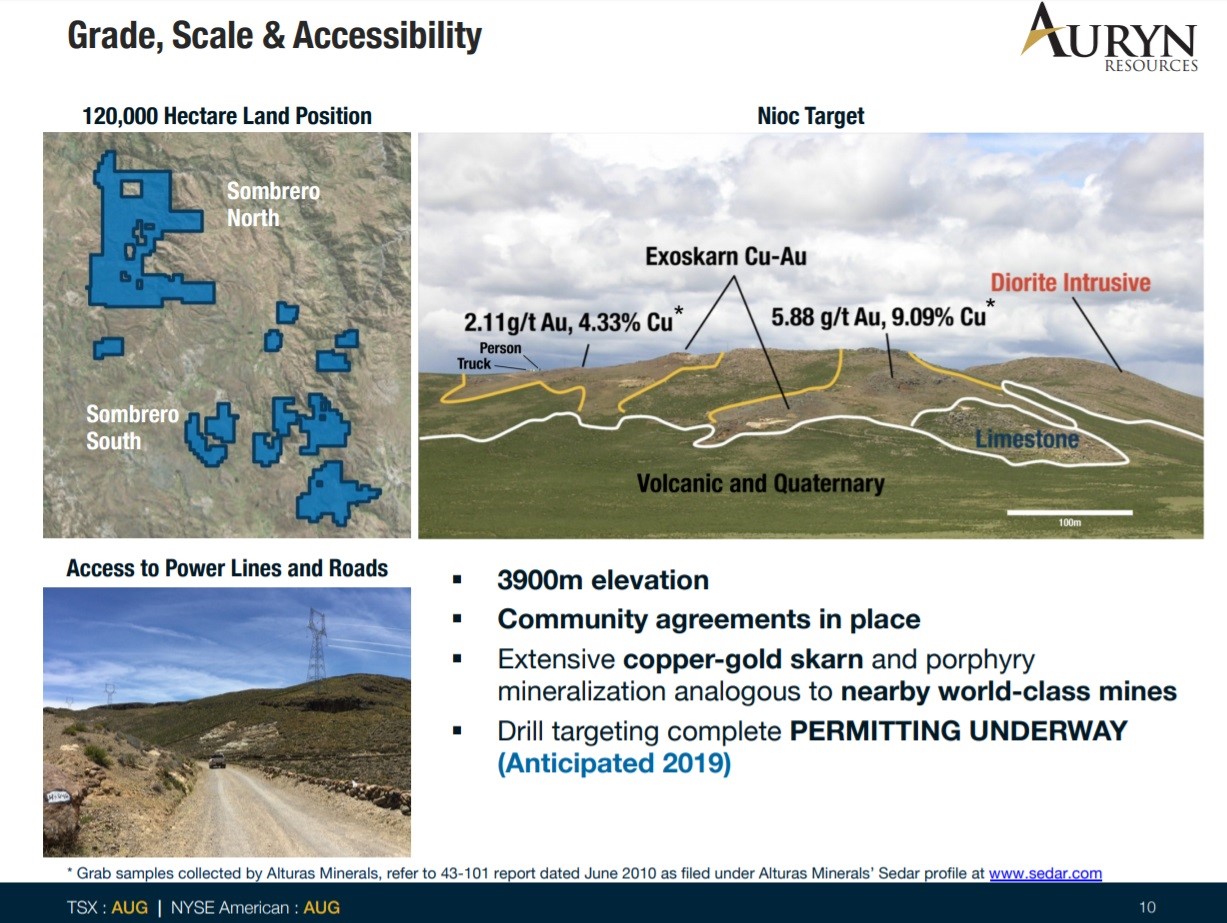
Bill: You had told me back in October that you plan to aggressively pursue Sombrero as well as Committee Bay, which we haven’t spoken about yet, but how do you expect to fund this program?
Ivan: Yeah. So were we had $2 million in January last month, is how we started the year. That will take us into May before we need any more money. If you listen to me or any of my colleagues on the road right now, we’re not looking money, we’re going to be marketing our company to create awareness about the opportunity. And sharing the trenching and about the Committee Bay, which we’ll talk about in a minute. But we’re not looking for money because we have seven projects, two of them we’ve been very public about, are ones we’d consider selling if we got the right prices for them. And one of them is two years into the negotiation, the other one’s about a year and a half, so we’re at very mature stages of potentially one of these two things happening before we have to say the word “financing” again.
Conservatively, one of them would give us one year of drilling and working capital, is what we anticipate. If we sell the other one, we might end up with a combination of about four years of aggressive drilling and working capital to go out there and not have to say the word “financing” for four years would truly be spectacular for us with these kind of big projects on the deck.
Bill: If you were to sell both of them in the near term, what do you think that would do to your market capitalization?
Ivan: Oh, well, 90 million shares out issued and outstanding, the price I would speculate we net would probably be about 70 or eighty cents per share in cash, which can give you about $40 million for two of the biggest exploration swings globally, Committee Bay and Sombrero. I think there’d be a dramatic re rate on us, there’s a value to speculation about what you might drill. We saw a market cap of $250 million twice before we went to drill Committee Bay, which we haven’t even talked about yet. Now we have Sombrero online as well. Multiple projects takes away the risk, the obvious nature of the mineralization at Sombrero is going to allow people to speculate pretty aggressively. What would you pay in terms of share price as an investor to have a seat at a table where you’re taking a $60 billion swing? Finding a ball of metal in the ground with tons of indicators, big company signing CA’s, third party validations all over the place. What would you be wanting to pay if you might find something worth that much money?
Las Bambas was sold for $8 billion back in 2014, the same year we sold Cayden so middle of the bear market. I believe $6 billion was the metal content of a $60 billion ball of metal in the ground. So we have 90 million shares out, we have about $100 million market cap, we’re looking to raise about $60 to $70 million net of taxes from asset sales. I think you’d see much more than a double before we went drilling. That would be my speculation with the ability to drill for three or four years without saying the word “financing” in a rising commodity market, it would be spectacular
Bill: And if the sales didn’t go through, I know there’s a newsletter writer that I follow and he recommends your company just for the fact that you’re able to raise money easily.
Ivan: Yeah. So we’ve raised $600 million. As an insider in the public markets, I’ve bought 3.2 million dollars of Auryn shares in the last three and a half years, as high as $3.70 Canadian per share and as low as a $1.15 per share Canadian. My point there is not only do we have the ability to write a check into our own company and we’ve obviously done that, we have a tremendous following with investors. We’ve made a lot of money over the years. The money we need for one year of drilling both projects and working capital is probably around $15 million Canadian and we could get that this week if we wanted it. But we are extremely anti-dilutive. We are a very large shareholders, we own 15 percent of our company and we treat our company as investors would want to treat their own company in terms of dilution and financing.
So in that equation, with the ability to write our own checks into our own company, gives us a tremendous opportunity here to really deliver a very robust share price return by staying away from the market, from financings. If those assets sales take longer, that’s the consequence I think, not happening but they’ll happen eventually, then we would likely do a really small funding, a non-brokered private placement for $5 million which would cover trenching in Peru and G&A so that we could wait for better metal prices to get more out of those transactions. But to be honest, we’re sitting here in February, I’m marketing all month, we’re going to PDAC, we’re marketing in Europe and everything we’re doing, it doesn’t have the word “financing” attached to it. It’s just creating awareness on the opportunities that Sombrero and round five up at Committee Bay.
Bill: I was watching your share price movement and right after the Vancouver conferences in January, you saw a nice spike.
Ivan: Yeah, that’s just the crowds, we had just started talking about Sombrero. Vancouver two weeks ago was week one, we were just in California for a week, we’re in Florida next week, we are going to go through our global network and being around this business and as a group for about 13 years, we have a lot of investors to show how big the opportunities are at Sombrero and how mature we’re getting with the potential discovery at Committee Bay, underpinned with two potential asset sales that are nearly imminent to take place. So that’s what we’re excited about, that’s why we’re going out there and truly out of everything I’ve seen in 20 years, Sombrero is number one on my list and I’m going to tell the whole world about it because everybody should, who has ever bought an exploration stock should be watching the story.
Bill: Your other flagship project is Committee Bay, you’ve been at that project for four years and you’ve spent $50 million on it. What can we expect in 2019 with this project?
Ivan: So great question came up to me the other day and the question actually was you’ve been there for four years, you spent over $50 million dollars, I believe we’ve drilled over 250 holes on the project, we’ve taken over 400,000 till samples along a 300 kilometer long belt, which has gold shedding on one side to the other. And so that all being said, that’s a lot of work, where is the deposit? And you guys have the Newmont exploration team, how come you’ve spent all this money and haven’t found it? In the middle of the belt, there is a deposit, 1.3 million ounces of about eight grams per ton, but the belt is covered 95 percent by till, the whole belt is covered by till meaning there’s five to 40 meters of dirt on top of the rocks and you’re up in the Arctic, so glaciers have moved over these rocks or the dirt on the rocks. It’s not easy to find these things or we would have never been able to acquire it ourselves.
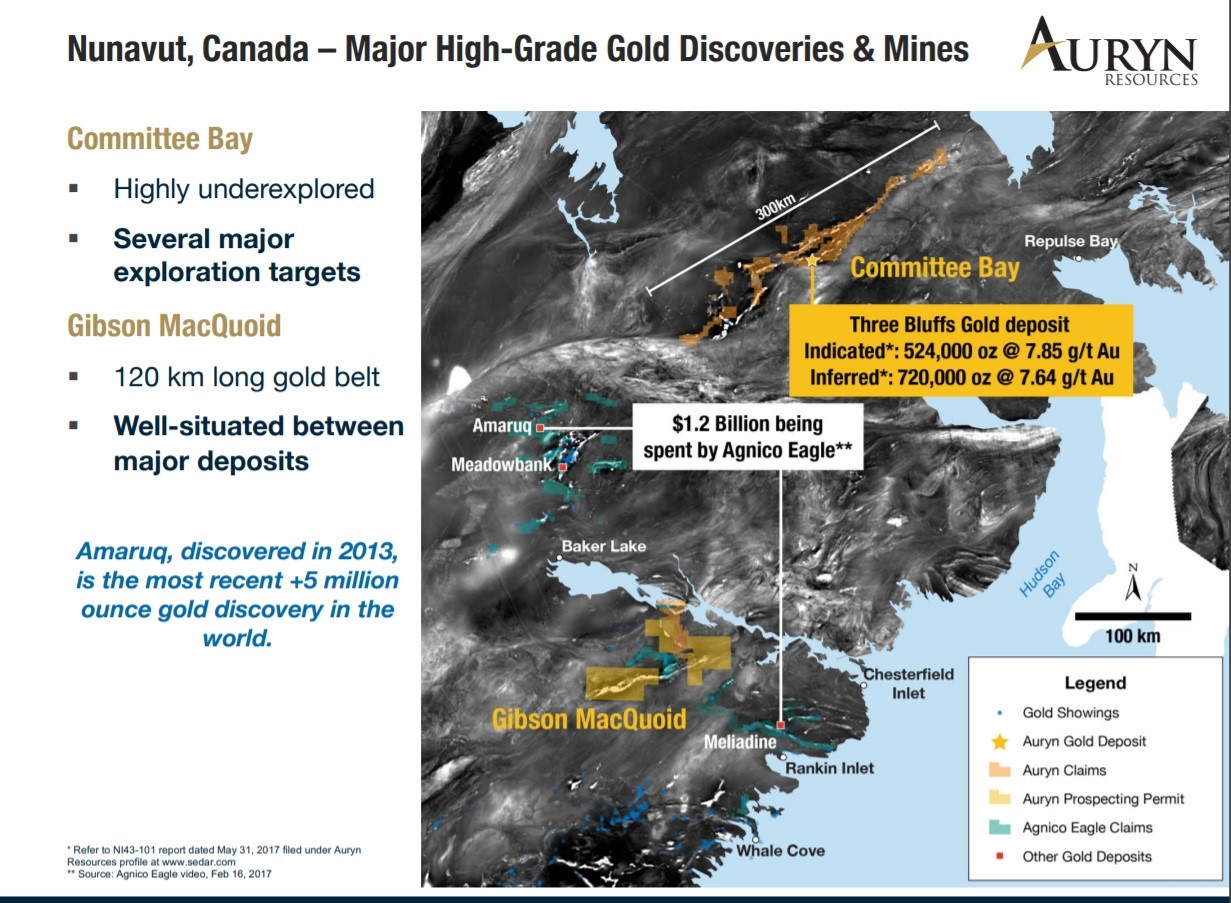
The comment I got was when you guys walk away from this project, and most certainly wouldn’t do it for another five or ten years because you have 18 targets along this big belt to go test, which is going to take time. Where the guys are at now is they’ve brought in machine learning to process all that data on the entire belt. And one of our Newmont geologists has met up or partnered up with a technical specialists, we’ve had a press release about this and it’s truly amazing what they’ve done. And first of all, the data inputs are extremely high quality of the way we take samples, the way we assay samples, the world experts formerly with Newmont that are inputting the data. So data in data out is obviously a major contributor.
The neural networks these guys are using is the same one google uses as Amazon, Facebook. And if you ever had the experience where you’re on their website, you’re looking at boats or something or tennis rackets or whatever sport you play, or you say it even out loud now you don’t even have to go look at it, and then you get some random marketing email that shows you a bunch of product for sale that you were thinking about or talking about. So imagine that exact same neural network which has been used by google, now you’re putting in geoscientific data. We took three bluffs the deposit, we gave it one third of the high grade at three bluffs and we taught it how to find in that. And then we challenge it to find the other two thirds. And it came out with about a 99 percent accuracy finding the other two thirds.
So in my opinion, it works. In about three weeks, the end of this month, end of February we’re going to have the results of the learning, which is gonna show targets that we’re going to drill this to Committee Bay alongside targets that our geologists have found. But truly the future of major discoveries is either hidden deposits or it is things like Sombrero that were overlooked or it’s contentious land owners that wouldn’t sell to an exploration company prior that finally sell. And I think if you listen to Barrick, Teck and Goldcorp and a lot of these big companies, everyone’s talking about AI platforms coming into mining and the true reason why is the computer that we’re using are the neural network and the ability for it to process data is about a thousand times the capacity of the human brain. So you’re basically saving 20 years of crunching numbers by doing it through a computer in a period of three to six months, and that’s the opportunity there.
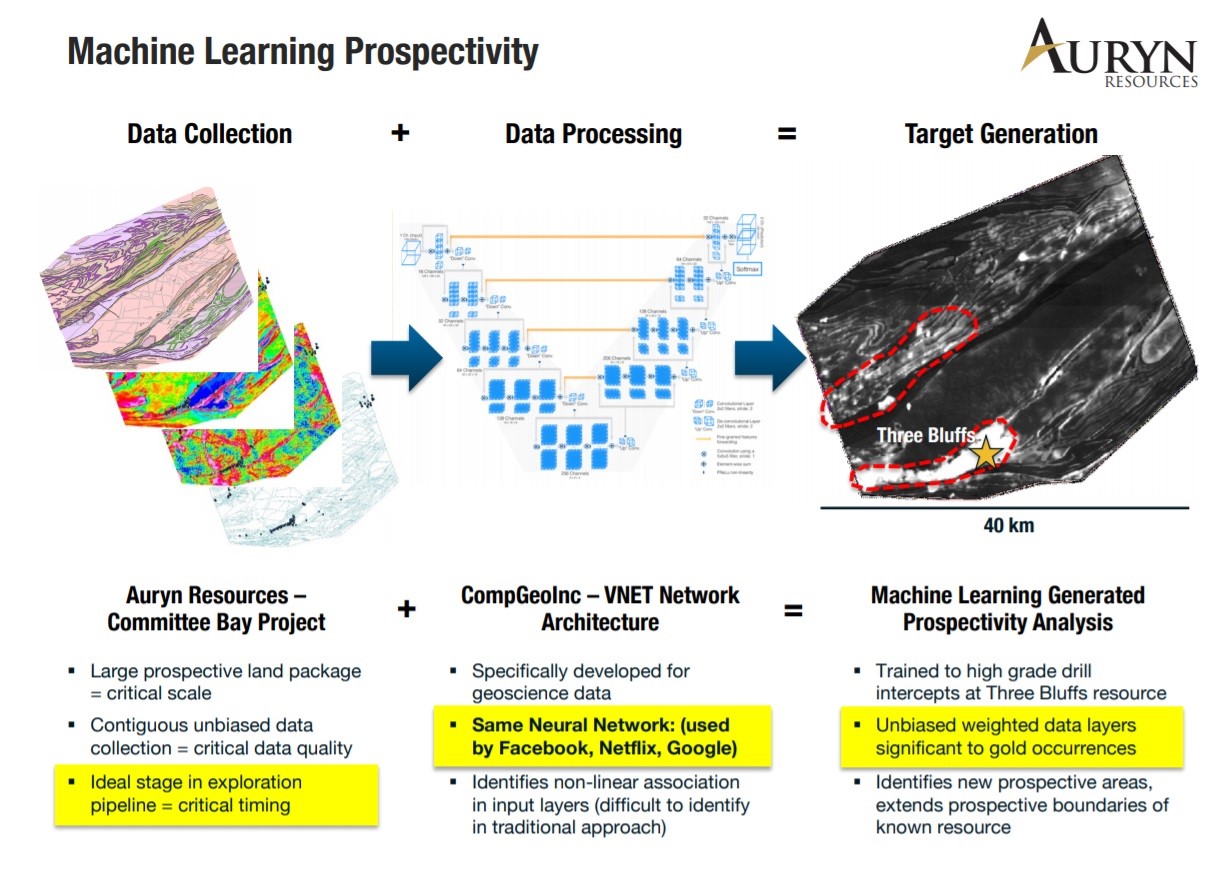
The last comment I’ll make on Committee Bay, and this is for all the Committee Bay shareholders that have owned us, that have sold us, that have speculated with us and that can’t get enough of risking their money for Committee Bay discovery, we’ve only physically been on the ground at Committee Bay for about eight and a half months, and so we’ve drilled 250 holes, we’ve taken 400,000 till samples in eight and a half months of physically being on a property and in comparison to Sombrero where we’d been on the ground physically for about 11 months, you have to take that into context of how little time we’ve actually spent at Committee Bay.
And the reason why is we spent about two months at windows of exploration each summer, we’re not exploring through the winter, you could in the right environment of a discovery, you could drill year round. Agnico Eagle’s doing it on this major mine they found next door called Amaruq, but for us, we’ve only been on the ground for about eight and a half months since we’ve had it. We’ve collected all this data and the real discoveries are going to come out of Committee Bay, we think this season. Not only because we’ve learned so much about these deposits we’ve been going after and we feel we’re on the edge of some major discoveries, but we brought in the computer to process all that data that I’ve told you that we’ve just collected.
It’s going to be one of the most exciting drill programs that I’ve been part of with Committee Bay, but also to go test the computer learning, if it’s right, the whole belt opens up again, you have 300 kilometers of gold shedding off a belt. It becomes one of the phenomes in the world to go find major gold deposits and to quantify how hard these deposits are to find too, in those four years that we’ve been going up there so far, nobody else has found a 5 million ounce or better gold deposit. The last major mine in the world found that’s over 5 million ounces of gold is Amaruq, 6 million ounces of six grams per ton, which was found by Agnico Eagle right next to us at that Committee Bay. Nobody has found anything since 2013 of consequences in the gold side of the business that’s being explored. We’re not the only ones, but I’d liked to argue we have some of the best real estate for high grade gold in Canada and a massive copper-gold discovery in potentially in Peru.
Bill: Yeah. And it balances the portfolio, there’s going to be news flow constantly in the years to come.
Ivan: Yeah. So news flow is a main catalyst for all juniors and what we’re looking at for news flow here is the releasing of the AI targeting, Committee Bay targeting, as well as the resuming of trenching in Peru. Those would be two main drivers that drive a lot of speculation towards the summer, but you might see the first asset sale in the coming weeks or month or two. And the second one might be right behind it or they might happen both at the same time.
If you see the gold price performing, expect the asset sales to happen probably a lot quicker. If the gold price goes down, they might take longer, that’s the only way I would say you can wager how long these things might take. But, again, we’re in the very mature discussions of these asset sales and we’re confident that one or both could happen this year.
Bill: Ivan, Rick Rule always teaches speculators that they need to know at least three things that could go wrong with a gold speculative company that’s pursuing a discovery. So the question posed to you as the executive chairman would be, what would keep you up at night? When you look at the company and you look at your projects, what are some things that could go wrong?
Ivan: That’s a really great question, and I’ve had the chance to meet Rick in 2003 and get to know him for the last 15, 16 years. The first answer to that question would be communities in Peru, that’s the obvious one, that’s the easy one. We have a really good handle on that as I’ve been quite elaborate about that and I don’t think there’s any serious risks there at all, but that’s one of the big red flags that someone could throw out and lose little sleep at night.
Second one would be metal prices. We don’t need higher metal prices than today, but if the metal prices go into a massive tailspin, then that would obviously slow us down and we would be conservative with our spend and we wouldn’t get to go drill as quickly as we wanted to because we wouldn’t want to dilute ourselves in that process.
And thirdly, you’ve asked me for three, I’d have to go onto personnel. You don’t want to lose any geologists to something tragic or something else. We have incredible people on our team and I think if we lost part of our technical team somehow that would be something we could recover and repair, but it would be the other thing I don’t want anything to happen to anybody on a personal basis. There’s no danger in where we’re working, but life is interesting enough in itself, there’s airplanes, there’s all kinds of things that can happen. It was such a remarkable feat for us to put together this group of people as a team. It was such a remarkable feat to put together this portfolio of projects and we don’t want to lose anyone, so those are my three
Bill: Auryn trades under the ticker AUG, you can go on the website. It’s www.aurynresources.com. There you can listen to a Ivan’s lead geologist describing in detail in about a 17-minute youtube video, why they chose a specific targets at Sombrero, it’s very easy to understand for the non-technically trained person to understand the excitement regarding this project. There you can also view the most recent presentation that is up there to see the prospective nature of also Committee Bay, not just Sombrero. Ivan, as we conclude, is there anything else you’d like to share with the listeners?
Ivan: If you’re not going to own us, you most certainly should follow us because I think we have a chance to find the world’s biggest on two different projects.
Bill: Well, I appreciate the conversation. It was a pleasure meeting you in person. And we’ll be talking to you again throughout 2019.
Ivan: Thank you so much. Appreciate it.
by Bill Powers
ABOUT THE AUTHOR:
Bill Powers is the host of the Mining Stock Education podcast which interviews many of the top names in the natural resource sector and profiles quality mining investment opportunities. Bill is an avid resource investor with an entrepreneurial background in sales, management, and small business development. His latest interviews can be found at MiningStockEducation.com.
Gold stocks have to do more to confirm they are in a new bull market.
Sure, they’ve surged above key moving average resistance and breadth has improved.
However, the gold stocks have not yet broken the pattern of lower highs and breadth, while improved, is not at bull market levels yet. Let’s review where things currently stand.
In recent weeks GDX and GDXJ surged above the critical 400-day moving average which has been an excellent indicator of the primary trend dating back to 2012. That’s positive and hasn’t happened since the summer of 2017.
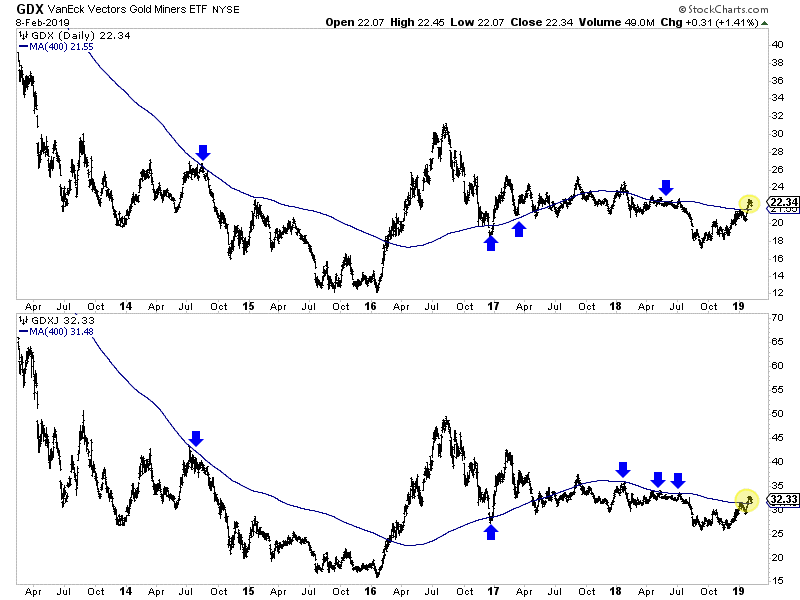
Moving forward, I see two plausible scenarios for the gold stocks.
They are either going to build a bullish consolidation (as I’ve sketched out below) or they will have a longer and deeper retracement which could lead to a test of the 200-day moving averages (not shown) near $20.50 for GDX and $30 for GDXJ.
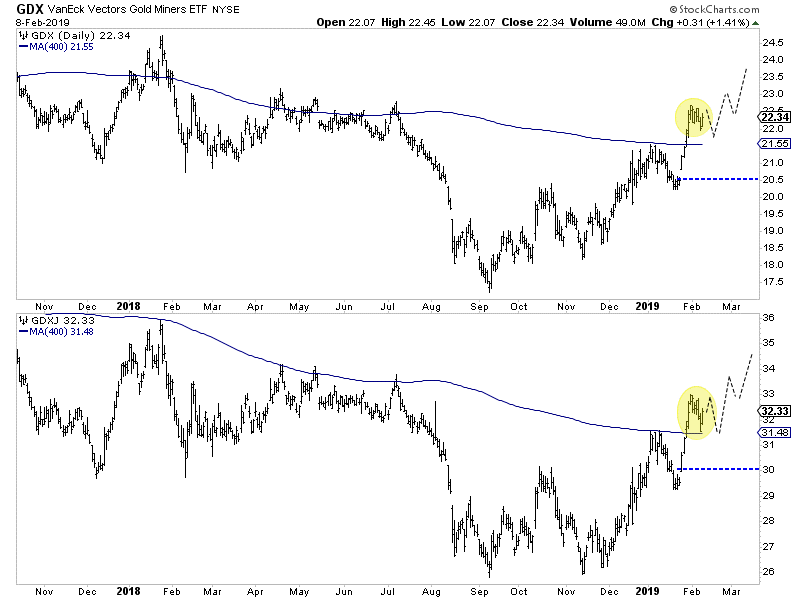
In the bullish scenario, look for the miners to hold above their 400-day moving averages and build a tight consolidation. If that develops, we would gain strong confidence in a bullish outcome.
In the bearish scenario, the miners would sell off below recent lows and threaten a test of the 200-day moving averages and the nearby open gaps.
Also, keep an eye on Silver, which like the miners will outperform when the sector trend is established. Note that on Thursday Silver bounced from the $15.60-$15.65/oz level which has been a critical level over the past two years. (See the arrows in the chart).
Should Silver hold that low then it should be able to rally above its 400-day moving average for the first time in over a year and test $17.25.
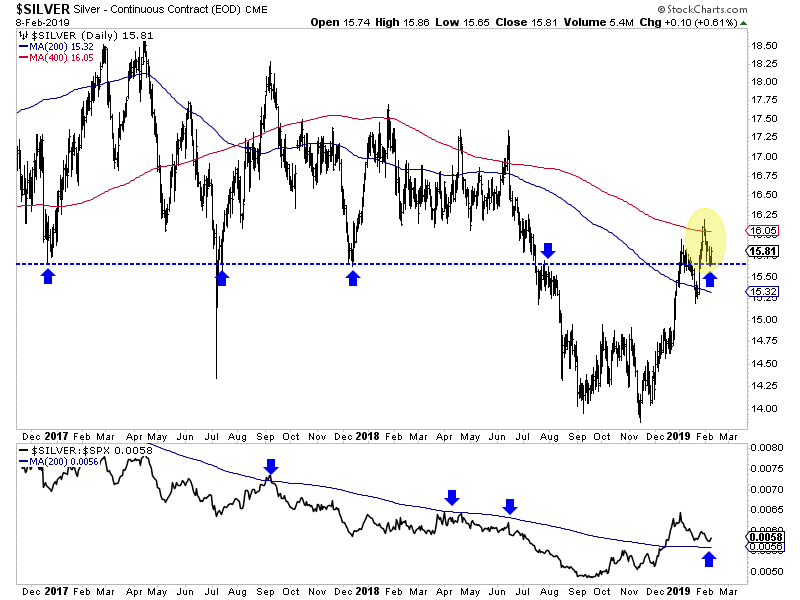
At the bottom of the chart we plot Silver against the S&P 500 and according to the 200-day moving average, that relative trend has turned in favor of Silver.
The bottom line is if GDX, GDXJ and Silver can maintain the lows from last week and firm up against the S&P 500 then they are likely going higher. If those lows break convincingly then look for a longer and deeper correction.
Essentially, should a bullish consolidation develop, we will prepare to put more capital to work. If not, then a deeper and longer correction is more likely which means we can be patient. To prepare yourself for some epic buying opportunities in junior gold and silver stocks before this bull market really gets going, consider learning more about our premium service.
- Is the latest tiny price correction in gold already done?
- Please click here now. Double-click to enlarge this daily gold chart. The uptrend looks majestic, and especially so in the face of the dollar’s strength against the euro and the yen.
- Whether gold rallies from the current $1306 support zone or from $1280 is not important. What’s important is the overall strength of the market, both fundamentally and technically.
- A staircase uptrend pattern (in place now for gold) is an indication of a very healthy market.
- Please click here now. Double-click to enlarge. The big technical picture for gold is also glorious!
- On the fundamentals front, the European economy is rolling over faster than America’s is right now. This situation is positive for gold. Europeans are nervous, especially in Germany, and they are steadily putting money into gold and physical gold ETFs.
- The dollar is strong against the yen because of the rally in global stock markets. That rally is happening in the face of fading U.S. corporate earnings because of the actions of the U.S. central bank.
- Stock markets initially tend to rally as the U.S. business cycle peaks and the Fed stops raising rates, but institutional investors soon become concerned that the Fed’s about-face is related to more serious concerns about the economy. Value players have sold out and many money managers are now in a “sell the rallies” mindset rather than “buy the dips”.
- Please click here now. The Fed’s change of stance is good news for gold but not so good news for the stock market (except in the very short term). Rates have barely risen off the floor despite this being one of the longest economic upcycles in the history of America.
- The upcycle was long in terms of time but horrifying in terms of actual growth. Arguably, the biggest real economy growth has been in the part-time jobs market. It’s also plausible that there would not have been any growth at all without the massive increase in government debt.
- The democrats have control of the House now and some influential players want to tie stock market buybacks to wage increases. That’s clearly inflationary and perhaps much more so than most analysts realize. Even if the legislation doesn’t get passed, I believe it will be passed “in spirit.”
- Key democrats also support the UBI (universal basic income) and free medical care. I’ve dubbed UBI the common man’s QE. These programs are all inflationary and are being proposed as the Fed changes its stance. That’s a “done deal” recipe for major stagflation over the long term.
- In the current big picture, I’ve suggested that rate hikes, QT, QE, and rate cuts are all win-win for gold. Rate hikes put pressure on the stock buyback programs and help push the QE money ball in the commercial banking system. That’s inflationary.
- Rate hikes also put pressure on the U.S. government’s ability to finance itself. That’s positive for gold.
- Rate cuts now reduce the carry cost for gold and boost the safe haven trade as investors flee stock markets as the fear of recession grows. That’s also positive for gold.
- Please click here now. Kudos to Congressman Mooney for doing the right thing. I urge all members of the U.S. gold community to call their congressional reps and demand they back Mooney’s proposed legislation.
- I’ve predicted that with China and India leading the way, gold will become an “approved and respected” mainstream asset in the years ahead, just like stocks and bonds. If Mooney gets serious support, it can happen even faster than I’ve predicted.
- Please click here now. As noted, the big picture for gold is glorious… both technically and fundamentally.
- Please click here now. Respected mainstream firm Bernstein has obviously joined “Team Gold”. They highlight the ongoing drop in America’s share of global GDP. Nothing Trump is doing will reverse that drop because it’s related to the West’s horrifying population demographics.
- The current U.S. government plan to reverse its insane debt growth with tariff taxes, a single corporate tax cut, a few regulatory red tape chops, no more rate hikes, and a border wall… is like trying to stop Niagara Falls by throwing a few popsicle sticks into the water.
- The temptation for the debt-worshipping U.S. government to inflate will soon be overwhelming. Clearly, elite U.S. analysts like Bernstein are already anticipating this is an imminent event.
- Please click here now. Double-click to enlarge this fabulous GDX chart. GDX and most high-quality gold stocks soared from September-December and did so while the U.S. stock market crashed. Then GDX soared in January while the stock market rallied.
- There’s now a bull flag in play and while gold looks great in this price correction, GDX looks even better. The $21.50 support zone for GDX is the equivalent of $1306 for gold, but the price hasn’t even reached that $21.50 level! There’s still a high probability that GDX blasts towards my next short-term target at $25 without even touching that support zone. That would be “outrageously bullish”.
- I refer to GDX as the “Prince of Assets” and to high quality individual gold stocks as “Knights Of The Round Bull Era Table”, and with good reason; it’s a glorious time to be invested in gold and the companies that mine it! These price corrections are not painful. They are so mild (and even enjoyable) that it’s almost ridiculous. The good news is that this theme is now poised to continue… for a very long time!
Special Offer For Website Readers: Please send me an Email to freereports4@gracelandupdates.com and I’ll send you my free “Walking The ETF Components Talk!” report. I compare the relative merits of the main precious metals ETFs and evaluate the top three performers in each ETF. Email me today, and I’ll send it to your inbox oday!
Thanks!!
Stewart Thomson
Graceland Updates
Email:
Stewart Thomson is a retired Merrill Lynch broker. Stewart writes the Graceland Updates daily between 4am-7am. They are sent out around 8am-9am. The newsletter is attractively priced and the format is a unique numbered point form. Giving clarity of each point and saving valuable reading time.
Risks, Disclaimers, Legal
Stewart Thomson is no longer an investment advisor. The information provided by Stewart and Graceland Updates is for general information purposes only. Before taking any action on any investment, it is imperative that you consult with multiple properly licensed, experienced and qualified investment advisors and get numerous opinions before taking any action. Your minimum risk on any investment in the world is: 100% loss of all your money. You may be taking or preparing to take leveraged positions in investments and not know it, exposing yourself to unlimited risks. This is highly concerning if you are an investor in any derivatives products. There is an approx $700 trillion OTC Derivatives Iceberg with a tiny portion written off officially. The bottom line:
Are You Prepared?
Morris Hubbartt
Feb 12, 2019
Here are today’s videos and charts (double-click to enlarge):
SFS Key Charts, Signals, & Video Analysis
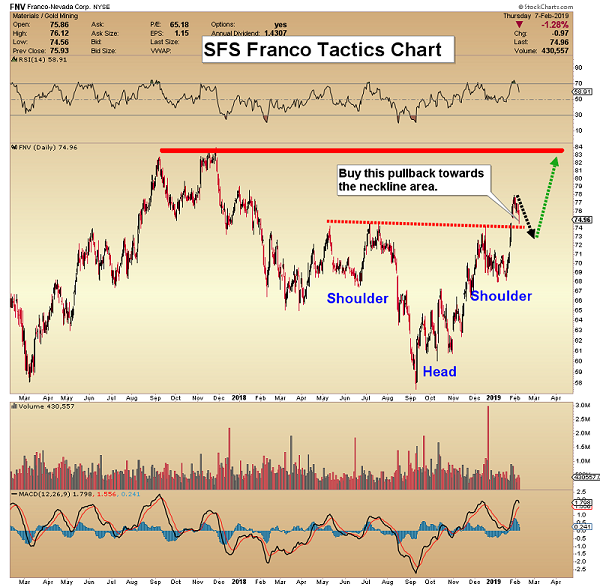

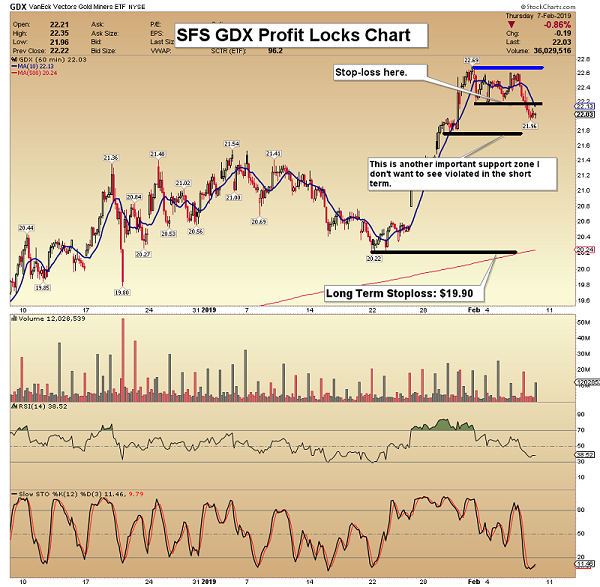

SF60 Key Charts, Signals, & Video Analysis
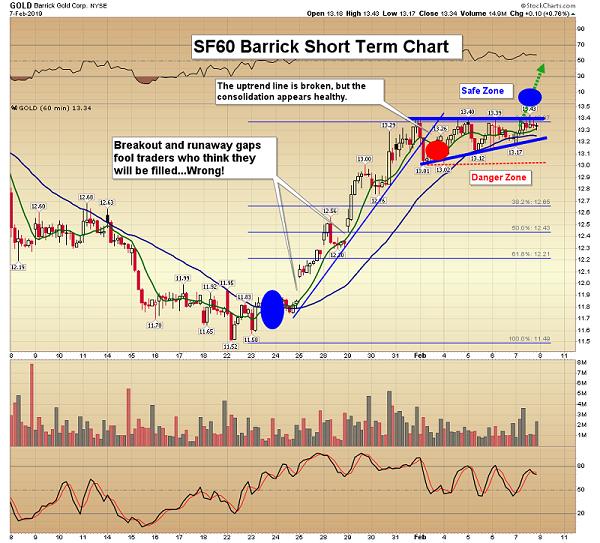

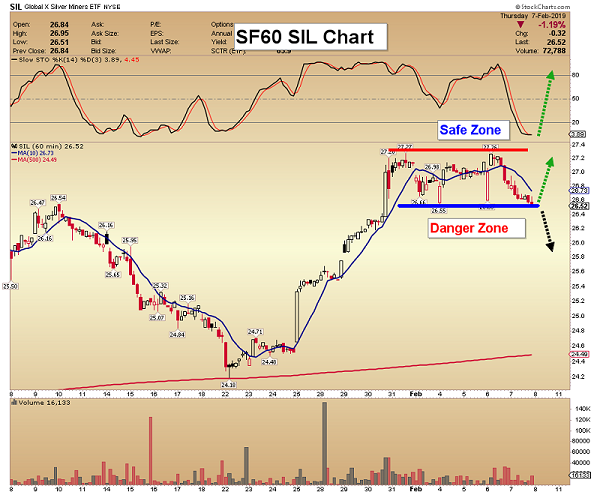

SF Trader Key Charts, Signals, & Video Analysis


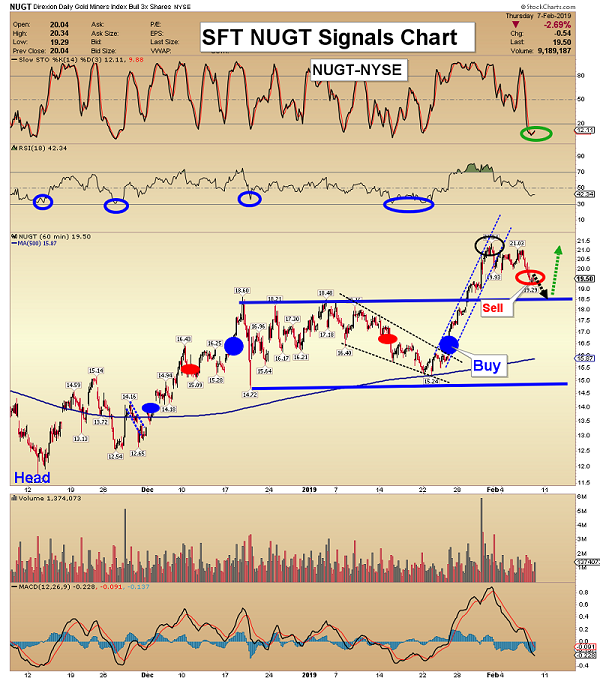

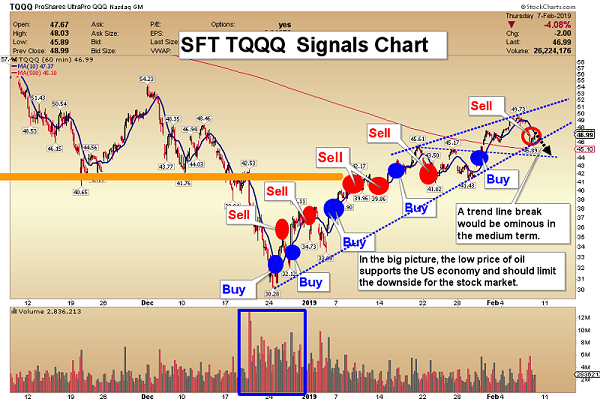

SFJ Key Charts, Signals, & Video Analysis
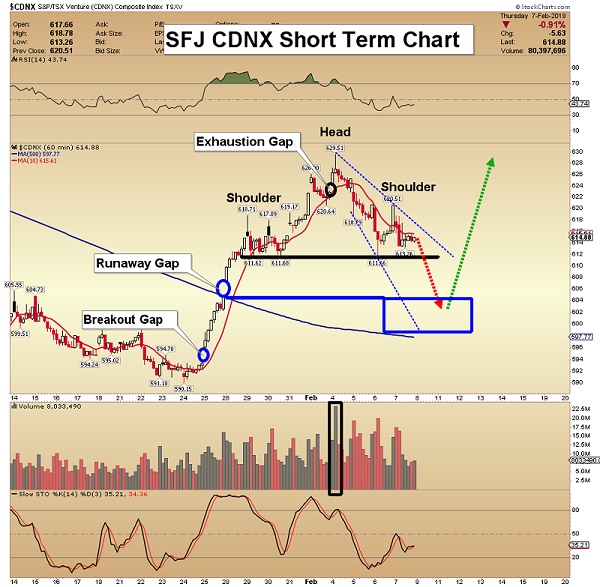

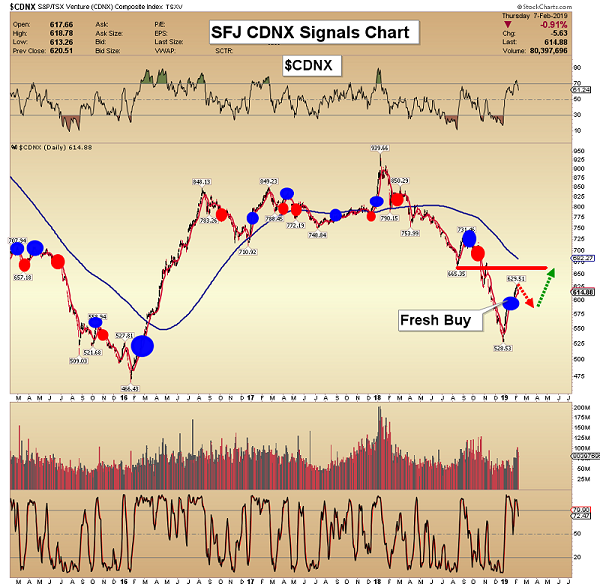

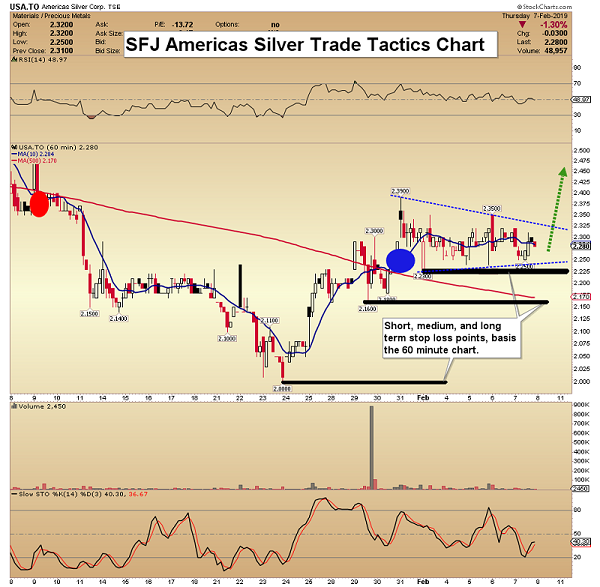

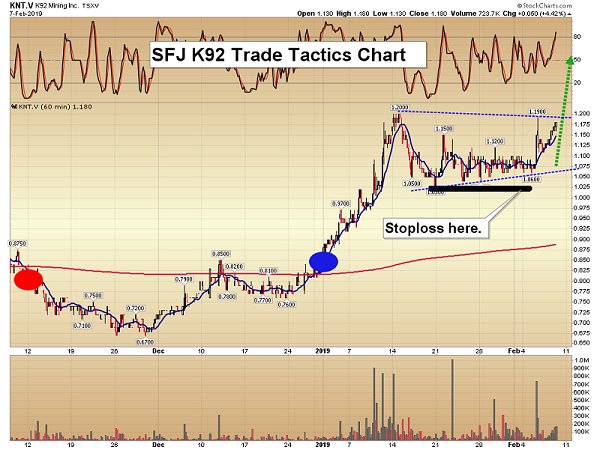

Thanks,
Morris Hubbartt
Unique Introduction For Website Readers: Send me an email to signals@superforcesignals.com and I’ll send you two hot junior stocks with buy, sell, and stoploss levels, plus 3 of my next Super Force Surge Signals free of charge, as I send them to paid subscribers. Thank you!
Stay alert for our Super Force alerts, sent by email to subscribers, for both the daily charts on Super Force Signals at www.superforcesignals.com and for the 60 minute charts at www.superforce60.com
About Super Force Signals:
Our Super Force signals are created thru our proprietary blend of the highest quality technical analysis and many years of successful business building. We are two business owners with excellent synergy. We understand risk and reward. Our subscribers are generally successful business owners, people like yourself with speculative funds, looking for serious management of your risk and reward in the market.
Frank Johnson: Executive Editor, Macro Risk Manager.
Morris Hubbartt: Chief Market Analyst, Trading Risk Specialist.
Email:
Gold stocks’ young upleg is gathering steam, marching steadily to higher lows and higher highs. These bullish technicals are gradually improving sentiment, fueling mounting interest in this contrarian sector. That’s helping the gold stocks regain lost ground relative to gold, the driver of their profits. Fundamentals are growing more favorable as gold itself powers higher. All this portends much-bigger gold-stock gains coming.
Despite a strong rebound upleg in recent months, the gold miners’ stocks are still flying under the radars of most speculators and investors. They aren’t aware the gold stocks are running again, and likely don’t realize how massive gold-stock uplegs can grow. That’s unfortunate, because the biggest gains are won early in young uplegs before they are universally recognized. Buying low early on is the key to multiplying wealth.
The most-popular gold-stock benchmark these days is the GDX VanEck Vectors Gold Miners ETF. It was launched way back in May 2006, giving it a first-mover advantage that has grown into an insurmountable lead. This week GDX’s net assets of $10.5b were a colossal 52.4x larger than the next-biggest 1x-long major-gold-miners-ETF competitor! GDX is the lens through which most traders now view gold-stock fortunes.
And they’ve been excellent in recent months, with GDX boasting performance well outpacing gold as well as the general stock markets. This first chart looks at this sector ETF’s price action over the last several years or so. That’s technically been a gold-stock bull, because gold itself remained in a bull market over that span. Since gold overwhelmingly drives gold-stock performance, it defines gold-stock bull-bear cycles.
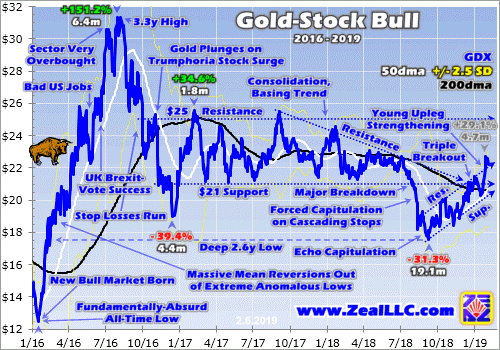

In mid-September GDX shares plunged to a deep 2.6-year secular low. That was fueled by an extreme forced capitulation in gold-stock shares, the result of stop losses being sequentially triggered in cascading fashion. The GDX price action of recent years setting the stage for this latest low and subsequent upleg is important to understand, and I’ve written recent essays explaining it. Today’s focus is the young upleg since.
It’s actually been quite impressive, and more traders will soon take notice. After bottoming at $17.57 on September 11th, GDX started powering higher in the tight well-defined uptrend bracketed above. Despite the incredibly-bearish sentiment you’d expect after a capitulation plunge leading to major lows, the gold stocks started marching higher on balance. Their young upleg has gathered steam and achieved much since.
GDX has carved a textbook-perfect series of higher lows and higher highs. That inexorably pushed it to a major triple breakout in late December and early January. GDX clawed back above three major overhead resistance lines. The first was the longstanding $21 support of GDX’s prior consolidation basing trend, which had persisted for 21.5 months before early August. Following a major breakdown, it became resistance.
The second was the downward-sloping resistance of a bearish descending-triangle technical pattern that had formed since GDX crested in early September 2017. And the third and most important was GDX’s 200-day moving average, shown in black in this chart. Seeing GDX overcome all three of these major overhead resistance zones in short order was a very bullish sign implying gold stocks were off to the races.
At best so far their young upleg per GDX has powered 29.1% higher in 4.7 months! That’s impressive by any standard. For comparison the S&P 500 broad-market stock index actually fell 6.4% during that span. And gold only rallied 10.3% in its own parallel upleg, so the major gold stocks have enjoyed good 2.8x upside leverage to the metal which drives their profits. That’s on the high side of the typical 2x to 3x range.
GDX has pulled back modestly since hitting its latest upleg high on January 31st, which was a breakout above its uptrend channel. Mid-upleg retreats within trend are perfectly normal and expected. They keep uplegs healthy and extend their longevity by periodically bleeding off excess greed. Without pullbacks, it would flare bright enough to suck in enough near-future buying for the upleg to prematurely exhaust itself.
And just this week this young gold-stock upleg reached another major technical milestone. On Tuesday GDX flashed a Golden Cross buy signal as its 50dma climbed back above its 200dma. Golden Crosses following deep oversold lows are incredibly bullish, signaling major new uplegs or entire bull markets! So they are one of the most-widely-followed and heeded buying signals among technically-oriented traders.
The initial major upleg of this gold-stock bull soared in essentially the first half of 2016, when GDX skyrocketed 151.2% higher in just 6.4 months! Nearly 2/3rds of those entire gains happened after the last Golden Cross following super-oversold lows flashed in early March 2016. These powerful buy signals aren’t just hard technical confirmation that a major upleg is underway, but they occur fairly early in upleg lifespans.
Today’s young gold-stock upleg is the most-consistent, longest-lived, and technically-sound one seen since that H1’16 monster! In general the more gradually uplegs rally, the stronger their technical and sentimental foundations and the longer they are likely to last. Slow-and-steady gains help prevent trader psychology from getting too unbalanced and extreme, granting more time for capital inflows to push prices higher.
GDX did enjoy a larger 34.6% surge over just 1.8 months leading into early February 2017. But that was so sharp it soon burned itself out and failed. Today’s young upleg is far more solid with a lot more staying power. And it remains on the small side by gold-stock standards, implying the lion’s share of its gains are still coming. While GDX’s massive 151.2% blast higher in H1’16 was unusual, gold-stock uplegs tend to get big.
The last secular gold-stock bull ran from November 2000 to September 2011. Just over half of that was in the pre-gold-stock-ETF era before GDX’s launch, so a different benchmark was used to measure it. During that long 10.8-year span, the classic HUI NYSE Arca Gold Bugs Index skyrocketed an astounding 1664.4% higher! Today’s hated gold stocks were the best-performing stock-market sector of that decade.
That life-changing secular gold-stock bull consisted of 12 separate uplegs. Excluding a giant anomalous one soaring after 2008’s first stock panic in a century, the 11 normal ones averaged gains of 80.7% over 7.9 months! Large uplegs are par for the course in the small and volatile gold-stock sector. So the 29.1% GDX gains we’ve seen so far in today’s young upleg are nothing. It’s likely to grow much larger in coming months.
Technically GDX should easily rally to $25 fairly soon, which was the old upper-resistance line of its long consolidation basing trend. That would extend this upleg’s gains over 42%. At that point GDX’s upside momentum would likely drive an upside breakout. And seeing GDX climbing to new multi-year highs over $25 would certainly catch traders’ attention, leading to a surge in capital inflows to chase gold stocks’ upside.
GDX’s bull-to-date peak was $31.32 in early August 2016, which wasn’t lofty as a mere 3.3-year high. It wouldn’t surprise me at all to see GDX challenge those levels before this young upleg matures then gives up its ghost. Rather interestingly that would grow this upleg to 78% gains, which is right in line with the previous secular bull’s average. The gold stocks still have lots of room to power much higher from here.
Their coming gains are inexorably intertwined with gold like usual. Gold-stock uplegs are directly driven by parallel gold uplegs. Rising gold prices boost gold stocks both sentimentally and fundamentally. They motivate speculators and investors to redeploy capital in the gold miners, and buying begets buying. The longer and higher gold stocks rally, the more traders want to buy them. Gold gains fuel this virtuous circle.
But more importantly higher gold prices directly drive higher earnings at the gold miners, fundamentally justifying higher gold-stock prices. This critical relationship is approximated by the ratio between gold-stock and gold price levels. It also portends big gold-stock gains coming. This next chart looks at the GDX/GLD Ratio during recent years’ gold-stock bull. GLD SPDR Gold Shares is the world’s leading gold ETF.
When this GGR is rising it means gold stocks are outperforming gold. That’s normally what happens in gold-stock uplegs. Like GDX itself, its ratio to gold is also climbing in a strong uptrend since those deep mid-September gold-stock lows. But the GGR remains on the low side of today’s gold bull, and has vast room to mean revert higher to pre-bull averages. I explained all this in depth back in a mid-October essay.
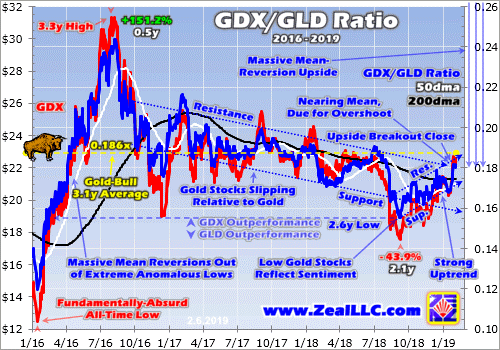

In mid-September as gold stocks’ forced capitulation decimated sentiment, the GGR collapsed to merely 0.155x. A single share of GDX was worth less than 1/6th of a single share of GLD. That also happened to be a 2.6-year secular low in the ratio of gold-stock price levels to gold prices. That simply reflected the seriously-bearish psychology that invariably accompanies major lows. But the GGR has recovered since.
By that latest interim GDX high on January 31st, the GGR had mean reverted back up to 0.182x. That is actually still below this bull market’s average of 0.186x over the past several years or so. But the climbing GGR proves gold stocks are making a major recovery relative to gold. Note above today’s young upleg is seeing the longest, strongest, and solidest GGR rally since H1’16! This upleg is the real deal, no flash in the pan.
After the GGR is forced to major lows or highs well off its averages, it tends to not only mean revert but overshoot proportionally. Since this key fundamental metric of gold stocks fell 0.030x below its bull mean at worst in mid-September, it ought to power a similar amount back above it before this upleg matures. That implies a 0.216x GGR is likely as gold stocks get more popular the longer their upleg rallies higher.
This week GLD traded near $124, so GDX regaining 0.216x means its price would rally to $26.78. That would make for a 52% upleg at today’s gold prices, and would drive that major breakout over GDX’s old $25 resistance line. And of course higher gold prices would lead to proportionally-higher GDX targets at any given GDX/GLD Ratio. Looking at today’s gold-stock levels compared to past means shows huge upside.
Back in mid-October when GDX was still only trading in the $18s and few believed a new gold-stock upleg had been born, I explored the GGR. This small contrarian sector was the last cheap one in wildly-expensive stock markets. I looked at some past GGR levels from the last secular gold-stock bull to point out how far gold stocks could soar. Consider the couple-year spans surrounding 2008’s wild stock panic.
In the 2 years after that extreme anomaly, 2009 and 2010, the GGR averaged 0.422x. And in the 2 years before that fear superstorm, it averaged 0.591x. Those are not high levels at major gold-stock toppings when euphoria reigned, but mere means. GDX ought to be able to regain those well-established levels later on in this bull market. At today’s gold prices, the post-panic average would catapult GDX to $52.33.
That would make for 198% gains from the recent secular low, a tripling in major gold miners’ stock prices! And that still wouldn’t be close to GDX’s $66.63 record hit at the end of gold stocks’ last secular bull back in September 2011. At the pre-panic 2-year-average GGR, this week’s gold levels would support an all-time GDX high of $73.28. That’s 317% higher than recent lows, more than a quadrupling in gold-stock price levels!
And all this assumes flat gold in the low $1300s, which is very unlikely. Gold is enjoying its own young upleg powering higher, which was sparked by the serious stock-market selloff in Q4. At $1350, $1400, or $1450 gold, the gold-stock price levels implied by GGR mean reversions are much higher. And that doesn’t account for the typical proportional overshoot towards the opposite extreme after deep GGR lows are hit.
The key takeaway here is gold stocks’ upside potential remains very large despite the progress so far in this young upleg. The big majority of this particular gold-stock upleg almost certainly remains ahead, so it’s not too late to get deployed before everyone else figures it out. Once gold stocks start surging faster than gold, the resulting bullish psychology becomes self-feeding enticing in more capital fueling bigger gains.
Big gold-stock uplegs are fully justified fundamentally by higher gold prices. Consider an example. The gold miners are now reporting their Q4 results, but the last complete set was Q3’s. Then the major gold miners of GDX reported average all-in-sustaining costs of $877 per ounce. These generally don’t change much regardless of prevailing gold prices. Mining costs are largely fixed when mines are being planned.
That’s when engineers and geologists decide which ore to mine, how to dig to it, and how to process it to recover the gold. So higher gold prices directly amplify gold miners’ bottom lines. While I’ll wade through the gold miners’ Q4 results once they are all released and write a new essay on them, AISCs are highly likely to remain near Q3 levels. Let’s call it $875 per ounce. In Q4 gold’s price averaged $1228 despite the rally.
That means the major gold miners were collectively earning about $353 per ounce mined. Meanwhile so far in Q1 gold is averaging $1296, which is a hefty 5.5% higher quarter-on-quarter. Assuming AISCs are flat across this industry, that implies gold miners are now earning $421 per ounce. That’s a massive 19.3% QoQ jump in profits on a 5.5% higher gold price, making for strong 3.5x upside leverage to gold.
The higher prevailing gold prices thanks to its own upleg are fueling fatter earnings for the gold miners. That provides the critical fundamental underpinning supporting major gold-stock uplegs. They are not just psychological phenomena driven by shifting sentiment, but actually reflect better operating conditions. I doubt historical gold-stock uplegs could’ve averaged such big gains without real fundamental foundations.
The unfortunate thing about major gold-stock uplegs is most speculators and investors ignore them until way too late. Traders love buying high and chasing momentum, but hate buying low before those big gains happen. So sadly the great majority of traders miss the great majority of major gold-stock uplegs. They don’t start deploying capital until after most of the gains are already won, which usually leads to later losses.
While today’s young upleg is gathering steam, we’ve likely only seen the first third or so. Thus there is still time to buy gold stocks relatively low before others start chasing their momentum in coming months after they are much higher. Why buy high later when you can still buy low now? And the best gains won’t be won in big ETFs like GDX, but in the stocks of fundamentally-superior smaller mid-tier and junior gold miners.
The major gold miners dominating GDX are really struggling to grow their gold production. Depletion is outpacing mine growth leading to higher costs and lower profits. That really retards their and thus GDX’s upside potential. But plenty of smaller gold miners are growing their output through new mine builds and expansions, which also lowers their costs. Their stocks’ upside potential utterly trounces the GDX majors.
The earlier you get deployed, the greater your gains will be. That’s why the trading books in our popular weekly and monthly newsletters are currently full of better gold and silver miners mostly added in recent months. The gains we won in 2016 were amazing the last time American stock investors returned to gold. Our newsletter stock trades that year averaged +111.0% and +89.7% annualized realized gains respectively!
The gold-stock gains should be similarly huge as today’s young gold and gold-stock uplegs grow. The gold miners are the last undervalued sector in these still-expensive stock markets, and rally with gold during stock-market bears unlike anything else. To multiply your wealth in the stock markets you have to do your homework and stay abreast, which our newsletters really help. They explain what’s going on in the markets, why, and how to trade them with specific stocks. You can subscribe today for just $12 per issue!
The bottom line is this young gold-stock upleg is really gathering steam. Technically it has rallied higher on balance for months now in a strong uptrend, carving higher lows and higher highs. GDX has broken out above three major resistance lines, and just flashed a key Golden Cross buy signal! All this has really started to shift sentiment back to bullish, which will attract in lots more capital to chase the momentum.
And these mounting gold-stock gains are fundamentally justified by gold’s own growing upleg. Gold-stock earnings amplify underlying gains in gold, making big stock-price surges righteous. Now is the time to get deployed relatively low, before most traders figure this out and start piling in. The evidence suggests a major gold-stock upleg is underway and mounting, and they tend to average gains far bigger than today’s.
Adam Hamilton, CPA
February 11, 2019
Copyright 2000 – 2019 Zeal LLC (www.ZealLLC.com)
- Gold price sales offer opportunity but patience is required. I like to see a market swoon of at least $50/ounce before buying any fresh medium-term gold or related positions.
- Most amateur gold investors should wait for $100/ounce declines before buying or use very tight stop-losses to protect their capital.
- When buying, it’s important that investors have strong hands accompanying them, and the smaller dips don’t attract Chindian dealer or COMEX commercial trader buying in much size.
- Please click here now. Double-click to enlarge. Gold has rallied about $130 since the August lows of about $1175.
- A consolidation or correction becomes more likely as a rally extends in both price and time. That doesn’t mean a correction has to happen now, but it does mean investors need to get emotionally prepared for it to happen.
- A 50% correction would see gold trade near the $1250 area and that would represent about an $80 price sale from the $1330 area highs. That’s not likely enough of a pullback to guarantee significant Chindian dealer and COMEX commercial buying of size.
- If gold’s rally continued to $1350 before the correction began, a pullback to $1250 would become an important buying area for long term investors.
- Please click here now. Double-click to enlarge this short-term gold chart. Some “head & shoulder topping” action is beginning to present itself. Charts are created by fundamentals, and while the big picture for gold is truly spectacular, the short-term picture is somewhat negative.
- That’s because the Chinese New Year holiday is in play. China’s gold market is closed this week, and it’s an important cog in the gold demand wheel.
- Please click here now. Double-click to enlarge. While it’s true that Chinese demand tends to swoon at this time of year, this year I believe it’s unlikely to produce anything more than a modest and heathy correction. I’m already quite impressed with the orderly nature of the sell-off.
- In America, top bank economists predict GDP growth will slip to 2% or lower by the third quarter, which is also stock market “crash season”. Republicans lost the House because they refused to eliminate income taxes for the poor, and now powerful politicians in the House want to reduce stock buybacks that have been supporting the stock market.
- Jay Powell has warned investors that the U.S. stock market is at risk of a crash. Wall Street money managers predict he won’t raise rates at all this year, but I’ve called that wishful thinking.
- I don’t think the money managers need to be worried about rate hikes because of strong growth, but I do think they need to be very concerned about the possible emergence of US stagflation in the second half of the year. That could send money managers into gold stocks in quite a major way. The bottom line:
- In the short term, gold faces modest seasonal headwinds. In the medium and long term, gold has mighty tailwinds!
- Please click here now. Double-click to enlarge this NUGT chart. For short term action, I suggest traders use my guswinger.com trade service to trade NUGT, DUST, UDOW, and SDOW. I’ve highlighted my latest mechanical system trades on this chart.
- Short term trading in the gold market should be just one part of an overall investment program. The ability to take quick action can help reduce investor tension. In contrast, my sole focus for the U.S. stock market is short term trading. The market is too dangerous now to engage in long term positioning with large amounts of risk capital.
- U.S. stocks should stagger somewhat higher because the business cycle still has some life left in it, but risk now dramatically overwhelms potential reward. Powell’s change in tone could be related to the money managers and the U.S. government begging him to give them a break.
- Unfortunately, it’s more likely that he has the same outlook the bank economists and I have for the US economy; a meltdown in U.S. GDP growth and corporate earnings is imminent.
- With the U.S. government operating on massive debt growth autopilot, a slowdown in GDP is almost certain to be accompanied by a loss of confidence in the ability of the government to finance itself.
- From a gold investor’s standpoint, what’s particularly interesting is that it appears that foreign central banks are slowly but surely replacing their U.S. Treasury bond holdings with gold bullion! This is likely putting pressure on the Fed to dial back its QT program and that could create an even bigger loss of confidence event.
- Long term positions in the U.S. stock market need to be accumulated at the business cycle trough, and that trough is likely to bring vastly lower stock market prices than investors see in front of them now.
- Please click here now. Double-click to enlarge this GDX chart. Over the past twenty years, gold stocks have generally had severe price corrections when gold has staged modest swoons. That’s because a deflationary theme was in play.
- Now, an inflationary theme is beginning. Some individual gold stocks are holding their gains when gold declines, and the GDX and SIL indexes are not staging any crash-like sell-offs when gold declines.
- While profit booking is always a good thing (especially with oscillators overbought after a sharp run higher in the price), GDX is technically very healthy, and a possible bull flag pattern is in play. Will that pattern continue to form as the Chinese gold market stays closed this week? I think so. Will the price then burst out of the flag pattern and surge past $23 and reach my new $25 target? I think so, too!
Special Offer For Website Readers: Please send me an Email to freereports4@gracelandupdates.com and I’ll send you my free “Juniors With The Uptrend Juice!” report. I highlight key junior miners that are now in clear uptrends and technically healthy, with precision buy, sell, and optional stoploss prices for money making action!
Stewart Thomson
Graceland Updates
Email:
Risks, Disclaimers, Legal
Stewart Thomson is no longer an investment advisor. The information provided by Stewart and Graceland Updates is for general information purposes only. Before taking any action on any investment, it is imperative that you consult with multiple properly licensed, experienced and qualified investment advisors and get numerous opinions before taking any action. Your minimum risk on any investment in the world is: 100% loss of all your money. You may be taking or preparing to take leveraged positions in investments and not know it, exposing yourself to unlimited risks. This is highly concerning if you are an investor in any derivatives products. There is an approx $700 trillion OTC Derivatives Iceberg with a tiny portion written off officially. The bottom line:
Are You Prepared?
First we need to define what a breakout actually is. It is when the price breaks a pattern or a range and a new trend is therefore established.
Today, people are all too quick to refer to almost every move higher as a breakout. Just google “Gold Breakout” and you’ll see what I mean.
Sure, closing above $1300 was a breakout for Gold. But that’s hardly significant. If and when Gold surpasses the wall (resistance at $1350-$1375), it will mark a real breakout.
The good news is Gold is currently in a much better position both fundamentally and technically than it was in 2016, 2017 and 2018.
Let me start with the technicals.
Gold in real terms is stronger than at any other time in the past few years.
In the chart below we plot Gold against foreign currencies (FC), stocks, bonds and commodities. The four vertical lines highlight the points when Gold was testing its wall of resistance.
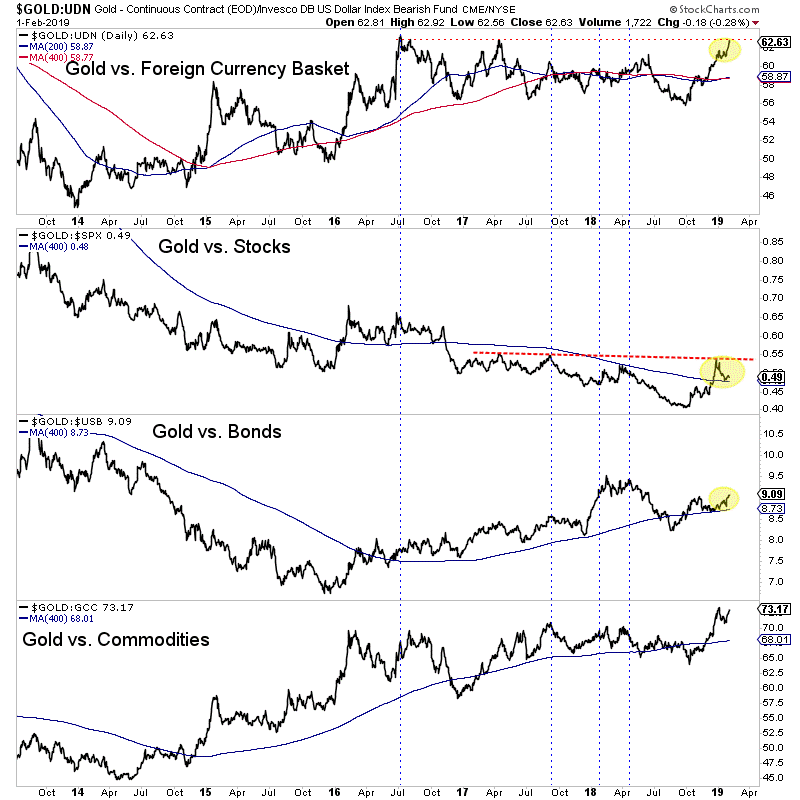

During 2017 through 2018, Gold was driven mostly by a weak dollar. In relative terms, Gold was weak against FC and stocks.
Relative to summer 2016, Gold is currently stronger against bonds and commodities and is inches away from testing its 2016 high against FC.
The last thing holding Gold back is the stock market. Note that the Gold to S&P 500 ratio has not made a higher high in recent days. While its holding above moving average support it desperately needs to make a higher high to confirm a new Gold bull market is underway.
The performance of Gold relative to the stock market is connected to the fundamentals for Gold.
If the stock rally and economic data hold firm, the Fed could reintroduce rate hikes into the equation. That’s not a bullish scenario for Gold. (It’s important to keep this in mind).
On the other hand, if the market is right, the Fed is done hiking rates and will make its first rate cut in 2020.
That scenario eventually implies equity market weakness, a push higher in the Gold to stock market ratio and a breakout in Gold.
So who should we trust: the market or the Fed, who thinks they could hike this year?
The gold stocks are providing additional evidence. They exploded above their 400-day moving averages and have shown strong breadth over the past two weeks.
At present, the weight of the evidence is favoring bullish outcomes for precious metals. Ultimately, if Gold and gold stocks extend their outperformance against the stock market then look out for a breakout and a full blown bull market. To prepare yourself for some epic buying opportunities in junior gold and silver stocks, consider learning more about our premium service.
by Morris Hubbartt
February 5, 2019
Here are today’s videos and charts (double-click to enlarge):
SFS Key Charts, Signals, & Video Analysis
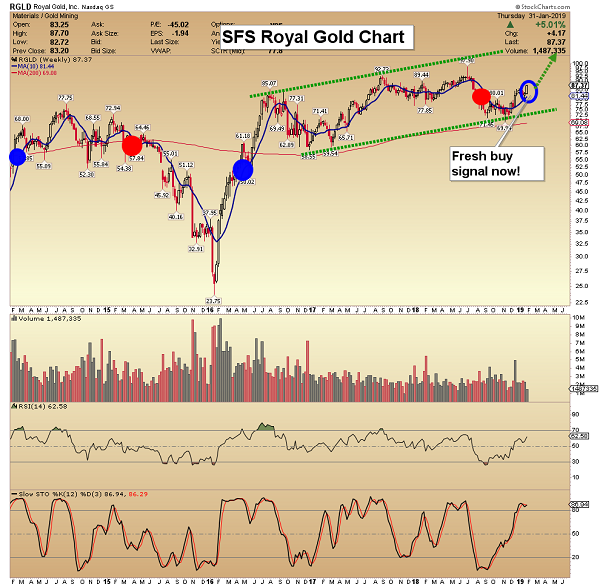

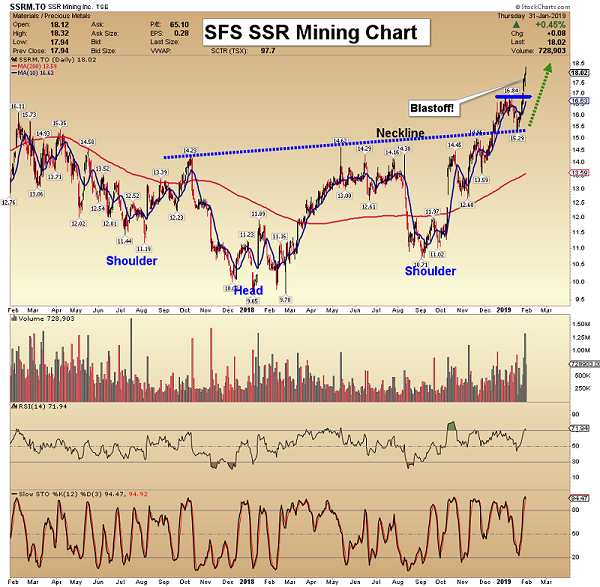



SF60 Key Charts, Signals, & Video Analysis


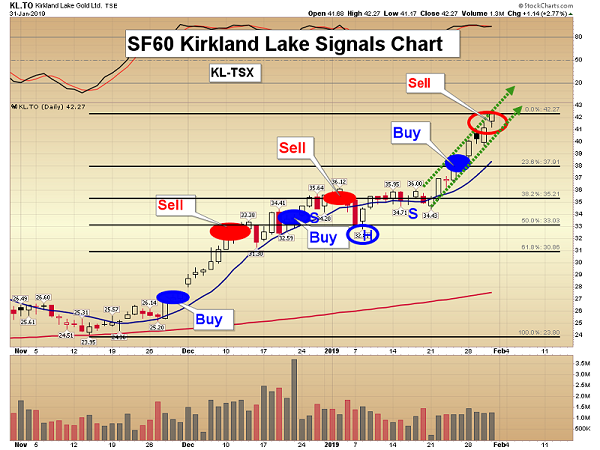

SF Trader Key Charts, Signals, & Video Analysis
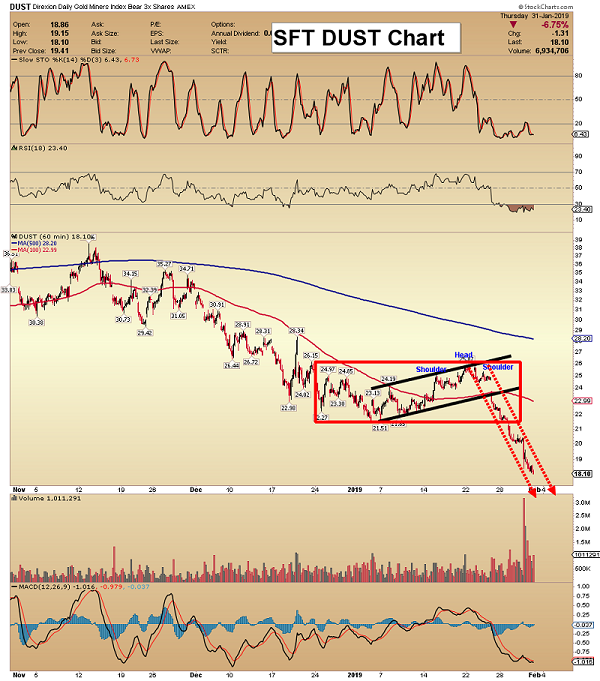

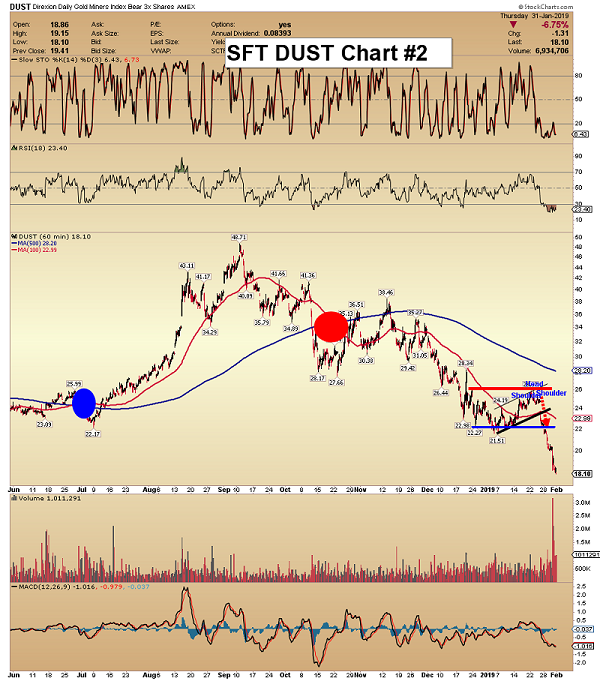

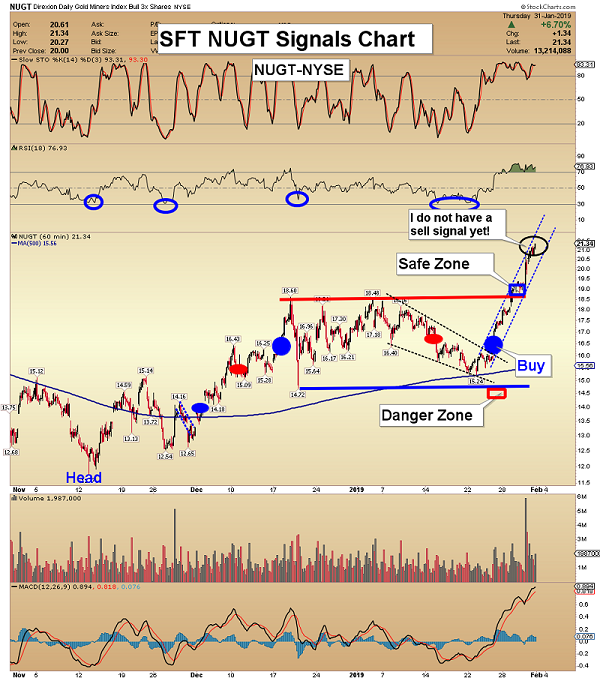

SFJ Key Charts, Signals, & Video Analysis
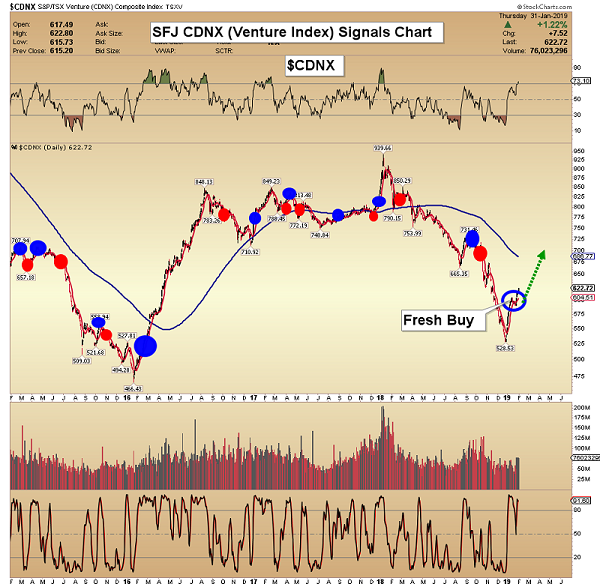

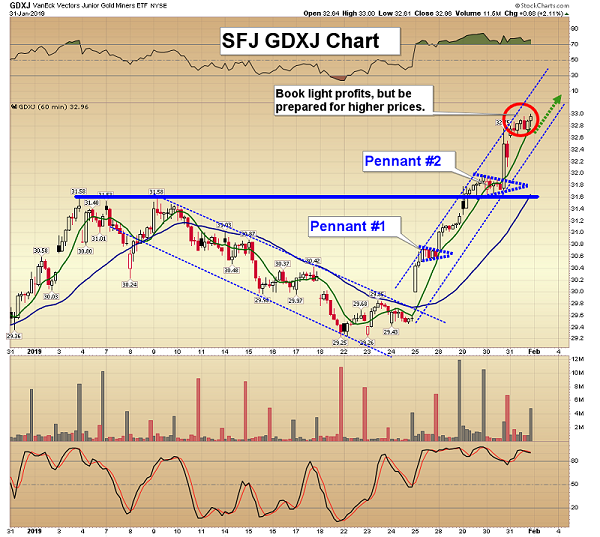

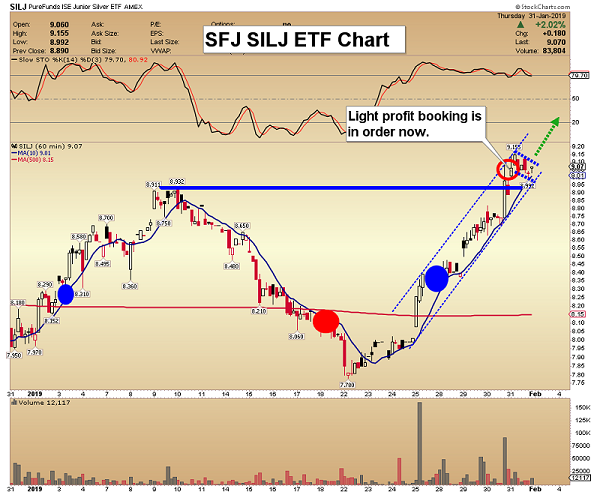

Thanks,
Morris Hubbartt
Unique Introduction For Website Readers: Send me an email to signals@superforcesignals.com and I’ll send you 3 of my next Super Force Surge Signals free of charge, as I send them to paid subscribers. I’ll also send you a video on three of the hottest junior gold stocks! Thank you!
Stay alert for our Super Force alerts, sent by email to subscribers, for both the daily charts on Super Force Signals at www.superforcesignals.com and for the 60 minute charts at www.superforce60.com
About Super Force Signals:
Our Super Force signals are created thru our proprietary blend of the highest quality technical analysis and many years of successful business building. We are two business owners with excellent synergy. We understand risk and reward. Our subscribers are generally successful business owners, people like yourself with speculative funds, looking for serious management of your risk and reward in the market.
Frank Johnson: Executive Editor, Macro Risk Manager.
Morris Hubbartt: Chief Market Analyst, Trading Risk Specialist.
Email:
Silver recently started outperforming gold again, a watershed event. For long years this white metal has mostly lagged the yellow one, relentlessly battering silver sentiment. But gold surging into year-end 2018 finally sparked some life into moribund silver. This is a bullish sign, as silver has soared in the past once rising prices reach critical mass in attracting new investment capital. Silver looks to be nearing that point again.
Despite a good finish, 2018 was a rough year for silver. Its price slumped 8.6%, way worse than gold’s -1.6% performance. And that still masks miserable intra-year action. At worst in mid-November, silver had plunged 17.3% year-to-date. That was 2.2x gold’s comparable loss, and at $13.99 silver languished at a major 2.8-year low. A soul-crushing 96% of its early-2016 bull market had been reversed and lost!
Back in December 2015 silver had bottomed a few days before gold at a deep 6.4-year secular low. Over the next 7.6 months silver soared 50.2% higher, outpacing gold’s parallel new-bull upleg by 1.7x. That promising start didn’t pan out though, silver crumbed once gold’s advance stalled and failed. Ever since its August 2016 peak of $20.56, silver mostly ground sideways sandwiched between two major downlegs.
It was the latter one that finally bottomed in mid-November 2018, with hope lost and silver bearishness universal and suffocating. Silver’s fortunes are heavily dependent on gold, and silver effectively acts like a gold sentiment gauge. The weak silver prices reflected the lack of enthusiasm for gold, which wasn’t far above its own 19.3-month low of mid-August. Gold had slumped to $1200, and threatened to break below.
For better or worse, gold drives silver. Traders usually ignore the tiny silver market until gold has rallied long enough and high enough to convince them its upside momentum is sustainable. So when gold itself is down in the dumps, silver doesn’t have a prayer. But gold bottomed that day and started clawing back higher, so silver joined along in the bounce. That gradually grew into a new silver upleg over the next 8 weeks.
By early January, silver had rallied 12.4% on a 7.7% gold rally. That made for 1.6x upside leverage to gold, which is still on the low side historically. But it was a welcome change after silver spent much of last year sliding considerably. A sub-span of that advance really caught my attention. Between the hawkish FOMC meeting on December 19th to the young new year on January 3rd, silver surged 7.9% in 9 trading days.
That was 1.9x gold’s 4.2% advance, and silver’s best outperformance relative to gold since that major upleg in H1’16! Something was changing in the left-for-dead silver market, with capital starting to return after more than a couple years of self-imposed exile. Over this past week silver enjoyed another solid stretch of outperformance, offering further confirmation. It started last Friday when gold itself soared 1.7%.
Gold ignited after a Wall Street Journal article claiming the Fed was considering ending its quantitative tightening early! That dovishness hit the U.S. dollar and catapulted gold higher. Over the next 4 trading day’s silver surged 4.8% on gold’s 3.0%, for 1.6x leverage. If that buying can push silver high enough to reach a psychological critical mass and become self-feeding, it portends major silver upside in coming months.
The more silver rallies, the more speculators and investors will want to buy it. The more capital they push into silver, the faster it will ascend. Buying begets buying in silver just like almost everywhere else in the markets. While upside momentum in itself is bullish anytime, silver’s upside potential is far greater than usual because it has been so darned undervalued. That’s made room for massive mean-reversion gains.
Silver’s “valuation” can be inferred relative to gold, its dominant driver. While the global silver and gold supply-and-demand profiles are independent with little direct linkage, these precious metals are joined at the hip psychologically. Silver rarely rallies materially unless gold leads the way. Silver traders look to gold for cues, which makes silver amplify gold’s moves. Silver’s technical relationship to gold is ironclad.
All this makes the Silver/Gold Ratio the most-important fundamental measure of silver-price levels. It is technically calculated by dividing daily silver closes by daily gold closes. But that yields tiny decimals that are hard to parse mentally, like the mid-week SGR of 0.012x. It is far more brain-friendly to consider this ratio from the opposite direction, via the Gold/Silver Ratio. This week it ran at an easier-to-comprehend 82.2x.
Mathematically the SGR is identical to an inverted GSR. So charting the GSR with an upside-down scale yields the same line as the SGR, but with way-more-intelligible numbers. Here this inverted-GSR SGR proxy in blue is superimposed over the silver price in red. Silver has rarely been lower relative to gold than it was in recent months. That portends monster upside as silver mean reverts higher leveraging gold.
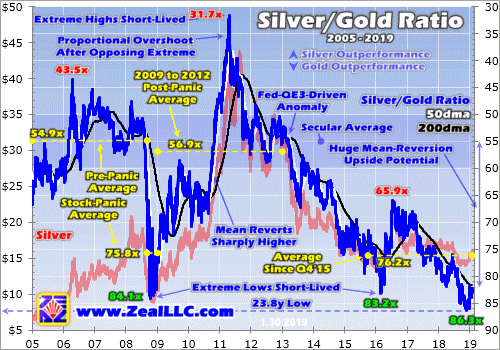

At that latest secular silver low in mid-November, the SGR fell to 85.9x. In other words, it took nearly 86 ounces of silver to equal the value of one ounce of gold. While silver started recovering, it initially lagged gold enough to force the SGR lower still. At the end of November it slumped as low as 86.3x on close, an astounding level. That was actually an extreme 23.8-year secular low in the SGR, nearly a quarter-century!
Silver hadn’t been lower relative to gold since early March 1995, practically a lifetime ago considering all that’s happened in the financial markets since. Even during the greatest market fear event in our lifetimes the SGR wasn’t lower. During late 2008’s first-in-a-century stock panic, the SGR just briefly hit 84.1x in mid-October. Being highly-speculative and super-sensitive to sentiment, silver had plummeted leading into it.
That stock-panic episode of extreme SGR lows shows what’s probable after silver inevitably reverses and mean reverts higher. Over the 3.7 years since 2005 leading into that panic, the SGR averaged 54.9x. That was right in line with the mid-50s that had been normal for decades. Silver had generally oscillated around 1/55th the price of gold, so miners had long used 55x as the proxy for calculating silver-equivalent ounces.
With silver so radically out of whack relative to gold, those extreme SGR panic lows weren’t sustainable. Like a beachball pushed too far under water, silver was ready to explode higher to reestablish its normal relationship with gold. That indeed happened during the post-panic years. After plummeting as low as $8.92 in late-November 2008, silver more than doubled by early December 2009 with a 115.4% gain.
While silver was really outperforming gold after its anomalous lows, at best in that initial post-panic rally the SGR only regained 58.6x. That was still below the 55x secular average. So silver continued slowly grinding higher on balance into late 2010. Then gold started surging again, creating the right sentiment conditions to unleash self-feeding silver buying. Silver skyrocketed from there, surging far faster than gold!
The faster silver soared into early 2011, the more traders wanted to own it and the more capital they poured into it. This psychological phenomenon of higher prices being more attractive runs through nearly all markets. The crazy bitcoin mania in late 2017 was a recent example. Silver’s virtuous circle of surging and new capital inflows finally climaxed in late April 2011 at $48.43 per ounce. That was one heck of a bull.
Starting from those extreme stock-panic lows radically undervalued relative to gold, silver had rocketed 442.9% higher in 2.4 years! And that massive run didn’t simply stop at a 55x SGR, but instead the huge buying momentum drove a proportional upside overshoot. The SGR peaked at 31.7x, which was 4/5ths as far above that long-term 55x mean as the SGR was below it at stock-panic lows. This principle is crucial.
After longstanding price relationships driven by some kind of inexorable fundamental or psychological links are forced to extremes, they don’t just mean revert. That reversion momentum blasts them right through their average to overshoot proportionally towards the opposing extreme! This behavior is very pendulum-like. The farther the SGR is pulled one way, the stronger its swing towards the other side of the arc.
Interestingly that massive mean-reversion-overshoot bull following 2008’s stock panic ultimately dragged the SGR high enough to average 56.9x in those post-panic years between 2009 to 2012. Despite great volatility in this ratio, it continued to gravitate towards that 55x secular mean. That persisted until early 2013 when the Fed’s unprecedented open-ended third quantitative-easing campaign greatly distorted markets.
That year alone the Fed conjured $1020b of QE capital out of thin air to inject into the markets! That forced the flagship US S&P 500 broad-market stock index 29.6% higher that year. Such blistering gains made investors forget about gold and silver, so they fell precipitously. That shattered fragile sentiment leading to multi-year bear markets in the precious metals. Silver leveraged gold’s downside like usual.
Thus the SGR slowly collapsed between early 2013 to early 2016 as gold and silver languished in Fed-driven bear markets. That was a very-challenging time psychologically, scaring away the great majority of contrarian speculators and investors. Ultimately silver plunged so far that the SGR fell to 83.2x at worst in late February 2016. That was an extreme low rivaling the 2008 stock panic’s, which truly defies all reason.
Again such SGR extremes weren’t sustainable, so silver blasted higher with gold and amplified its gains in roughly the first half of 2016. Unfortunately that new-bull upleg was cut short, capping silver at mere 50.2% gains and the SGR at 65.9x. Silver’s typical mean reversion out of extreme SGR lows was indeed underway, but unfortunately it was short-circuited by Trump’s stunning surprise election victory that November.
The stock markets started surging on hopes for big tax cuts soon with Republicans controlling the House, Senate, and presidency. So stock traders dumped gold-ETF shares which hammered the gold price and sucked silver down with it. Silver continued underperforming gold on balance until late November 2018 and that latest extreme 86.3x SGR low. Silver both fell faster than gold and rallied slower than it over this span.
Again that crazy nearly-quarter-century low in silver prices relative to gold prices was more extreme than both during late 2008’s stock panic and after late 2015’s secular low. Shockingly the SGR average since Q4’15 is now running 76.2x, which is actually worse than the 75.8x in the four months in late 2008 hosting that stock panic! Silver has languished far too low relative to gold in recent years, an unsustainable anomaly.
That guarantees a massive mean reversion higher for silver as gold’s young upleg continues to unfold. Seeing gold power higher on balance will motivate speculators and investors to redeploy into silver, which will fuel outsized gains in the white metal. That process is already underway, as proven by silver’s sharp gains relative to gold straddling the dawn of this new year. Silver is starting to outperform gold and mean revert!
Let’s assume the worst-case scenario, a silver upleg that fizzles prematurely due to an exogenous shock like Trump’s election win was back in late 2016. If the SGR merely revisits 65x, at $1250 gold that would mean silver near $19.25. While that’s only a 38% upleg from the mid-November lows, it is still well worth riding. At $1300 and $1350 gold, that very-low 65x SGR would yield silver prices near $20.00 and $20.75.
But with the stock markets almost certainly rolling over into a major new bear, it’s unlikely gold’s upleg will be truncated small again. As long as stocks generally weaken, gold investment demand will remain high driving up gold prices. That will keep traders excited about silver, chasing its gains and bidding it ever higher. It’s hard to imagine the SGR not at least mean reverting to its 55x secular average in this scenario.
At 55x and $1250, $1300, and $1350 gold, silver would power up near $22.75, $23.75, and $24.50. Such levels would make for a total silver upleg of 63%, 70%, and 75% from those deep mid-November lows. So even without a proportional overshoot, silver’s upside potential is big after being hammered to such deep lows relative to gold. Some magnitude of mean reversion higher is certain after such extreme SGR lows.
It would take a major gold upleg running for a couple years to fuel an SGR overshoot. In essentially the first half of 2016, this gold bull’s first upleg powered about 30% higher. That is actually on the small side by historical gold-upleg standards. Apply it to gold’s deep mid-August lows driven by record short selling in gold futures, and that yields an upleg target near $1525. That would work wonders for silver sentiment.
Once gold breaks decisively above its bull-to-date peak of $1365 from July 2016, excitement will explode driving outsized self-feeding investment demand. That should fuel a proportional mean-reversion overshoot in silver. Silver far outperforming gold as capital flooded in could even push the SGR up near 35x briefly. While such an upside extreme wouldn’t last any longer than downside ones, silver would soar.
At $1400, $1450, and $1500 gold, a mean-reversion-overshoot SGR of 35x would catapult silver way up near $40.00, $41.50, and $42.75 per ounce! That implies silver upleg gains ranging from 186% to 206% from mid-November’s low. The key takeaway here is after extreme SGR lows, silver’s resulting mean-reversion gains can grow massive. Silver far outperforms gold for a long time after underperforming for years.
That inevitable outperformance already started through late December and early January, when the SGR recovered sharply from 86.3x to 82.0x. That rapid rebound in silver prices is a strong indication that a major mean reversion is now underway. And history proves that once silver starts moving, it tends to rally fast as momentum builds. Buying begets buying, with higher silver prices fueling larger capital inflows.
As always the biggest gains will be won by the fearless contrarians who buy in early before everyone else figures this out. Investors and speculators alike can play silver’s big coming upside in physical bullion, its leading SLV iShares Silver Trust silver ETF, and the silver miners’ stocks. But only the latter will leverage silver’s gains, making them exceptionally attractive. Consider their example from that last major silver upleg.
Again in 7.6 months in mostly the first half of 2016, silver powered 50.2% higher before Trump’s surprise election win short-circuited that rally. The leading SIL Global X Silver Miners ETF rocketed an immense 247.8% higher in essentially that same span! That made for huge 4.9x upside leverage to silver’s gains, which is pretty awesome. The major silver miners’ stocks will amplify silver’s upside in its next big upleg too.
At Zeal we recognized the extreme anomalous lows in the SGR in late 2015 and early 2016 and deployed aggressively in both gold and silver stocks. The resulting gains were outstanding, with the stock trades in our popular weekly and monthly newsletters averaging +111.0% and +89.7% annualized realized gains in 2016! We’ve filled our trading books again in recent months in anticipation of the next big gold and silver uplegs.
To multiply your wealth in the stock markets, you have to do your homework and stay informed. That’s where our newsletters really help. They draw on my decades of experience, knowledge, wisdom, and ongoing research to explain what’s going on in the markets, why, and how to trade them with specific stocks. I study the markets all day everyday so you don’t have to. Subscribe today and enjoy the fruits of our hard work for just $12 per issue!
The bottom line is silver has started outperforming gold again. After getting pummeled near a quarter-century low relative to gold, silver started surging late last year. Following past extreme SGR lows, silver powered higher in major-to-massive mean-reversion uplegs and bull markets. Their advents have been signaled by silver beginning to rally faster than gold after suffering long periods of underperformance.
That’s now happening again, which is a super-bullish omen for silver. Capital inflows are accelerating as gold’s gains restore more-favorable sentiment. As long as gold continues meandering higher on balance, silver buying will beget more silver buying. That portends big gains coming in silver and especially the stocks of its miners. Silver mean reversions higher out of extreme lows relative to gold can run for years.
Adam Hamilton, CPA
February 4, 2019
Copyright 2000 – 2019 Zeal LLC (www.ZealLLC.com)
- The magnificent gold price rally has paused in the $1300 area for the past few weeks. Monday was COMEX option expiry day.
- With that now out of the way, gold is already staging more upside action!
- Please click here now. Double-click to enlarge this daily gold chart. A bullish upside channel breakout is in play and the consolidation was a flag-like pattern.
- Also, note my key 14,7,7 series Stochastics oscillator at the bottom of the chart. A buy signal that occurs in the 40-60 area is a momentum-oriented signal, as opposed to a value-oriented signal that occurs in the 0-20 area.
- These are technical signs of a tremendously healthy market.
- Please click here now. Double-click to enlarge this spectacular long term gold chart.
- The technical excellence being showcased on the daily gold chart is typical during rallies from the final right shoulder low in this type of enormous inverse H&S bull continuation pattern.
- I’ve been almost alone amongst gold analysts in suggesting that the brief five-year decline from 2011-2016 was a typical “ho hum” correction in a bull market rather than a “vicious bear market”.
- There’s no question that junior gold stocks experienced a bear market then, but they have experienced a myriad of bear markets since the gold bullion bull market began in 1999-2002.
- Gold bullion bull and bear cycles last a long time. Twenty years is a short period of time for a gold bull or bear market, and many last a century or longer.
- I’ve predicted that this bull market will last a minimum of a hundred years, and more likely two hundred, and I stand by that prediction without wavering.
- Most of the world has been in a deflationary cycle since 1980. That’s when global bond yields peaked. Gold stocks tend to crash repeatedly in a deflationary cycle along with stock markets.
- In an inflationary cycle, gold stocks rally when stock markets rally… and they rally when stock markets fall. In August of 2018 I told investors to get ready for a sea change event; I predicted global stocks would crash in September-October, and gold stocks would surge higher as the stock markets crashed.
- That’s exactly what happened then, and I’ll calmly predict that it’s going to keep happening for the next decade of time.
- Please click here now. Double-click to enlarge. Silver bullion’s daily chart looks fabulous.
- There’s a double bottom pattern in play with a solid breakout. Note how the pullback stopped well above the $15 support zone. That’s another sign of a very healthy precious metals market.
- Key bank analysts are tuning into the solid fundamentals picture for silver. “Supply growth has started to slow, more than for any other precious metal.” – John LaForge, Wells Fargo Bank, Jan 28, 2019.
- Unlike America, China has tremendous “wiggle room” to stimulate its economy. GDP growth can likely be sustained at 4%-6% for many years, while it’s likely to be sub 2% in America for a long time. That bodes well for industrial silver demand, and Bloomberg analysts predict that demand will rise by 50% over the next 4-5 years!
- India is in an even stronger position than China, and vastly stronger than America. GDP growth is almost 8% now. It could rise above 10% and it probably needs to, to provide jobs for all the young citizens entering the workforce every day.
- Please click here now. Double-click to enlarge this silver stocks ETF chart. SIL is lagging GDX right now, and that’s technically positive; silver tends to lead as intermediate trends end, and lag as they begin and accelerate.
- Goldman’s analysts feel the global GDP and earnings decline in play now will hurt silver demand, but I think they are underestimating the ability of the Chinese government to stimulate.
- They are also underestimating the anger of American blue-collar workers who were essentially deflated (and arguably conned) by the central bank with its QE program. QE benefitted the banks, the stock market, and government.
- Blue-collar Americans wanted tax cuts. Corporations got a tax cut and the workers got nothing. Now they want their own version of QE handouts, in the form of wage hikes. Those hikes are going to happen as America enters a long period of GDP and corporate earnings stagnation. That’s phenomenal news for silver stock and bullion investors!
- Please click here now. Double-click to enlarge this GDX daily chart. Volume is positive, and the month-long consolidation appears to be ending. A gold-positive statement from the Fed today should move GDX like a shooting star towards my next $23 target price!
Special Offer For Website Readers: Please send me an Email to freereports4@gracelandupdates.com and I’ll send you my free “GDXJ Stars In The Sky!” report. I highlight key intermediate producers in the GDXJ ETF, with historical and current buy and sell points for eager traders and investors!
Stewart Thomson
Graceland Updates
Email:
Stewart Thomson is a retired Merrill Lynch broker. Stewart writes the Graceland Updates daily between 4am-7am. They are sent out around 8am-9am. The newsletter is attractively priced and the format is a unique numbered point form. Giving clarity of each point and saving valuable reading time.
Risks, Disclaimers, Legal
Stewart Thomson is no longer an investment advisor. The information provided by Stewart and Graceland Updates is for general information purposes only. Before taking any action on any investment, it is imperative that you consult with multiple properly licensed, experienced and qualified investment advisors and get numerous opinions before taking any action. Your minimum risk on any investment in the world is: 100% loss of all your money. You may be taking or preparing to take leveraged positions in investments and not know it, exposing yourself to unlimited risks. This is highly concerning if you are an investor in any derivatives products. There is an approx $700 trillion OTC Derivatives Iceberg with a tiny portion written off officially. The bottom line:
Are You Prepared?
The gold miners’ stocks have slumped in January, tilting sentiment back to bearish. This sector’s strong December upward momentum was checked by gold’s own upleg stalling out. Gold investment demand growth slowed on the blistering stock-market rally. But uplegs always flow and ebb, and this young gold-stock upleg merely paused. The gold miners’ gains will likely resume soon, rekindling bullish psychology.
Most investors and analysts track the gold-mining sector with its leading ETF, the GDX VanEck Vectors Gold Miners ETF. GDX was this sector’s pioneering ETF birthed in May 2006, creating a huge first-mover advantage that is insurmountable. This week GDX’s net assets of $9.9b were an incredible 56.7x larger than the next-biggest 1x-long major-gold-miners ETF! GDX dominates this space with little competition.
Back in early September, the gold stocks plunged to a major 2.6-year secular low per GDX. This sector suffered a brutal forced capitulation on cascading stop-loss selling, devastating sentiment. The triggering catalyst was gold getting pounded to its own major lows in mid-August on record futures short selling. At worst GDX fell to $17.57 on close, which was down an ugly 24.4% year-to-date. Most traders fled in disgust.
But major new uplegs are born in peak despair, and that was it. The gold stocks started recovering out of those fundamentally-absurd levels, gradually carving a solid upleg. By early January GDX had rallied 22.3% higher in 3.7 months, fueling more-optimistic sector sentiment. Plenty of speculators and investors including me were comparing 2019’s setup for gold stocks to the first half of 2016, a wildly-lucrative stretch.
That was just after today’s gold bull ignited, and its maiden upleg surged 29.9% higher in just 6.7 months. Such gold strength ignited a flood of capital into the gold miners, catapulting GDX an enormous 151.2% higher in essentially that same span! This year when GDX’s latest closing upleg high of $21.48 was achieved on January 3rd, traders were salivating at the prospects of another mighty H1’16-like gold-stock upleg.
But instead of powering higher, the gold stocks stalled and started drifting lower. By last Friday the 18th, GDX had slumped 5.4% over a couple of weeks or so to $20.31. That really discouraged the gold-stock traders, torpedoing the nascent bullishness driven by GDX’s powerful 10.5% December rally. I’ve been getting lots of e-mails from discouraged traders moping, and often convinced this gold-stock upleg fizzled.
Sentiment has really deteriorated in recent weeks as gold-stock prices retreated. One manifestation of this resurgent bearishness is apparent in how individual gold miners’ stocks are reacting to company-specific news. Early in new quarters, many gold miners report their prior quarter’s production. And early in new years, plenty also give guidance for new full-year production. Traders are selling hard on this news.
Even though these production reports and outlooks have generally been flat to good, they are being used as excuses to sell. When traders wax bearish, all news is considered bad. So when pessimism reigns early in new quarters, it’s not unusual to see traders flee. Conversely when gold stocks are rallying nicely early in new quarters, this news is typically bought. Gold stocks’ reaction to news is a sentiment indicator.
Interestingly selling on full-year production guidance is usually a poor decision. Gold-miner managers try to maximize their compensation which is heavily driven by their stock’s price. So they tend to lowball their production estimates early in new years, leaving room to beat them later in those years. Then when they exceed their own expectations, their stocks catch strong bids into year-ends maximizing their personal earnings.
Plenty of traders have written me worrying that January 2019 is nothing like January 2016, arguing that a major new gold-stock upleg isn’t underway. They are dead wrong, everyone forgets the gold stocks also fell in much of that pivotal month. In the first couple weeks of January 2016, GDX actually dropped 9.1% despite a parallel 2.5% gold surge! Then like now, emotional gold-stock traders were irrationally scared.
That monster H1’16 gold-stock upleg didn’t start until January 20th that year, which was that month’s 12th trading day. That was after most of the post-quarter and new-year news releases. This year’s slump is actually better, not worse. GDX was only down 3.7% month-to-date on this month’s 13th trading day, on gold’s slight 0.1% drift lower over that span. Early-year weakness doesn’t preclude major uplegs brewing!
While most traders want to assume otherwise, gold stocks’ young upleg remains very much alive and well. This chart is updated from my essay several weeks ago heralding GDX’s major upside triple breakout, a super-bullish technical event. While GDX did slump in recent weeks after achieving that, its upleg is still rock-solid. All uplegs meander higher in fits and starts, taking two steps forward before one step back.
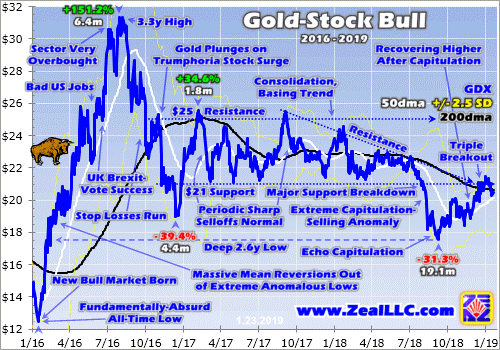

I’m not going to rehash this chart after analyzing it in depth just a few weeks ago. But scared gold-stock traders can take solace in some brief observations. First note the early-January-2019 pullback in GDX is far less severe than the early-January-2016 one. While that month birthed a monster upleg, it wasn’t all rainbows and unicorns until the very end. Weak-handed excitable traders had to be shaken out before the surge.
Second look at GDX’s solid upleg since early September 2018, which again rallied 22.3% at best over 3.7 months as of January 3rd. Uplegs are simply series of higher lows and higher highs often unfolding in a defined uptrend channel. All that still perfectly applies to GDX, its technicals remain very bullish. Both its upleg lows and highs are gradually marching higher, revealing zero technical strain on this young upleg.
Once again this upleg was born at GDX’s deep 2.6-year low of $17.57 on September 11th. Over the next few weeks into early October, GDX surged 8.4% to $19.05. Then it quickly pulled back to $18.39, which was still 4.7% above upleg-start levels. From there GDX powered up another 9.3% over the next couple weeks to $20.10 in late October. Then it suffered a bigger retreat to $18.42 by mid-November, still a higher low.
GDX rebounded strongly from there, surging another 16.6% to $21.48 by early January. And after such a strong run it slumped again to $20.31 last Friday. While it remains to be seen if that proves the latest upleg low, the higher lows so far have run $18.39, $18.42, and $20.31. And the higher highs clocked in at $19.05, $20.10, and $21.48. This is a textbook-perfect gold-stock upleg so far, offering nothing to worry about.
These higher lows and higher highs have formed an excellent uptrend channel for this upleg. Connecting these lows and highs creates parallel lower-support and upper-resistance lines. I didn’t draw them in this chart because they’d be difficult to see at this scale, but they are really well-defined. As of this week the support line extends near $19.50. So even if GDX slumped that low, its uptrend channel would remain intact.
Resistance now projects near $21.75, which would be another new upleg high. Odds are GDX will head back up there to challenge it in the coming few weeks or so. GDX may have started bouncing from last Friday’s level a bit under its 200-day moving average, which is now running $20.65. It could head a little lower first to its 50dma which is down near $20.14. And maybe it will even drop to $19.50 lower support.
It’s important to realize that as long as GDX remains above that uptrend-channel support line, its upleg is just fine. Any action over that is merely upleg noise that isn’t worth worrying about technically. It is normal for pullbacks within uplegs to bleed away bullishness and rekindle bearishness. That’s actually essential for uplegs’ health and longevity, keeping sentiment balanced so uplegs don’t prematurely burn out.
All the upside triple-breakout analysis and bullishness I discussed in early January remains valid and in force today. This gold-stock upleg has just paused, which is par for the course. All uplegs flow and ebb, gradually meandering higher on balance. None shoot up in straight lines, not even that monster one in H1’16. That was riddled with multiple strong selloffs, with one even hitting support below GDX’s 50dma.
The reason this young gold-stock upleg paused in recent weeks was gold’s own upleg stalled out. Gold miners’ stocks are ultimately just leveraged plays on gold. Their profits really amplify changes in gold’s price, which lets major gold miners’ stocks leverage gold’s underlying moves by 2x to 3x. Gold’s own young upleg that is driving gold stocks’ one hit its latest high near $1294 in early January the same day as GDX.
At that point gold had rallied 10.2% upleg-to-date, which GDX’s 22.3% upleg leveraged by a normal 2.2x in a similar span. Gold had bottomed a few weeks before the gold stocks, in mid-August instead of early September. Gold stocks’ performance relative to gold in this upleg has been normal. That leverage is often on the low side of its range early in young uplegs, then climbs to the high side later as momentum mounts.
At worst since its own January 3rd high, gold had slumped 1.0% to $1280 on last Friday. It is certainly no coincidence that is the exact span of gold stocks’ latest pullback. GDX’s young upleg will resume as soon as gold catches a bid again. That is dependent on gold investment demand resuming. It was strong in Q4, but faded significantly in January. This next chart looks at the leading proxy for gold investment demand.
That is the physical bullion holdings the dominant GLD SPDR Gold Shares gold ETF holds in trust for its shareholders. They are reported daily, a far-higher-resolution read than the quarterly supply-and-demand data from the World Gold Council. In last week’s essay I explained this chart in depth, analyzing why the capital flows into and out of GLD alone by American stock investors overwhelmingly drive the global gold price.
It superimposes GLD’s bullion holdings in blue over the gold price in red. Rising GLD holdings show that American stock-market capital is moving into gold via the conduit of this leading gold ETF. In Q4 and especially December gold surged higher on heavy differential buying of GLD shares. But in January that GLD buying has moderated. That’s why gold’s advance stalled out, which in turn drove gold stocks’ pause.
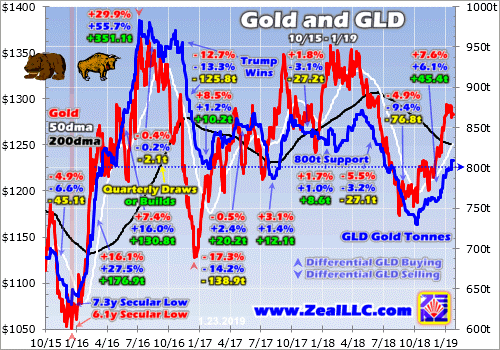

Again I discussed this chart just last week, so there’s no need for more comprehensive analysis. For our purposes today, note how GLD’s holdings climbed modestly in October and November after they had fallen to a deep 2.6-year secular low of their own in early October. GLD had suffered 5 consecutive monthly draws of 24.2 metric tons, 28.0t, 18.8t, 45.0t, and 12.9t between May and September, an ugly streak.
But that trend of American stock-market investors selling gold via GLD shares ended in early October. GLD enjoyed its first big build the very day the US stock markets suffered their first sharp plunge! That snowballed into an 11.8t build in October and 7.7t in November. That investment buying fueled modest gold rallies of 2.1% and 0.5% those months. Then in December that GLD-share buying really accelerated.
Last month enjoyed a sizable 25.9t build in GLD’s holdings, the biggest since September 2017. Those capital inflows fueled a much-larger 4.9% gold rally in December. When investment capital is flowing into gold, its price naturally climbs. And that in turn drives the gold miners’ stocks higher. Gold’s 2.1%, 0.5%, and 4.9% gains in the last several months drove parallel 2.2%, 0.8%, and 10.5% monthly rallies in GDX.
On the surface January has looked good too, with GLD’s holdings surging another 22.1t month-to-date as of the middle of this week. But nearly 9/10ths of that build came on only 2 trading days, January 2nd and 18th. Out of 15 trading days so far, January has seen 4 GLD-holdings build days, 3 draw days, and fully 8 unchanged. American stock investors’ differential GLD-share buying hasn’t been consistent this month.
That’s enabled gold-futures speculators to push gold modestly lower. Unfortunately we can’t know how much selling they’ve done, or whether it was exiting longs or adding new shorts, because of the federal-government partial shutdown. The weekly Commitments of Traders reports usually published by the CFTC haven’t been released since mid-December, so there is no data on gold-futures speculators’ trading.
But gold drifting lower this month despite a solid GLD build on balance proves they have to be selling. A sharp bounce in the US Dollar Index is a major factor driving those gold-futures sales. But the main one is the surging US stock markets. They are really retarding gold investment demand, making investors forget the wisdom of prudently diversifying their stock-heavy portfolios with gold. That has paused gold stocks.
The flagship U.S. S&P 500 broad-market stock index (SPX) plunged 19.8% over 3.1 months between late September and late December, a severe correction nearly entering bear-market territory. It was that SPX drop that reignited gold investment demand and fueled gold’s latest young upleg. Last week’s essay dug into this critical relationship between the SPX and gold. The SPX’s sharp rebound since weighed on gold demand.
Between the SPX’s Christmas Eve near-bear low and last Friday, this leading index rocketed up 13.6% in just several weeks! That violent bounce that looked and felt exactly like a bear-market rally nearly erased 4/7ths of the preceding correction. That has reignited widespread greed and complacency in the stock markets, the exact mission of bear rallies which are the biggest and fastest seen in all of stock-market history.
Gold stalled out in January because the SPX is surging so fiercely, retarding the impetus to diversify with gold. And the gold-stock upleg paused because gold stopped advancing. So this probable bear rally in the stock markets is to blame for gold stocks’ early-year weakness. But once these overbought U.S. stock markets roll over decisively again, gold psychology will flip back to favorable and big investment buying will resume.
When gold starts powering higher again, gold stocks will be off to the races. That portends big gains still coming in GDX, and even larger ones in its little brother GDXJ. It is effectively a mid-tier gold miners ETF these days, and its upleg gains during recent years’ bull market have outpaced GDX’s by about 1.4x on average. GDXJ simply has a better mix of gold miners than GDX, with fewer problems expanding production.
Yet the best gains by far won’t be won in the ETFs, but in the smaller mid-tier and junior gold miners with superior fundamentals. GDXJ still has deadweight in its top holdings, miners struggling with declining production and rising costs. The better gold miners are growing their output through new mine builds and expansions, generating greater gains. Finding and owning these better gold-mining stocks is essential.
The earlier you get deployed, the greater your gains will be. That’s why the trading books in our popular weekly and monthly newsletters are currently full of better gold and silver miners mostly added in recent months. The gains we won in 2016 were amazing the last time American stock investors returned to gold. Our newsletter stock trades that year averaged +111.0% and +89.7% annualized realized gains respectively!
The gold-stock gains should be similarly huge in this next major gold upleg. The gold miners are the last undervalued sector in these still-very-expensive stock markets, and rally with gold during stock-market bears unlike anything else. To multiply your wealth in the stock markets you have to do your homework and stay abreast, which our newsletters really help. They explain what’s going on in the markets, why, and how to trade them with specific stocks. You can subscribe today for just $12 per issue!
The bottom line is this young gold-stock upleg is just paused. The current technicals certainly don’t justify increasingly-bearish sentiment. This sector’s leading benchmark GDX is carving higher lows and higher highs, climbing on balance in a well-defined uptrend channel. Uplegs don’t shoot higher in straight lines, pullbacks within them are normal and expected. They serve to rebalance sentiment keeping uplegs healthy.
Gold stocks’ pullback this month was driven by gold’s own young upleg stalling. Strong gold investment demand fueled by recent months’ serious stock-market selloff moderated after stocks screamed higher in a violent bear-market-rally-like bounce. The resulting rekindled bullish psychology overshadowed gold again. But once stock-market selling resumes, so will the young uplegs in gold and its miners’ stocks.
Adam Hamilton, CPA
January 29, 2019
Copyright 2000 – 2019 Zeal LLC (www.ZealLLC.com)
by Morris Hubbartt
Jan 28, 2019
Here are today’s videos and charts (double-click to enlarge):
SFS Key Charts, Signals, & Video Analysis
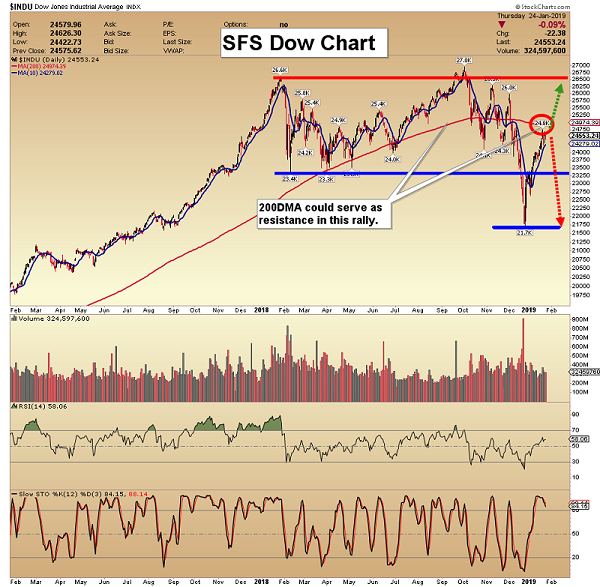

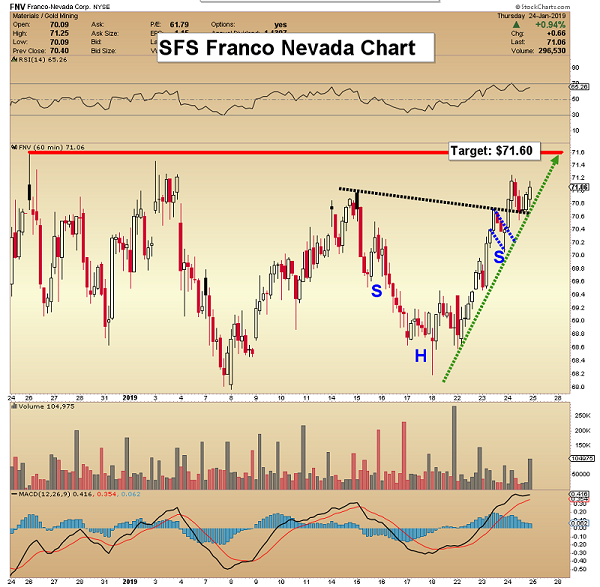

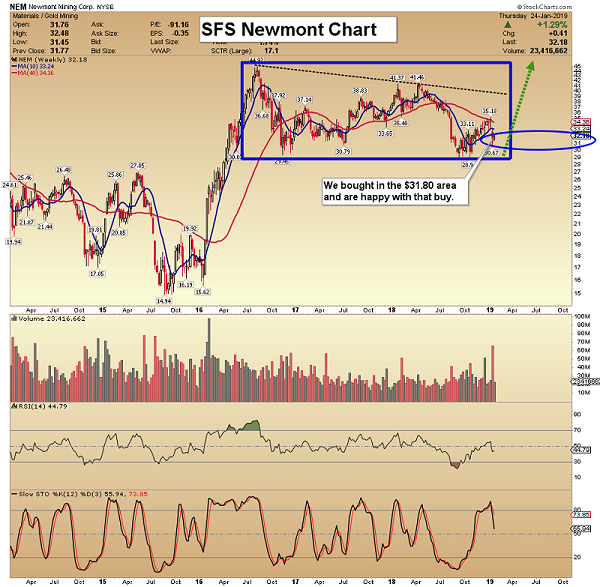

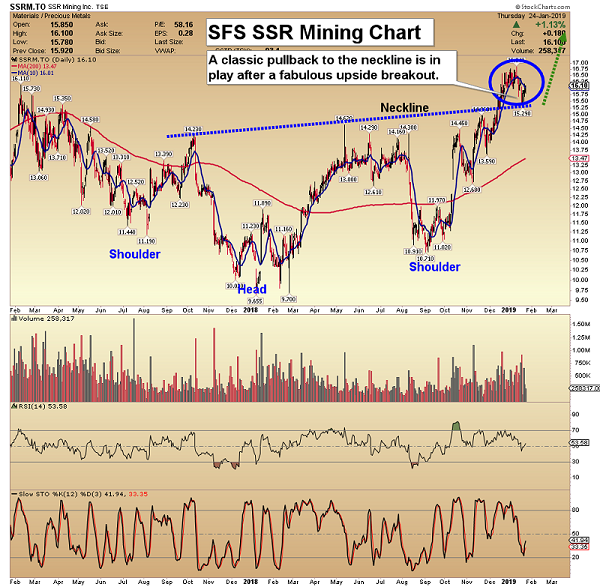

SF60 Key Charts, Signals, & Video Analysis
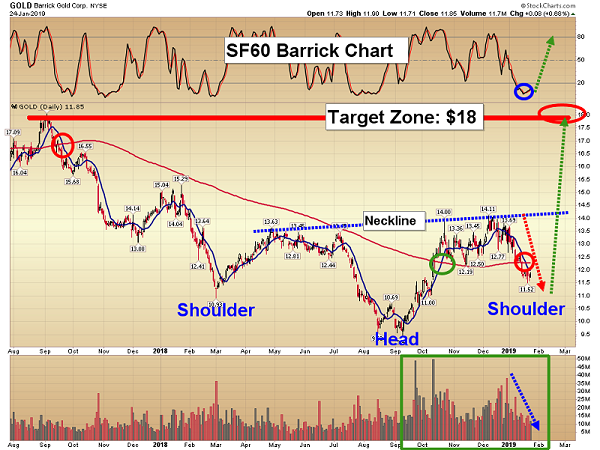

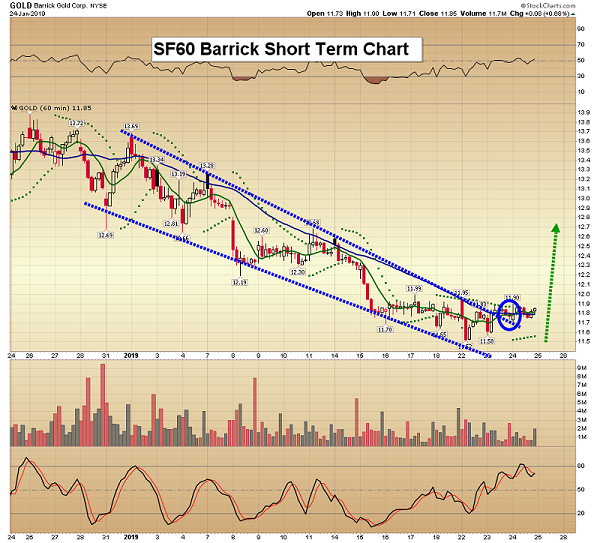

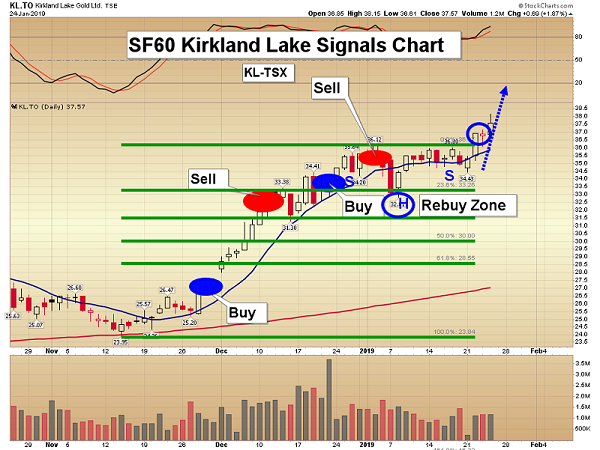

SF Trader Key Charts, Signals, & Video Analysis
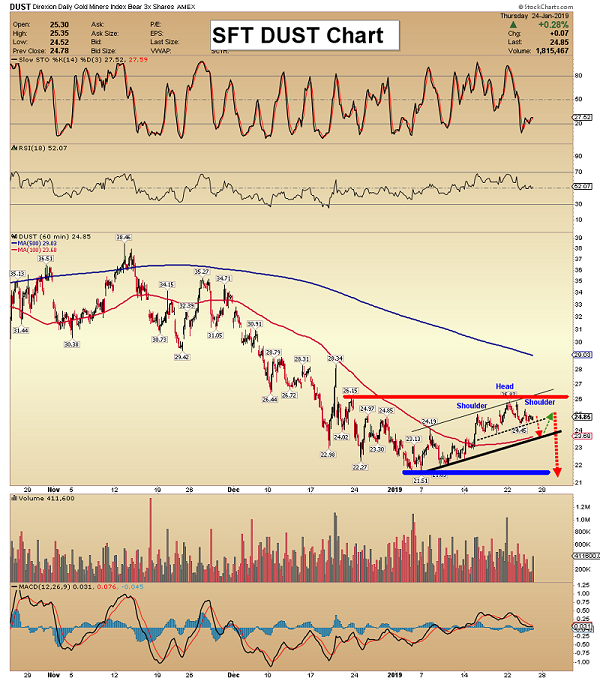

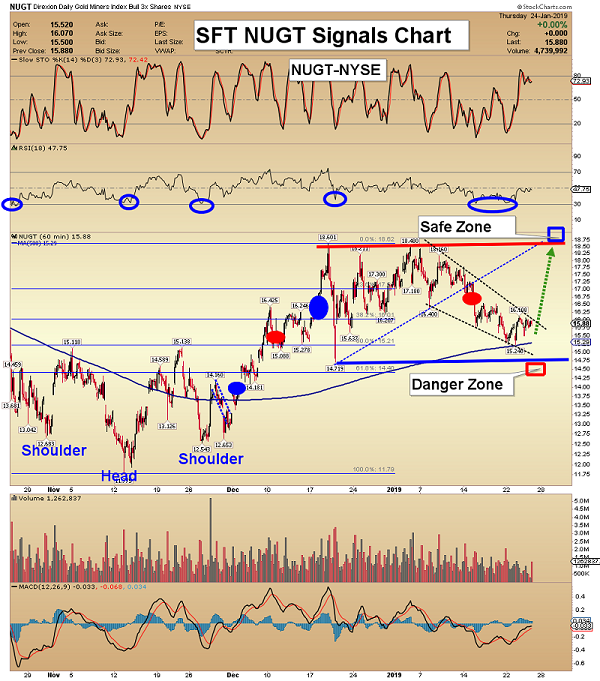

SFJ Key Charts, Signals, & Video Analysis
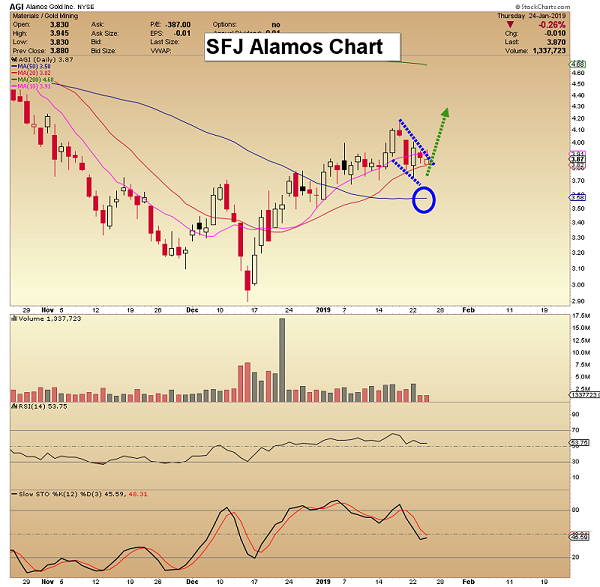

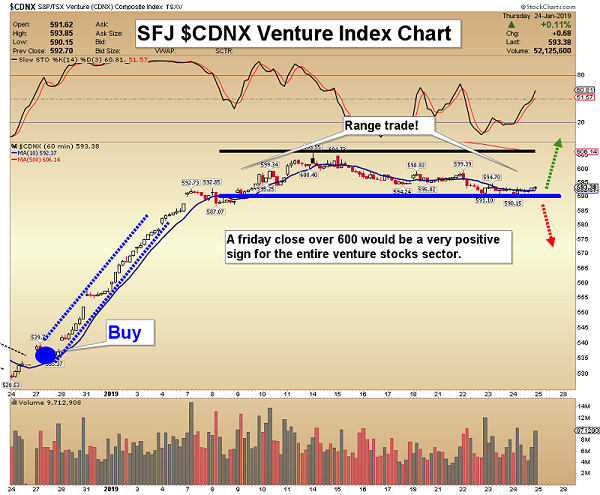

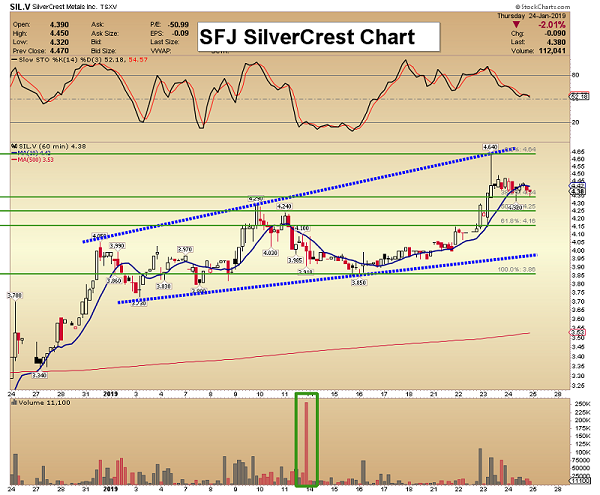

Thanks,
Morris Hubbartt
Unique Introduction For Website Readers: Send me an email to signals@superforcesignals.com and I’ll send you 3 of my next Super Force Surge Signals free of charge, as I send them to paid subscribers. Thank you!
Stay alert for our Super Force alerts, sent by email to subscribers, for both the daily charts on Super Force Signals at www.superforcesignals.com and for the 60 minute charts at www.superforce60.com
About Super Force Signals:
Our Super Force signals are created thru our proprietary blend of the highest quality technical analysis and many years of successful business building. We are two business owners with excellent synergy. We understand risk and reward. Our subscribers are generally successful business owners, people like yourself with speculative funds, looking for serious management of your risk and reward in the market.
Frank Johnson: Executive Editor, Macro Risk Manager.
Morris Hubbartt: Chief Market Analyst, Trading Risk Specialist.
Email:
- Is the price correction in gold already over?
- Please click here now. Double-click to enlarge. I told investors to prepare for a modest and healthy correction from the $1300 area, and that’s happened.
- Gold hasn’t even reached the first Fibonacci retracement line after staging a magnificent rally from the $1173 area. That’s a sign of immense technical strength.
- Please click here now. Double-click to enlarge. Silver has carved out a beautiful double bottom pattern. It’s now staging a textbook pullback to the neckline of that pattern.
- Whether the precious metals market correction is over or has a bit further to go is not important. What matters is the fundamental picture. That picture is healthy, and it’s about to get exponentially healthier.
- Please click here now. The odds of an import tax cut in the world’s most important gold market are higher now than at any point since the taxes were ramped up in 2012-2013.
- “You need the Indians to buy oil or gold.” – Jeff Currie, Global Head of Commodities Research, Goldman Sachs, Jan 16, 2019. Jeff says, “Buy commodities.”
- While senior citizens in the Western gold community may long for what is essentially a remake of the 1970s fear trade oriented gold market, today’s gold market is mainly about the rise of gold as a respected asset class. That’s being created by the ongoing rise of China and India as economic titans.
- Today’s Western fear trade for gold is more like icing on that cake than the centre stage price driver that it was in the 1970s.
- In a nutshell, a “goldaholic army” of three billion Chindian citizens is becoming wealthier at a very fast pace. That’s creating annual gold demand growth of 6%-8% that is essentially relentless. Mine supply can’t seem to grow more than 2%.
- It’s becoming a “no-brainer” that the gold price will rise consistently for decades to come, and probably for the next two centuries.
- The current price correction in gold is likely almost entirely due to the actions of Indian dealers operating on both China’s SGE and in Mumbai. They are in “quiet mode” ahead of the February budget that is expected to bring a significant cut in the import tax.
- In their eyes, there’s simply no point buying gold now when they can likely get it 5% cheaper in just a few weeks. Also, a duty cut would create a positive vibe amongst Indian citizens similar to the vibe created by Donald Trump’s MAGA program.
- The “minor” difference, of course, is that India is an gold-oriented emerging empire with the best citizen demographics and strongest GDP growth in the world. The bottom line: The current price correction in gold is probably the healthiest and most stable since the price corrections of 2003-2004.
- While today’s gold cake is Chindian, the icing is pretty tasty too. On that note, please click here now. Only 37% of America’s business leaders are optimistic. Top bank economists almost universally predict U.S. corporate earnings growth will fade from the 20%+ level to single digits and GDP will slide towards 1% by year-end.
- My recommendation for stock market investors is to focus on my short term guswinger.com signals for UDOW and SDOW while waiting for a major US business cycle trough. Once the trough happens (years from now) investors can begin accumulating big name US stocks using my unique pyramid generator to gracefully tranche into the market.
- US politicians promise citizens and corporations that enormous tariff taxes will “Make ‘Em Great”. This, while US blue collar workers are struggling with wages that are still below 1968 levels in real terms. These workers don’t need walls around an entitlements-themed ecosystem. They need serious tax cuts (all the way to zero) and they are just not happening.
- A single corporate tax cut to only the 20% level is not enough to make America great again, especially when there’s no corresponding chop in the size of government. Income tax, property tax, and capital gains tax need to be eliminated and replaced with a goods/service and financial transaction tax. That would reduce the size of the government dramatically and bring trillions of investment dollars roaring into the country.
- America could easily become a super-sized version of Switzerland, but in the eyes of its biggest hedge fund manager Ray Dalio, the country is instead staging an almost macabre debt-obsessed dance that ends with: Inflationary depression!
- America’s terrible population demographics and entitlements-oriented society are a giant drag on long term GDP growth. Business leaders know they can’t supply the government and the entitlements-obsessed citizens with anywhere near the amount of capital required to maintain this bizarre system.
- That’s spurring U.S. institutional interest in gold, and it’s happening as India’s government is about to follow China’s lead and endorse gold as a respected asset class.
- Gold is becoming an asset class like stocks and real estate that is not owned as a market “hedge” but for long term capital appreciation.
- Please click here now. Western institutional money has flowed into the key SPDR gold bullion ETF as the price has softly corrected from the $1300. That’s another sign of a very healthy market.
- Please click here now. Double-click to enlarge. As with gold, the correction in most gold stocks could be over! Note the bull wedge in play and the soft volume on the recent price decline. Now there’s a spike in volume and that could mark the end of price softness. A sell-off in the US stock market seems imminent, and I told gold stock enthusiasts in August to expect solid action from GDX in a stock market meltdown. That’s exactly what transpired… and the same thing is likely about to happen again!
Special Offer For Website Readers: Please send me an Email to freereports4@gracelandupdates.com and I’ll send you my free “Senior Gold Stock Superstars!” report. I highlight ten senior gold stocks that are poised to benefit from even a small gold price rally. I include key buy and sell tactics for both traders and investors!
Stewart Thomson
Graceland Updates
Email:
Risks, Disclaimers, Legal
Stewart Thomson is no longer an investment advisor. The information provided by Stewart and Graceland Updates is for general information purposes only. Before taking any action on any investment, it is imperative that you consult with multiple properly licensed, experienced and qualified investment advisors and get numerous opinions before taking any action. Your minimum risk on any investment in the world is: 100% loss of all your money. You may be taking or preparing to take leveraged positions in investments and not know it, exposing yourself to unlimited risks. This is highly concerning if you are an investor in any derivatives products. There is an approx $700 trillion OTC Derivatives Iceberg with a tiny portion written off officially. The bottom line:
Are You Prepared?
Last week we discussed the difference between a rally and bull market.
Gold stocks have been in a rally.
That rally is now over as gold stocks peaked at their 400-day moving averages days ago and sliced through their 200-day moving averages Friday.
Take a look at the charts of any gold stock index (GDX, GDXJ, HUI) and it’s clear they are in a downtrend.
Go back two to three years. You’ll see lower highs and lower lows. That’s a downtrend!
Until that changes, we have to respect that.
The change will come when the market knows the Fed is done hiking and anticipates the start of rate cuts.
Going back 65 years, I counted 13 times when the Fed went from rate hikes to rate cuts. The average gain in gold stocks during 11 of those periods was 172%.
The moves higher began an average and median of three to four months after the time of the last hike.
If the final hike is in March or June then the bull run should begin around the average time frame. If December 2018 was the final hike, then obviously the move higher could begin after the average or median period.
The immediate risk is the gold stocks could be starting another leg lower. In the chart below, we see similarities between GDX today and where it was in Q2 2015.
At both junctures the market had finished rallying after breaking down from a long consolidation. Note the points 1,2,3 and also the similarities in the advance-decline line. One positive difference is GDX relative to the stock market has surpassed its 200-day moving average.
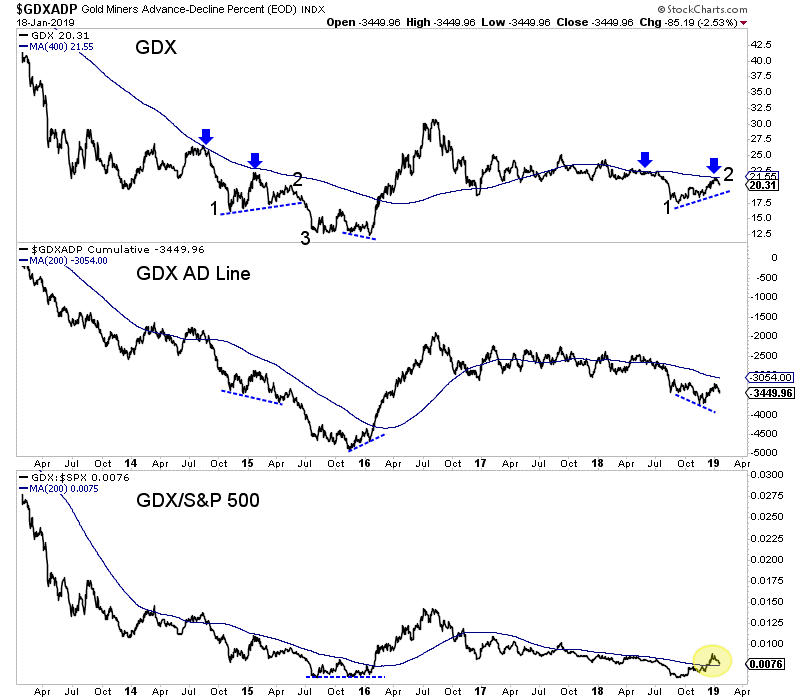

In summation, we are looking for one more leg lower before a potential historic buying opportunity in precious metals. How much lower and for how long could depend on how soon the market is certain the Fed is done hiking.
There is no need to chase anything now as there will be plenty of time to get into cheap juniors that can triple and quadruple once things really get going. Recall that many juniors began huge moves months after epic sector lows in January 2016, October 2008, May 2005 and November 2000. Don’t chase the wrong stocks right now. To prepare yourself for some epic buying opportunities in junior gold and silver stocks, consider learning more about our premium service.
by Captain Ewave
Gold:
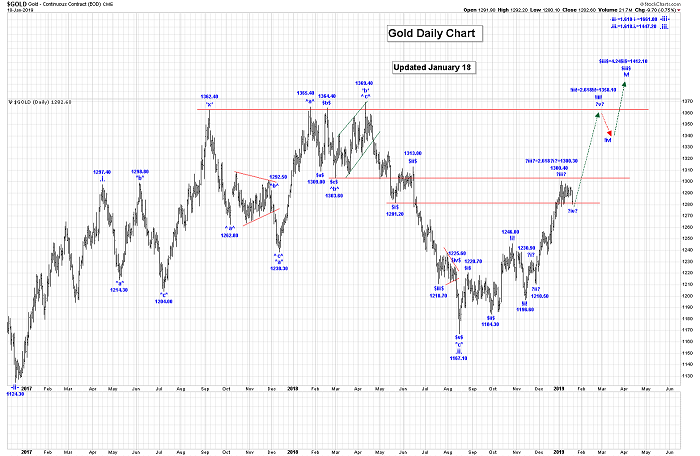

Short Term Update:
Within wave .iii. we continue to work on our first impulsive sequence, as shown on the daily gold chart.
We have taken a very bullish approach and are working on the assumption that only wave ?iii? ended at the 1300.40 high and that we are now correcting in wave ?iv?.
Our retracement levels for wave ?iv? are:
23.6% = 1279.20
38.2% = 1266.10
On the intraday chart it now looks like wave ?iv? has become more complex than just a simple bullish triangle, and we should expect gold to move back to at least the 1278.20 level, before wave ?iv? ends.
Wave ?iv? does include a small bearish triangle within its internal corrective pattern. Once wave ?iv? ends we expect another push higher in wave ?v? to complete all of !iii!. Our next projected target for the end of wave ?v? and !iii! is:
!iii! = 2.168!i! = 1358.40
We do have higher projections and wave .iii. should subdivide into a 5 wave impulsive sequence in its journey higher.
This triangle pattern will only be eliminated if we now trade below the 1278.10 low.
Even if this triangle pattern is eliminated the trading patterns on the intraday chart still suggest that the drop from the wave ?iii? high of 1300.40 is corrective, which supports higher prices ahead!
Our first projection for the end of wave .iii. is:
.iii. = 1.618.i. = 1447.20
Weekly Gold Chart:
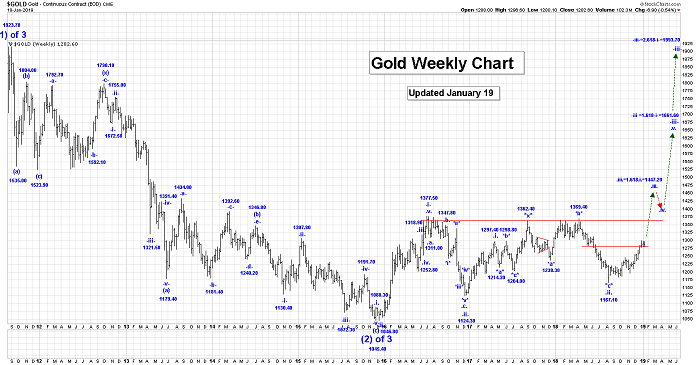

Longer term, our projections for the end of wave -iii-, as shown on this weekly gold chart, are:
-iii-=1.618-i-=1661.80
-iii-=2.618-i-=1993.70
Trading Recommendation: Go long gold. Use puts as stops.
Free Offer For Website Readers: Please send me an Email to admin@captainewave.com and I’ll send you our key “Silver Surge: Is This For Real?” report! We focus on a powerful silver stock as well as key short and long term charts for silver bullion. We include tactical approaches to make money on the current wave counts action!
Thank-you!
Captain Ewave & Crew
Email: admin@captainewave.com
Website: www.captainewave.com
Free Offer For Website Readers: Please send me an Email to admin@captainewave.com and I’ll send you our key “Silver Surge: Is This For Real?” report! We focus on a powerful silver stock as well as key short and long term charts for silver bullion. We include tactical approaches to make money on the current wave counts action!
Thank-you!
Captain Ewave & Crew
Email: admin@captainewave.com
Website: www.captainewave.com
Risk: CAPTAINEWAVE.COM IS AN IMPERSONAL ADVISORY SERVICE. AND THEREFORE, NO CONSIDERATION CAN OR IS MADE TOWARD YOUR FINANCIAL CIRCUMSTANCES. ALL MATERIAL PRESENTED WITHIN CAPTAINEWAVE.COM IS NOT TO BE REGARDED AS INVESTMENT ADVICE, BUT FOR GENERAL INFORMATIONAL PURPOSES ONLY. TRADING STOCKS DOES INVOLVE RISK, SO CAUTION MUST ALWAYS BE UTILIZED. WE CANNOT GUARANTEE PROFITS OR FREEDOM FROM LOSS. YOU ASSUME THE ENTIRE COST AND RISK OF ANY TRADING YOU CHOOSE TO UNDERTAKE. YOU ALSO AGREE TO BEAR COMPLETE RESPONSIBILITY FOR YOUR INVESTMENT RESEARCH AND DECISIONS AND ACKNOWLEDGE THAT CAPTAINEWAVE.COM HAS NOT AND WILL NOT MAKE ANY SPECIFIC RECOMMENDATIONS OR GIVE ADVICE TO YOU OR ANY OF ITS CLIENTS UPON WHICH THEY SHOULD RELY. CAPTAINEWAVE.COM SUGGESTS THAT THE CLIENT/MEMBER TEST ALL INFORMATION AND TRADING METHODOLOGIES PROVIDED AT OUR SITE THROUGH PAPER TRADING OR SOME OTHER FORM OF TESTING. CAPTAINEWAVE.COM, ITS OWNERS, OR ITS REPRESENTATIVES ARE NOT REGISTERED AS SECURITIES BROKER-DEALERS OR INVESTMENT ADVISORS EITHER WITH THE U.S. SECURITIES AND EXCHANGE COMMISSION OR WITH ANY STATE SECURITIES REGULATORY AUTHORITY. WE RECOMMEND CONSULTING WITH A REGISTERED INVESTMENT ADVISOR, BROKER-DEALER, AND/OR FINANCIAL ADVISOR. IF YOU CHOOSE TO INVEST WITH OR WITHOUT SEEKING ADVICE FROM SUCH AN ADVISOR OR ENTITY, THEN ANY CONSEQUENCES RESULTING FROM YOUR INVESTMENTS ARE YOUR SOLE RESPONSIBILITY.
ALL INFORMATION POSTED IS BELIEVED TO COME FROM RELIABLE SOURCES. CAPTAINEWAVE.COM DOES NOT WARRANT THE ACCURACY, CORRECTNESS, OR COMPLETENESS OF INFORMATION AVAILABLE FROM ITS SERVICE AND THEREFORE WILL NOT BE LIABLE FOR ANY LOSS INCURRED. DUE TO THE ELECTRONIC NATURE OF THE INTERNET, THE CAPTAINEWAVE.COM WEBSITE, ITS E-MAIL & DISTRIBUTION SERVICES AND ANY OTHER SUCH “ALERTS” COULD FAIL AT ANY GIVEN TIME. CAPTAINEWAVE.COM WILL NOT BE RESPONSIBLE FOR UNAVAILABILITY OF USE OF ITS WEBSITE, NOR UNDELIVERED E-MAILS, OR “ALERTS” DUE TO INTERNET BANDWIDTH PROBLEMS, EQUIPMENT FAILURE, OR ACTS OF GOD. CAPTAINEWAVE.COM DOES NOT WARRANT THAT THE TRANSMISSION OF E-MAILS, OR ANY “ALERT” WILL BE UNINTERRUPTED OR ERROR-FREE. CAPTAINEWAVE.COM WILL NOT BE LIABLE FOR THE ACTS OR OMISSIONS OF ANY THIRD PARTY WITH REGARDS TO CAPTAINEWAVE.COM DELAY OR NON-DELIVERY OF THE CAPTAINEWAVE.COM NIGHTLY EMAILS OR “ALERTS”. FURTHER, WE DO NOT RECEIVE ANY FORM OF PAYMENT OR OTHER COMPENSATION FOR PUBLISHING INFORMATION, NEWS, RESEARCH OR ANY OTHER MATERIAL CONCERNING ANY SECURITIES ON OUR SITE OR PUBLISH ANY INFORMATION ON OUR SITE THAT IS INTENDED TO AFFECT OR INFLUENCE THE VALUE OF SECURITIES.
THERE IS NO GUARANTEE PAST PERFORMANCE WILL BE INDICATIVE OF FUTURE RESULTS. NO ASSURANCE CAN BE GIVEN THAT THE RECOMMENDATIONS OF CAPTAINEWAVE.COM WILL BE PROFITABLE OR WILL NOT BE SUBJECT TO LOSSES. ALL CLIENTS SHOULD UNDERSTAND THAT THE RESULTS OF A PARTICULAR PERIOD WILL NOT NECESSARILY BE INDICATIVE OF RESULTS IN FUTURE PERIODS. THE RESULTS LISTED AT THIS WEBSITE ARE BASED ON HYPOTHETICAL TRADES. PLAINLY SPEAKING, THESE TRADES WERE NOT ACTUALLY EXECUTED. HYPOTHETICAL OR SIMULATED PERFORMANCE RESULTS HAVE CERTAIN INHERENT LIMITATIONS. UNLIKE AN ACTUAL PERFORMANCE RECORD, SIMULATED TRADES DO NOT REPRESENT ACTUAL TRADING. ALSO, SINCE THE TRADES HAVE NOT ACTUALLY BEEN EXECUTED, THE RESULTS MAY HAVE OVER OR UNDER COMPENSATED FOR THE IMPACT, IF ANY, OF CERTAIN MARKET FACTORS SUCH AS LACK OF LIQUIDITY. YOU MAY HAVE DONE BETTER OR WORSE THAN THE RESULTS PORTRAYED. NO REPRESENTATION IS BEING MADE THAT ANY ACCOUNT WILL OR IS LIKELY TO ACHIEVE PROFITS OR LOSSES SIMILAR TO THOSE SHOWN. NO INDEPENDENT PARTY HAS AUDITED THE HYPOTHETICAL PERFORMANCE CONTAINED AT THIS WEBSITE, NOR HAS ANY INDEPENDENT PARTY UNDERTAKEN TO CONFIRM THAT THEY REFLECT THE TRADING METHOD UNDER THE ASSUMPTIONS OR CONDITIONS SPECIFIED HEREAFTER. WHILE THE RESULTS PRESENTED AT THIS WEBSITE ARE BASED UPON CERTAIN ASSUMPTIONS BELIEVED TO REFLECT ACTUAL TRADING CONDITIONS, THESE ASSUMPTIONS MAY NOT INCLUDE ALL VARIABLES THAT WILL AFFECT, OR HAVE IN THE PAST AFFECTED, THE EXECUTION OF TRADES INDICATED BY CAPTAINEWAVE.COM. THE HYPOTHETICAL RESULTS ON THIS WEBSITE ARE BASED ON THE ASSUMPTION THAT THE CLIENT BUY AND SELLS THE POSITIONS AT THE OPEN PRICE OF THE STOCK. THE SIMULATION ASSUMES PURCHASE AND SALE PRICES BELIEVED TO BE ATTAINABLE. IN ACTUAL TRADING, PRICES RECEIVED MAY OR MAY NOT BE THE SAME AS THE ASSUMED ORDER PRICES.
Gold investment demand reversed sharply higher in recent months, fueling a strong gold rally. The big stock-market selloff rekindled interest in prudently diversifying stock-heavy portfolios with counter-moving gold. These mounting investment-capital inflows into gold are likely to persist and intensify. Both weaker stock markets and higher gold prices will continue to drive more investment demand, growing gold’s upleg.
Early in Q4’18, gold reached a major inflection point. It languished during the first three quarters of 2018, down 8.5% year-to-date by the end of Q3. Investors wanted nothing to do with alternative investments with the stock markets powering to new record highs. The flagship S&P 500 broad-market stock index (SPX) had rallied 9.0% in the first 3/4ths of last year. That left gold deeply out of favor heading into Q4.
But a critical psychological switch was flipped as the SPX started sliding last quarter. After long years with little material downside, stock traders had been lulled into overpowering complacency. They were shocked awake as the SPX plunged 14.0% in Q4, its worst quarter since Q3’11. They poured back into gold as stocks burned, driving it a strong 7.6% higher in Q4! Rekindled investment demand was the driver.
Unfortunately gold investment demand is rather murky. Gold is bought and sold every day all over the world, in countless venues ranging from major exchanges to tiny third-world merchants. Tracking even the majority of this in real-time is impossible. The best-available data on global gold investment comes from the World Gold Council. But it is only published once per quarter, about a month after quarter-ends.
I can’t wait to see the WGC’s new Q4’18 Gold Demand Trends report due out in early February. These quarterly GDTs are very well done and essential reading for all investors. But while detailed and informative, their resolution is really low only being released 4 times per year. Investors need alternative data sources to understand and game what’s going on with gold investment demand between the GDTs, like now.
Thankfully there’s an excellent proxy of investors’ capital flows into and out of gold published daily, a high-resolution read. It is the physical gold bullion held in trust for the shareholders of the world’s dominant gold exchange-traded fund. That of course is the American GLD SPDR Gold Shares. GLD was created and launched by the World Gold Council way back in November 2004, and has grown into a gold juggernaut.
As part of the WGC’s GDT work each quarter, it tracks the world’s top 10 physically-backed gold ETFs. At the end of Q3’18 when you could hardly give away gold to American investors, GLD’s holdings still accounted for nearly 32% of the world’s top-10 gold-ETF total. Add in the 2nd-largest ETF which is also American, the IAU iShares Gold Trust, and these two leading ETFs control over 3/7ths of the global top-10 total.
The primary constituency for American gold ETFs is American stock investors. So what they are doing in terms of capital flows through GLD especially is exceedingly important for gold. In recent years most of the major quarterly moves in gold prices are nearly fully explainable by GLD’s holdings alone! They must be watched daily, as changes in them have proven the key to gold’s fortunes. It’s important to understand why.
The American stock markets are the biggest in the world, and American investors’ capital is vast beyond compare. At the end of Q3’18, the collective market capitalization of the 500 elite SPX stocks alone was a staggering $26,141.4b. By comparison, GLD’s total physical-gold-bullion holdings of 742.2 metric tons were only worth $28.4b. That’s less than 1/9th of a single percent, which for all intents and purposes is zero.
Thus if even the tiniest fraction of U.S. stock-market capital migrates into or out of GLD shares, gold itself moves big. This dominant gold ETF effectively acts as a conduit between stock-market capital and gold. But as these colossal pools of capital slosh into and out of GLD, it is always at risk of failing its mission of tracking the gold price. The supply and demand of GLD shares and gold are independent of each other.
So differential buying or selling of GLD shares by American stock investors must be directly equalized into the underlying global gold market. This mechanism is simple in concept. When GLD shares are being bought faster than gold itself, this ETF’s price threatens to decouple from gold’s price to the upside. To prevent this, GLD’s managers need to shunt that excess GLD-share demand directly into gold in real-time.
They issue enough new GLD shares to offset that excess demand, and then use the proceeds to buy physical gold bullion held in trust for GLD’s shareholders. So when GLD’s daily holdings are rising, that reveals American stock-market capital is flowing into gold. This GLD capital pipeline into gold also works similarly on the downside, when American stock investors dump GLD shares faster than gold is being sold.
GLD’s share price will soon disconnect from gold’s price to the downside. This ETF’s managers avoid that by buying back GLD shares to sop up the excess supply. They raise the capital to do this by selling some of GLD’s physical-gold-bullion holdings. So when GLD’s daily holdings are falling, American stock-market capital is being pulled back out of gold. These holdings closely mirror world gold-investment trends.
My chart this week compares GLD’s daily gold holdings in metric tons with the gold price over the past several years or so. After falling to a major 6.1-year secular low in December 2015, gold started powering higher in a new bull market. Since gold hasn’t retreated 20%+ from its bull-to-date peak in July 2016, this bull remains alive and well. It has been overwhelmingly driven by American stock-market capital flows via GLD.
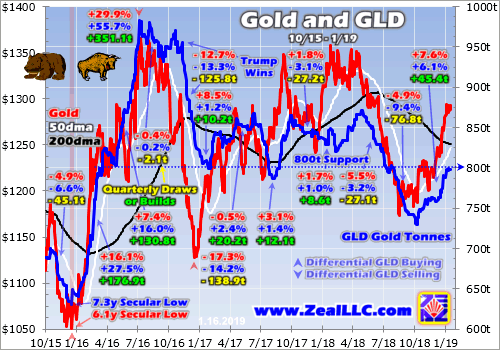

Let’s start in the middle of 2018, when GLD’s holdings were stable above 800t which has proven major support for this bull market. In much of the first half of last year, the stock markets were largely grinding sideways after the SPX suffered a sharp-yet-shallow-and-short correction in early February. The SPX finally started climbing decisively again in early Q3, ultimately achieving 5 new all-time record highs in that quarter.
That stoked incredible euphoria, convincing investors these amazing stock markets could rally indefinitely. By late September the SPX had skyrocketed 333.2% higher over 9.5 years, making for the 2nd-largest and 1st-longest stock bull in U.S. history! With general stocks looking invincible, there was little incentive to prudently diversify stock-heavy portfolios with gold. American stock investors were actually fleeing it.
In Q3 they sold GLD shares so aggressively that it forced a serious 76.8t or 9.4% draw in GLD’s holdings! All that selling pressure pushed world gold prices 4.9% lower that quarter. And GLD alone was mostly responsible. The WGC’s Q3 GDT showed total global gold demand actually grew a slight 0.6% year-over-year that quarter to 964.3t. Every major demand category grew considerably with a lone exception.
Global investment demand plunged 20.8% YoY to 194.9t. The WGC breaks it out into two major sub-categories, physical bar-and-coin demand and gold-ETF demand. The former was very strong, surging 28.0% YoY to 298.1t. But the latter plummeted from +13.2t in Q3’17 to -103.2t in Q3’18! Gold would’ve rallied nicely that quarter if not for GLD, which accounted for a commanding 2/3rds of that total world ETF drop.
When American stock investors are sustaining selling GLD shares faster than gold is being sold, it forces the world gold price lower. That serious Q3’18 GLD-holdings draw was the worst by far since back in Q4’16. That was when Trump’s surprise election victory with Republicans controlling both chambers of Congress ignited a major stock-market rally on hopes for big tax cuts soon. The resulting euphoria hammered gold.
While the SPX only climbed 3.3% in Q4’16, 8 new all-time record highs were achieved. American stock investors jettisoned gold with reckless abandon, both to chase that stock surge and out of relief that the political uncertainty didn’t trigger a stock selloff as feared. The differential GLD-share selling proved so intense that this ETF suffered a colossal 125.8t or 13.3% holdings draw, which crushed gold 12.7% lower!
Total world gold demand per the latest WGC GDT dropped 103.4t or 9.0% YoY that quarter. That huge GLD draw alone was 122% of that! Overall global gold-ETF demand fell 107.0t from -66.4t in Q4’15 to -173.4t in Q4’16. GLD’s draw was 118% of that. So literally the only reason gold plunged in Trump’s election quarter was American stock investors pulling big capital out of GLD forcing it to sell physical gold bullion.
Compared to that extreme dump, gold was relatively resilient in Q3’18. While GLD’s draw ran 61% of that Q4’16 episode, gold only declined 39% as much. There were hints the stock markets were ready to roll over into a long-overdue new bear. On Q3’s final trading day with the SPX just under its recent record peak, I published an essay explaining why Q4’s first-ever full-speed Fed QT was this stock bull’s death knell.
Indeed within a week of Fed QT ramping up to $50b per month of monetary destruction, the SPX started to falter. Its first serious down day erupted on October 10th when this leading stock-market benchmark plunged 3.3%. That triggered a major sentiment shift in gold. GLD enjoyed a large 1.2% holdings build that day on heavy differential GLD-share buying. Those were its first capital inflows at all since late July.
That very day American stock investors’ faith in perpetually-levitating stock markets started to crack, they started remembering gold. As Q4 wore on and that SPX selloff snowballed into a 4%+ pullback, a 10%+ correction, and narrowly missed new-bear-market territory at -19.8% on Christmas Eve, gold investment demand continued growing. Tending to rally when stocks fall, gold is essential for wisely diversifying portfolios.
By the time the dust settled on Q4, American stock-market capital sloshing back into gold via that GLD conduit had fueled a 45.4t or 6.1% holdings build. That was the biggest by far since way back in Q2’16 soon after this latest gold bull was born. All that differential GLD-share buying forced gold 7.6% higher in Q4 as the SPX plunged 14.0%. The WGC’s coming Q4’18 GDT will likely prove GLD largely drove gold’s gains.
The last time American stock investors started returning to gold after stock-market corrections spooked them was in the first half of 2016. Remember gold had just slumped to a major 6.1-year secular low, so it was deeply out of favor suffering incredibly-bearish sentiment. Yet in Q1’16 GLD’s holdings skyrocketed an epic 176.9t of 27.5% higher, which catapulted gold up 16.1%. Nothing else mattered per the WGC.
Overall world gold demand soared 188.1t or 17.1% YoY that quarter. GLD’s enormous build driven by American stock investors returning to gold accounted for an amazing 94% of that! If their vast pools of capital hadn’t sloshed back into gold via GLD that quarter, this bull never would’ve been born. And that utter dominance of American stock-market-capital inflows through GLD persisted in the subsequent quarter.
In Q2’16 gold surged another 7.4% higher on a 130.8t or 16.0% GLD-holdings build. The WGC reports that total world gold demand climbed 123.5t or 13.2% YoY that quarter. GLD’s huge build alone was responsible for 106% of that. So again without American stock-market capital moving into gold through that leading GLD conduit, that initial gold-bull upleg wouldn’t even exist. GLD dominates the gold world.
There have been 13 quarters since Q4’15 when today’s gold bull was born. 8 of them have seen major gold moves higher or lower. In all but one of these cases, GLD’s builds or draws accounted for the vast majority of the overall yearly change in total world gold demand. In the remaining 5 quarters where gold ground sideways or moved comparatively modestly, GLD’s holdings didn’t change very much either.
So there’s no doubt GLD’s strong build in Q4’18 ignited and fueled by this new SPX selloff is an important omen for gold. Once American stock investors start buying gold again via GLD shares in a big way, the resulting major gold uplegs tend to become self-feeding. Investors love chasing performance. The higher gold rallies, the more stock investors want to own GLD. And the more GLD they buy, the faster gold climbs.
And while correction-grade 10%+ stock-market selloffs are the catalysts that trigger renewed investment demand for gold, it usually persists well after the SPX bottoms and bounces. In essentially the first half of 2016, gold blasted 29.9% higher in just 6.7 months. That was totally fueled by an epic 351.1t or 55.7% build in GLD’s holdings as American stock investors rushed back into gold. That upleg peaked in early July.
But the 13.3% SPX correction that spawned it actually bottomed in mid-February. Over the following 4.9 months leading into gold’s top, the SPX blasted 16.4% higher! Nearly 3/4ths of gold’s upleg duration came after the stock selloff that ignited it, and just over 3/4ths of GLD’s upleg build also happened after the SPX had bottomed. Major gold uplegs take on a life of their own after being triggered by stock selloffs.
So even if today’s stock selloff ended at a severe correction on Christmas Eve and this record bull still has farther to run, gold investment demand should remain strong on upside momentum. But far more likely the long-overdue young new stock bear is being born. The SPX’s enormous and violent surge since that deep Christmas Eve low looks exactly like a classic bear-market rally technically, an ominous sign.
Bear-market rallies are the biggest and fastest ever witnessed in all of stock-market history. They soar out of major lows in sharp V-bounces on frantic short covering, then gradually run out of momentum over a couple to few weeks. If the stock markets are indeed rolling over into a new bear, far more weakness is guaranteed over the next couple years or so. That will fuel sustained gold-investment-demand growth.
Bear markets in stocks following major bulls are nothing to be trifled with. The last couple bears in the early and late 2000s saw the SPX fall 49.1% over 2.6 years and 56.8% over 1.4 years! 50% bears are common and expected after large bulls. And if we are early in the next bear, gold will likely be the top-performing asset class while it runs its course. American stock investors buying GLD shares will lead the way.
So far in January 2019, this huge apparent bear-market rally in the SPX has stalled investment demand for gold. Like many bear rallies, it has rekindled great greed and complacency. So GLD hasn’t experienced many significant builds yet in this young new year. But those capital inflows will return with a vengeance once the SPX starts rolling over and weakening again, likely driving gold sharply higher like in early 2016.
Again that sustained investment demand in H1’16 catapulted the yellow metal 29.9% higher pretty much exclusively on differential GLD-share buying. A mere 20% upleg off gold’s recent mid-August low driven by record gold-futures short selling would catapult it back up over $1400. Anything above the bull-to-date peak of $1365 in July 2016 is going to unleash a flood of new investor excitement in gold and big demand.
So this gold bull is likely to grow a lot larger in coming quarters. The greatest beneficiaries will be the gold miners’ stocks, as their profits leverage gold’s gains. Roughly during that mostly-H1’16 major gold upleg, the leading GDX and GDXJ gold-stock ETFs rocketed 151.2% and 202.5% higher! The better gold stocks with good fundamentals are going to soar again during gold’s next upleg, which is already well underway.
The earlier you get deployed, the greater your gains will be. That’s why the trading books in our popular weekly and monthly newsletters are currently full of better gold and silver miners mostly added in recent months. The gains we won in 2016 were amazing the last time American stock investors returned to gold. Our newsletter stock trades that year averaged +111.0% and +89.7% annualized realized gains respectively!
The gold-stock gains should be similarly huge in this next major gold upleg. The gold miners are the last undervalued sector in these still-very-expensive stock markets, and rally with gold during stock-market bears unlike anything else. To multiply your wealth in the stock markets you have to do your homework and stay abreast, which our newsletters really help. They explain what’s going on in the markets, why, and how to trade them with specific stocks. You can subscribe today for just $12 per issue!
The bottom line is gold investment demand began surging again in Q4, ignited by that major stock-market selloff. American stock investors started remembering gold, returning to GLD to diversify their portfolios which drove gold sharply higher. Once gold begins returning to favor after such major inflection points, its uplegs tend to grow large. Investment buying is self-feeding, with higher gold prices enticing in ever more capital.
Gold buying begets gold buying long after stock markets bounce, as investors love chasing performance. But odds are these lofty stock markets are now rolling over into a major new bear, portending much more weakness to come. Gold investment demand will thrive for years in that scenario, catapulting both gold and the stocks of its miners far higher. There’s no better place to multiply wealth during bear markets.
Adam Hamilton, CPA
January 21, 2019
Copyright 2000 – 2019 Zeal LLC (www.ZealLLC.com)
- “Some analysts believe China could deliver 2 trillion yuan ($296.21 billion) worth of cuts in taxes and fees, and allow local governments to issue another 2 trillion yuan in special bonds largely used to fund key projects.” – CNBC News, Jan 15, 2019.
- China’s economy is likely to grow in the 6.2%-6.5% range for 2019 and the stimulus is inflationary. While that growth is the slowest pace in almost thirty years, it’s still “head and shoulders” above the horrifying meltdown in growth that the United States is likely about to experience.
- Please click here now. Goldman is predicting a meltdown in U.S. earnings growth from 20%+ in 2018 to just 3% to 6% for 2019!
- Goldman’s heavyweight analysts are also predicting that US GDP growth melts towards 1% by the third quarter of this year. This, while Morgan Stanley is predicting an “earnings recession”.
- Germany’s economy is already slipping towards 1% GDP growth and EU earnings are unlikely to grow more 5% in 2019.
- Interestingly, most big bank economists are predicting an uptick in inflation will accompany the slide in Western earnings and GDP growth. Clearly, all roads lead to…gold!
- On that note, please click here now. Double-click to enlarge. Gold continues to perform remarkably well at a time when a substantial pullback would be expected.
- Conspiracy buffs are waiting for the “banksters” to smash the gold price. Where is the smash? Well, it doesn’t exist. All that’s happening is mild consolidation.
- A pullback to key Fibonacci retracement lines in the $1250-$1260 area would be healthy but even that may not happen. Current technical action indicates a very healthy gold market.
- Please click here now. Gold has raced to an all-time high against the Australian dollar. There’s a loose triangle pattern in play. The target of that pattern is well above $2000.
- It’s very important for gold stock enthusiasts to make some effort to own at least a few Australian gold stocks that trade on Australian markets. Many of these stocks have been in powerful uptrends for years and are likely in a new acceleration phase.
- Gold is also doing well against the British Pound and the Cbone (Canadian dollar). Most of the world’s gold stocks trade on the Canadian stock market and a lot of them are beginning to show good technical action.
- Please click here now. Double-click to enlarge. The paint is barely dry on the Barrick-Rangold merger, and now Newmont is buying Goldcorp!
- When mergers or takeovers happen, I like to see the new entity prove itself technically, with momentum. In the case of Barrick (GOLD-NYSE), I’ve suggested that investors need to see a weekly close of $14 for that to happen.
- For Newmont, I need to see a weekly close of $36. That would suggest institutional money managers are endorsing the new entity. Once that happens I would be a buyer of every dollar of price weakness in the stock.
- Both Barrick and Newmont are key GDX components. I’m impressed with the relative strength of GDX in the face of the softness in both those stocks.
- Please click here now. Double-click to enlarge. While GDX “should” pull back to about $20 from the current price zone, the technical action is superb.
- Note the fade in volume as price drifts sideways in the $21.50 resistance area. That’s extremely positive. Eager accumulators should be buyers of every ten cents of price weakness between $21 and $20.
- Once the current consolidation ends, I’m anticipating a surge to the $23 price area… on strengthening volume.
- Goldman’s influential gold market analyst Jeff Currie has a new $1425 target for gold in 2019. That’s an important number, because most gold and silver miners have made a significant effort to reduce their AISC (all-in sustaining cost) numbers.
- A gold price in the $1400+ area would turn many of these companies into “cash cows”… and do so at a time when most companies in America face an earnings and revenue meltdown.
- An institutional stampede into gold stocks in this new and emerging situation is not a pipe dream. It’s becoming more of a probable event than just a potential scenario.
- Please click here now. Double-click to enlarge. My weekly gold chart shows that $1300 resistance is merely a pitstop on the road to the inverse H&S bottom neckline at about $1392.
- If Goldman’s $1425 target price is achieved in 2019, it would mean gold has traded well above the neckline, ushering in a new target zone of about $1750. That $1750 price would turn most gold miners into not just cash cows, but cash cow superstars!
Special Offer For Website Readers: Please send me an Email to freereports4@gracelandupdates.com and I’ll send you my free “Golden Sweet Spot” report. I highlight six gold stocks trading the $3 to $7 price range that give investors an ideal mix of managed risk and potentially enormous reward! I include key buy and sell points for each stock.
Stewart Thomson
Graceland Updates
Email:
Risks, Disclaimers, Legal
Stewart Thomson is no longer an investment advisor. The information provided by Stewart and Graceland Updates is for general information purposes only. Before taking any action on any investment, it is imperative that you consult with multiple properly licensed, experienced and qualified investment advisors and get numerous opinions before taking any action. Your minimum risk on any investment in the world is: 100% loss of all your money. You may be taking or preparing to take leveraged positions in investments and not know it, exposing yourself to unlimited risks. This is highly concerning if you are an investor in any derivatives products. There is an approx $700 trillion OTC Derivatives Iceberg with a tiny portion written off officially. The bottom line:
Are You Prepared?
Gold miners’ exchange-traded funds are surging with gold powering higher. These mounting gains are naturally fueling growing interest in the leading gold-stock investment vehicles. Traders looking to deploy capital are wondering which major gold-stock ETF is superior, offering the best balance between upside potential, component fundamentals, and risks. GDXJ takes the crown, besting its larger big brother GDX.
By my count, there are currently 14 gold miners ETFs trading in U.S. markets. But that’s not authoritative, as the broader ETF industry is constantly in flux. These gold-stock ETFs collectively held $17.5b in net assets as of the middle of this week. And two major ETFs utterly dominated, commanding fully 85.1% of all those gold-stock investments! They are of course GDX and GDXJ, which dwarf everything else in this sector.
The GDX VanEck Vectors Gold Miners ETF and GDXJ VanEck Vectors Junior Gold Miners ETF hold net assets of $10.6b and $4.4b, or 60.2% and 24.9% of American gold-stock ETFs’ total. They have a huge and likely-insurmountable first movers’ advantage, being birthed way back in May 2006 and November 2009 respectively. They’ve gradually built great brand recognition, even being viewed as primary sector indexes.
When hedge funds report their equity holdings every quarter, if they have any gold-stock exposure GDX or GDXJ often top those lists. When gold miners are discussed on CNBC, GDX and to a lesser extent GDXJ are used in charts as sector benchmarks. VanEck’s popular pair of leading gold-miners ETFs are well-known to investors and speculators interested in this sector. They are effectively the only game in town.
With one company managing both GDX and GDXJ, and actively marketing them as a “Gold Miners ETF” and a “Junior Gold Miners ETF”, you’d think they are as different as their names imply. But unfortunately that’s not really the case. GDX and GDXJ hold many of the same component gold miners, with massive overlap in their holdings. And GDXJ’s definitely aren’t junior gold stocks, but actually larger mid-tier gold miners.
I’ve researched and written extensively on this. Every quarter I wade through the latest results from the top 34 component stocks of both GDX and GDXJ. The latest-available data is still Q3’18’s, as the full-year reports including Q4 aren’t due until 60 to 75 days after year-end depending on companies’ market capitalizations. As the recent Q3 earnings season wrapped up, GDXJ’s components were a subset of GDX’s.
GDXJ’s top 34 stocks accounted for 82.9% of its total weighting. And fully 31 of these components were also GDX components. These common gold miners across both ETFs weighed in at a massive 79.2% of GDXJ’s total weighting, and 31.7% of GDX’s. So nearly 4/5ths of this “Junior Gold Miners ETF” is made up by nearly 1/3rd of the major “Gold Miners ETF”. GDXJ is now a mid-tier gold miners ETF, not a junior one!
It wasn’t always this way, with GDXJ staying true to its advertised mission in its early years. But GDXJ became a victim of its own success in the first half of 2016. A young gold bull fueled skyrocketing gold-stock prices as traders flooded in to chase their rallies. GDXJ quickly grew so large that it risked running afoul of Canadian securities laws, where most of the world’s smaller gold miners’ and explorers’ stocks trade.
In the Canadian stock exchanges which are the centre of the junior-gold universe, an antiquated rule severely hobbles ETFs. Once any investor including ETFs acquires a 20%+ stake in any Canadian stock, it is legally deemed a takeover offer that must be extended to all shareholders! American stock-market capital flooding into GDXJ in early 2016 pushed many of its Canadian-junior ownership percentages near 20%.
Obviously hundreds of thousands of investors buying ETF shares have no intention of taking over gold-mining companies, no matter how big their collective stakes. That’s a totally-different scenario than a single corporate investor buying 20%+. Instead of lobbying Canadian regulators to exempt ETFs, GDXJ’s managers chose to unilaterally redefine what junior gold miners are. Stakes in Canadian juniors were slashed.
For decades juniors were often considered to be gold miners producing less than 200k ounces annually. To give GDXJ the benefit of the doubt, I conservatively expand that to 300k. That works out to 75k per quarter. In Q3’18, only 3 of the top 34 GDXJ component stocks were primary gold miners that met this junior threshold! The rest were mid-tier miners between 300k to 1m ounces per year, and even 1m+ majors.
GDXJ made these mission changes stealthily, knowing they would be controversial. It took me quarters to piece this all together, and I was an outspoken critic of the “Junior Gold Miners ETF” no longer being what it was billed as. But if you ignore the deceptive title, GDXJ has grown into an amazing mid-tier gold-miners ETF. It owns lots of the world’s best gold miners, which are given much-higher weightings than in GDX.
The mid-tier gold miners producing between 300k to 1m ounces per year are in the sweet spot for stock-price upside. Unlike the majors over 1m which are struggling with production declines, the mid-tiers are expanding existing mines and building new ones to boost their output and earnings. The mid-tier gold miners have smaller market caps too, making it much easier for capital inflows to bid up their stock prices.
Production is the lifeblood of the gold-mining industry, so traders often prize growth there above anything else when picking gold stocks. In Q3’18, the top 34 GDX gold miners including all the majors saw their total production decline 2.9% year-over-year to 9.5m ounces! That was stunning compared to the World Gold Council’s read on overall global gold mined that quarter, which actually grew a healthy 1.9% YoY.
GDX is heavily burdened by giant gold miners with shrinking production and high market caps, retarding its upside potential. GDXJ has some similar problems but to a lesser extent. Inexplicably GDXJ includes the major South African gold miners which are the worst in this industry for falling production and high mining costs. In Q3 four of them weighing in at 13.1% of GDXJ’s weighting suffered sizable production declines.
Excluding them and a fast-growing mid-tier gold miner that was oddly removed from GDXJ over the past year, the rest of the top 34 GDXJ gold miners achieved strong 3.4% YoY production growth in Q3! All the growth in the gold-mining industry is now coming from the mid-tier miners. GDXJ not only holds the best mid-tiers, but they have much-higher weightings than in the major-dominated GDX. GDXJ is the place to be.
In addition to the mid-tier gold miners’ growing production and lower market capitalizations, their mining costs are in line with the majors. In Q3 the top 34 GDX gold miners averaged all-in sustaining costs of $877 per ounce. The difference between that and prevailing gold prices shows industry profitability. The top 34 GDXJ gold miners had similar $911 AISCs in Q3. Without those South African majors, it was $877 too.
So if you can get past the fact GDXJ certainly isn’t a “Junior Gold Miners” ETF, it is superior to GDX in every way. The top 34 GDX stocks averaged 288.8k ounces mined in Q3, while GDXJ’s top 34 came in 43% lower at 163.3k. That’s still far above the 75k conservative junior threshold, but this mid-tier gold-miner range is where the vast majority of world production growth is happening. GDXJ action reflects this.
I’ve been writing about GDXJ outperforming GDX in my quarterly-results essays and newsletters for the better part of several years now. But until this week I hadn’t done the work to formally quantify GDXJ’s superior upside. I’ve been curious about it for some time, and have received more questions on it with gold stocks powering higher again. So I dug into this gold-stock bull’s GDXJ and GDX performances so far.
Since gold miners’ stocks are exceedingly volatile, bulls and bears in them are often delineated instead by gold itself. Today’s gold bull was born in December 2015 before surging in a powerful upleg in the first half of 2016. While gold has suffered a couple of serious corrections since, it never crossed that -20% new-bear threshold. So with gold in a continuous bull market for 3.1 years now, so too are the gold stocks.
They are effectively leveraged plays on gold since gold-mining profits directly amplify underlying moves in gold. The major gold stocks of GDX generally leverage gold uplegs and corrections by 2x to 3x. So if gold rallies 10%, GDX usually climbs 20% to 30%. Since GDX has become the leading benchmark for this entire sector, GDXJ’s performance is best considered relative to GDX’s. This chart summarizes it all.
GDX and GDXJ were both hammered to fundamentally-absurd all-time lows back in mid-January 2016 soon after gold’s own 6.1-year secular low. Ever since gold stocks have meandered in a series of bull-market uplegs and corrections. The performances of GDXJ and GDX in these recent years are rendered in blue and red below. Key stats are shown for each major gold ETF’s uplegs and corrections during that span.
The vertical light-blue lines divide up GDXJ’s uplegs and corrections, which generally match GDX’s but sometimes see major lows or highs out of sync. Each GDXJ upleg or correction shows GDXJ’s total gain or loss, the time that move took in months, GDX’s corresponding move over that identical span, and GDXJ’s leverage to GDX in yellow. The actual full GDX uplegs and corrections are also shown below in red.
Even in today’s young, delayed, mostly-unpopular, and weak gold-stock bull, GDXJ has outperformed GDX by a wide margin. And that’s despite GDXJ morphing from being a true junior-gold-miner ETF in the first half of 2016 to a mid-tier gold-miner ETF over the subsequent year. Even holding bigger gold miners, their superior fundamentals to the struggling majors have enabled GDXJ to keep the performance crown.
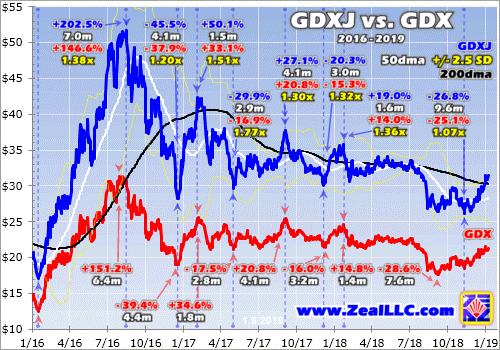

In just 6.4 months in largely the first half of 2016, gold stocks as measured by GDX skyrocketed 151.2% higher on a 29.9% gold upleg. GDXJ well-outperformed GDX in roughly that same span, blasting 202.5% higher in 7.0 months! GDX actually rallied 146.6% within GDXJ’s exact upleg, showing the mid-tier gold-stock ETF leveraged the major gold-stock ETF’s massive upleg by a solid 1.38x. GDXJ’s upside bested GDX’s.
Gold’s powerful initial upleg was followed by a massive correction in the second half of 2016, where it plunged 17.3% after Trump’s surprise election victory unleashed a huge stock-market surge on hopes for big tax cuts soon. The gold-stock carnage as gold plunged was great, with GDXJ plummeting 45.5% in just 4.1 months. Interestingly that leveraged GDX’s downside by 1.20x, much less than in the preceding upleg.
Ever since, the gold stocks have been mostly stuck in a big consolidation trading range. Enthusiasm for this sector waned to nothing as general stocks kept powering higher in recent years which relegated gold to drift sideways as well. While this extraordinary gold-stock-bull disruption was highly unusual, it was the result of record U.S. corporate tax cuts levitating the stock markets. That one-off event finally passed in 2018.
If you go through all this gold-stock bull’s uplegs, GDXJ’s gains outpaced GDX’s by an average of 1.39x! Ranging from 1.30x on the low side to 1.51x on the high side, there was not a single gold-stock upleg in recent years where GDXJ didn’t majorly outperform GDX. Taking GDX’s usual 2x to 3x leverage to gold and adding another 39% of marginal GDXJ gains on top of that is impressive. What trader wouldn’t want that?
GDXJ’s much-superior upside in this young bull is also accompanied by outsized downside relative to GDX during gold-stock corrections. That’s logical, as bigger mid-tier gold-stock gains in preceding uplegs leave more room to sell off in subsequent corrections. Interestingly though, GDXJ’s downside leverage averaging 1.34x is a bit lower than its upside leverage in uplegs. That is skewed to the high side as well.
It ranged from a low of 1.07x in the latest gold-stock selloff last summer and autumn to a staggering 1.77x in spring 2017. That outlier was the result of GDXJ’s gold miners surging far faster than GDX’s in early 2017. Without that anomaly, GDXJ’s downside leverage to GDX during corrections averages only 1.20x. That is merely about half its upside leverage, so GDXJ’s added risks are disproportionally smaller than its better upside.
Given all this, there is really no reason to bother with GDX at all if you are deploying capital in major gold-stock ETFs. GDXJ has better mid-tier gold miners growing their production while trading at lower market caps than the struggling majors. GDXJ has demonstrated much-better upside during gold-stock uplegs throughout this young bull, yet its downside during corrections isn’t proportional. GDXJ is far superior.
That being said, investors and speculators are much better off avoiding these major gold ETFs entirely! While GDXJ is nowhere near as bad as GDX, both are still burdened by major gold miners with declining production and rising costs. It doesn’t make any sense to own such laggards when they can be avoided entirely in favor of mid-tiers and true juniors with great fundamentals like growing production and stable costs.
The best strategy for riding this reaccelerating gold bull to wealth-multiplying gains in gold stocks is to carefully handpick the best mid-tier gold miners mostly included in GDXJ. Every quarter I break out this ETF’s top 34 and look at their production, costs, operating cash flows, earnings, and sales trends among others. That exercise helps separate the gold miners with better fundamentals from the lagging weaker ones.
So instead of just settling and owning GDXJ, even-better gains are highly probable by sticking to mid-tiers and juniors with superior fundamentals. They rank lower in GDXJ’s weightings and are usually growing their production organically or through new mine builds that recently came online or will soon be live. With plenty of great gold miners in this sector, there’s simply no need to hold the laggards retarding even GDXJ.
With gold stocks now enjoying a major upside breakout, massive new investment buying is coming. And the best gains by far will be won in smaller mid-tier and junior gold miners with superior fundamentals. While GDXJ itself will power dramatically higher despite some deadweight in its holdings, the better gold miners will generate much-greater wealth creation. Finding and owning these better gold-mining stocks is essential.
That’s one of my important missions at Zeal, relentlessly studying the gold-stock world to uncover the stocks with the greatest upside potential. The trading books in both our weekly and monthly newsletters are currently full of these better gold and silver miners. Most of these trades are relatively new, added in recent months as gold stocks recovered from deep lows. So it’s not too late to get deployed ahead of big gains!
To multiply your wealth in stocks you have to do some homework and stay abreast, which our popular newsletters really help. They explain what’s going on in the markets, why, and how to trade them with specific stocks. Walking the contrarian walk is very profitable. As of Q3, we’ve recommended and realized 1045 newsletter stock trades since 2001. Their average annualized realized gain including all losers is +17.7%! That’s double the long-term stock-market average. Subscribe today for just $12 per issue!
The bottom line is GDXJ’s upside easily bests GDX’s. While GDXJ is now really a mid-tier gold miners ETF instead of the junior one advertised, it holds some of the world’s best gold miners. Unlike struggling majors which dominate GDX, plenty of mid-tiers are still growing their production. They enjoy superior fundamentals and are weighted much more heavily in GDXJ than GDX, giving it much-better potential gains.
Throughout this entire young gold bull of recent years, GDXJ has well-outperformed GDX during gold-stock uplegs. While that has also led to bigger downside during corrections, it is disproportionally small compared to the upleg gains. GDXJ simply offers superior gold-stock sector exposure than GDX. But both these major gold-stock ETFs are still burdened with laggards dragging down their overall performances.
Adam Hamilton, CPA
January 14, 2019
Copyright 2000 – 2019 Zeal LLC (www.ZealLLC.com)
Guest Post by Bill Powers
January 11, 2019
Adrian Day of Adrian Day Asset Management is a seasoned investor, speaker, author, and adviser. In this interview, Adrian shares key takeaways from 2018 that affect the resource sector and offers his commentary on the Barrick-Randgold merger and its significance. Adrian also provides general insights on mergers and acquisitions within the mining sector, what he looks for in a junior royalty company, and his outlook on copper and copper mining stocks. Dispersed throughout the interview, Adrian discusses five mining stocks that he likes and which he thinks present an exceptional investment opportunity right now.
Bill: Welcome back and thanks for tuning in. You’re listening to the Mining Stock Education podcast and I’m Bill Powers, your host. For this episode, I’m joined by Adrian Day of Adrian Day Asset Management. Adrian is a well-known investor, speaker, author, and adviser when it comes to resource investing, and as I’ve said previous times on this podcast, Adrian wrote the first book that I ever read on resource investing and helped to pique my interest in this niche sector. Well, my last interview with Adrian was about two years ago at PDAC 2017, but Adrian joins me again today, so Adrian, thanks for taking the time to come on the podcast and share your insights.
Adrian: Well, thank you very much, and thank you for the nice comments, as well.
Bill: Let’s talk about the resource sector, first last year, as you peer back over 2018, can you recap for us some of the highlights, and important events that you see, and their significance?
Adrian: As I’m sure most of the listeners know, most resources were down during the year. Resources are a tricky thing because all of the indices are different, and most of the indices are actually commodity indices, which will therefore include a lot of soft commodities like grains and cattle and so on, which most of the people who follow resources are not really interested in, but nonetheless, most of them were down last year, the entire group was down 13%, and that’s even though some of the soft commodities were up, but clearly the most important things were the continued strength in the dollar for most of the year, other things being equal as we know, and things are never equal, but other things being equal, any time you price something in dollars, if the dollar is strong, the dollar price of that commodity is weaker, obviously.
The second major factor was the growing, ongoing tariff war between the U.S. and China in particular, and concerns that that might lead to a swelling global economy, so it’s the tariff war itself, but it’s also concerns of what it might lead to. And then of course, the third thing was the ongoing, the step up in I hate to call it tightening, but interest rate increases by the federal reserve. As you know, they announced that they had stopped QE and we’re going to start tightening back in 2015, and we saw one small rate hike at the end of this 2015 in December, and then a whole year later, we saw another one, so those are very slow in coming, but last year, we had four raises, and so it appeared perhaps that the fed was going to continue pushing rates up, so all those three, and that of course, also not only is that raising the cost of capital for a capital-intensive industry, so that’s a negative in and of itself, but secondly, the concern of raising rates too much might lead to a slowing economy again.
So those three factors, I think, were the main things that just pushed commodities down, and they’re all macro. I’m not talking anything micro, because I think last year the macro, other than perhaps for oil, I think the macro was far more important than the micro last year.
Bill: Within the major miners last year, we saw Barrick and Randgold merge. What’s your commentary on their merger and its significance?
Adrian: Well, it’s interesting because there was, as you know, no premium offered. Barrick obviously approached Randgold. I think it means more to Barrick than it did to Randgold, but there was no premium offered, which was very unusual, and Barrick has suggested, and Bristow from Randgold has echoed that, that we’re likely to see more mergers, more no-premium mergers as the industry consolidates. This is a very, very, for the size of the industry, it is an extremely fragmented industry, both among seniors and even more so among juniors. Very, very fragmented. That is inefficient because if you have 20 companies of a $2 billion size, you’ve got 20 managements to support. It’ll be interesting to see what happens with the Randgold-Barrick, I know that’s not what you were asking me about, but the most important thing to watch there, I think, is the difference in styles between Mark Bristow and Randgold and John Thornton and the masters of the universe at Barrick.
It’ll be interesting to see if they can consolidate or if there’s going to be a culture clash, but that’s a different question. I think we’re going to see consolidation. We have to. We’re going to see it among juniors as well. The difficulty always is if you don’t have strong asset synergies, then your synergies have to come, your benefits have to come from cost savings, which means reducing overlapping managements, essentially, and most people who run companies don’t want to voluntarily give up their jobs, and that is, I think, the biggest problem we have in not rationalizing the industry, particularly at the junior side.
Bill: Unless there’s a large premium and there’s some incentive for management, a windfall, would you say, at the junior level? It’s just that windfall that management would get that would cause them to acquiesce and give into such a merger?
Adrian: No, absolutely, and I think you’re more likely to see that kind of premium when a company, let’s say an exploration company, makes a discovery, and another company wants that discovery because it’s synergistic with something they have, and they’ll offer a premium. I was thinking more, and I don’t particularly want to mention names, because I don’t want anyone to get the wrong impression, but you look at a lot of, let’s say exploration companies, that might be doing good work, but just haven’t made a discovery, and you might have a company, an $8 million market cap, a $12 million market cap, a $10 million market cap, each of those companies has their own managements plus their own regulatory requirements and everything else, and typically if the company is a $10 million market cap, I would say typically 75% of the money they raise goes into overhead, not into the ground.
So if you combine three or four or five companies of $10 million, $15 million each, first of all, you get something that’s a little bit more liquid and therefore more open to more investors or more investors are open to it, $200 million market cap, let’s say. Still small but not micro, and maybe you can reduce, if you have a $200 million market cap, you can reduce $150 million overhead. You can reduce that to $100 million or $75 million, which means more of the money you raise can actually go into the ground, and so it’s not that any of these companies, in many cases, it’s not that any of these companies are doing bad work or are crooks, that’s a totally different issue. I’m talking about good companies with good managements doing good work, but if you’re only $10 or $20 million market cap, inevitably you have to keep raising money, and inevitably a lot of that money, a majority of that money has to go to just staying alive, regulatory fees, compliance fees, filing fees, et cetera, et cetera.
That’s if they’re not overpaying themselves or anything. Again, we’re not even getting to the companies where they overpay. We’re just talking about good companies doing good work, but if they don’t make a discovery, nobody is going to offer them a premium. Why would you offer a premium to someone that doesn’t have a discovery and doesn’t offer you particular synergies? There’s a lack of incentive for these companies to merge because nobody who went out, some of them were 15 years with Placer Dome and again, I’m not talking about anyone in particular, this is a hybrid individual, and he got tired of a big company and he went out and started his own company and raised some money. He doesn’t want to give up his company, and that’s a problem.
Bill: Still talking about mergers and acquisitions except from the investor’s perspective and where they can find the best value in 2019, I’ve spoken to Rick Rule a couple times over the past year and he points out that he thinks one of the most consistent and best opportunities for resource investors is trying to locate those takeover targets before they’re taken out. Would you agree with that and is that one of the places where you’re looking for your investment dollars in 2019?
Adrian: Well, far be it from me to disagree with Rick Rule. I think how I see it is I look at potential takeovers as icing on the cake, so I rarely, not never, I rarely buy a company simply because I think it’s going to get taken over because all too often, one can be disappointed, or it can frankly just take too long before that comes to pass, but if I like a company, I like the management, I like the property, I like what they’ve got anyway, then a takeover can be icing on the cake, and we do have several companies we own, but I expect that I’m fully expecting to get taken over at some point, and frankly, over the last couple of years, we’ve had four, five that have been taken over. Yeah. We’ve got several, and I don’t know if you want names?
Bill: Yeah. Please provide names. What’s of interest to you? You make some of your positions public through your writings or through interviews like this. Can you comment on any of your positions that you’ve made public and some of them that you think are the best value right now?
Adrian: Yeah. I’ll mention on the junior side, I’ll mention a couple, and this one gets back to takeover. Almaden has a great project called Ixtaca in Mexico. It’s a gold-copper project. They’ve just completed a final feasibility. They’ve applied for permits. Almaden is a junior company, very small company. Good people. One would not typically expect them to put this project into production. It’s a very low capex project, a very simple project to run metallurgically, so Almaden is suggesting that in fact they might put it into production themselves if they don’t get an attractive enough offer because it is a simple project and so on.
We own it because we like the project, we like the economics. The thing is selling at about a fifth of the value of … Don’t quote me. It’s even less than a fifth of the value of the feasibility study. At the same time, it’s the kind of project that I wouldn’t be surprised if someone was interested in taking over. 50% silver is very attractive to a lot of silver companies, where primary silver mines are increasingly rare, so this is an attractive project from that point of view, and it’s in Mexico, which despite everything about the new administration, Mexico still remains one of the best mining jurisdictions in the world, so I’m just looking this up. It’s got an after-tax value of $310 million. It’s got a market cap of $80 million.
I think there’s a lot of room there for someone to come in and take the company over, so again, we don’t own it just because we think it’s going to get taken over, but we think there’s a strong possibility that it might get taken over.
Bill: So you like royalty companies. That’s well known. You often in many interviews talk about some of the larger billion dollar plus royalty companies, but of recent years there’s been more of the smaller junior royalty companies come up. Can you talk about what you look for in a junior royalty company, and what are your general comments on, let’s say, the sub-$500 million market cap and below royalty space right now?
Adrian: Yeah. Good question. The first thing I look for is the same thing I look for in any junior company, which is management. You’ve got to have a strong management, and strong management means obviously a lot of things. A management that can execute. A management that has a good business plan and has vision, can execute, can talk to the market, and so on. That’s number one, and number two is balance sheets. You want a company that is able to raise money because it has connections, does not overspend. That’s important. And so when you’re looking at the thing with royalties is there’s a huge difference in valuation between a small royalty and a large royalty.
So if you look at my favorite junior, which would be Metalla. Metalla is a $70 million market cap. Let me just see what the … We don’t even have a P/E ratio. I’m just looking at a metric so we can compare. Price to cash flow of 26, and if we looked at Franco-Nevada, we get a price to cash flow of about the same, but on other metrics, the bigger ones are a lot smaller, on enterprise value, and so on. And so you buy a junior rather than a senior because you think they have the ability to grow and the ability for that valuation to expand, so you want to look at a company that has been able to execute. Metalla, for example, has been around about a little over two years now, two and a half years, and they’ve managed to get four producing royalties, a pipeline of about 14 or 15 in various stages from exploration to developmental, and near-term production, and in fact, they’ve actually introduced a dividend now. The dividend yield is about 2.3% right now. It’s an attractive dividend yield in and of its own right. It’s unusual for a growing junior to pay a dividend.
Bill: Is that the smallest market cap company in the junior space that pays a dividend? You may not know it offhand, but that strikes me as well.
Adrian: It’s definitely one of. I know there’s been one or two that I think had to stop the dividend because it just didn’t make sense. In the case of Metalla, they’re paying a percentage of their revenue as a dividend, so there’s absolutely no reason why they shouldn’t be able to sustain paying a dividend, and I think the idea, again, it’s unusual, but the idea was to show that the revenues that they had achieved were actually sustainable. So you want a royalty that’s growing and that can add various projects and get a diversity of royalty income coming in. Again as I mentioned, Metalla has four producing royalties. Franco has something like 43, so it’s a somewhat different scale, but the idea is that they will build up that revenue stream, and the diversity of the revenue stream, and potentially this would be a takeover candidate at some point for a senior royalty company that has difficulty adding to its royalty base, but that’s maybe two or three years away from now. That’s not an immediate prospect. We own Metalla right now because it’s a solid company, good balance sheet, great management, and it’s growing.
Bill: Would you say that the competition amongst those sub-$500 million dollar market cap junior royalty companies is stiffening, that it’s more competitive for these deals?
Adrian: It’s getting more competitive. For the larger royalties, it’s extremely competitive, as you know. They all look at the same things, Franco, Royal, Wheaton, and Osisko to a large degree, to some degree, but if a royalty is available, they’re all looking at it, and no company is going to do a private deal on a half billion dollar royalty. It always go out to auction or they’ll talk to others, and frankly who gets it depends really on who happens to have the cash at the time and for whom it most logically fits. If someone has just done two big copper deals, a gold byproduct from big Chilean copper mines, they may not be willing to pay up for another billion dollar Chilean copper mine byproduct credit royalty, if you understand what I mean, but sometimes the returns on these deals at current prices are extremely low.
There was one deal recently, a large deal, over half a billion, with a stated return of 1.1%, and it wasn’t necessarily a bad deal. It was a 60 or 70 year mine life, and it was a mine with a lot of upside potential, but nonetheless, that just gives you an indication of how competitive that sector is. When Metalla started, they were really able to … I think it’s true to say that for smaller deals, it’s sometimes able to do a transaction between a royalty company and a company without that project going out to auction to other companies. It has been possible, and so you see a particular company that you think you can do a transaction with, it’s been possible to do it, but I think increasingly, companies are wanting to shove their deals to everybody, and there are more juniors out there, so that sector is going to get a little bit more competitive.
But you know, there aren’t that many companies at the sub-$100 million. People often think of Sandstorm as a small one, but Sandstorm is $850 million market cap, so it’s small compared with Franco, but that’s 10 times larger than Metalla, so at the moment, and I don’t mean to keep harping on Metalla, but at the moment, a company of that size can be a lot more nimble than most of the market, and frankly, they can look at deals that other companies aren’t interested it.
Bill: I was talking to a mining engineer recently, and he said that even though investors looking at these deals may see a 15% IRR, internal rate or return, there’s not a lot of 15% internal rate of return projects out there. Would you agree with that?
Adrian: For royalties or for projects generally?
Bill: For royalties in particular.
Adrian: Definitely for royalties. No question. If you have a 15% IRR on a royalty that is acquired, or created, there’s probably something wrong with it, which it might be in the Sudan or whatever. Any double digit rate of return on a royalty is pretty tough.
Bill: Adrian, before you go, I’d like to get your comments on copper. That’s a metal that you like. Two years ago when I first interviewed you, in fact, you told me that copper was your number one after the precious metals. What’s your perspective on copper right now? We saw copper fall from about $3.30 a pound at the peak, halfway through last year, and now it’s close to 52 week lows, trading around $2.67 per pound. We have the trade talk and the trade truce supposedly between the US and China right now. Can copper in your opinion fall even lower in 2019? We know that there’s the supply deficit ahead of us here, but what about copper in 2019, and in particular, what about the copper equities? Could the copper equities even go lower?
Adrian: Well, things can always go lower. That’s one of the things you certainly learn in the resource business, resource investing, that however cheap they are, however cheap they appear, undervalued they appear, they can always go lower. Copper was interesting last year because as you mentioned, copper actually had a quite strong first half of the year, so it really struck me that copper was really beginning to turn around until the tariff trade dispute really heated up, and that’s what knocked it back. Copper remains after gold, it remains my favorite metal and my favorite base metal, and it does face that near-term production deficit, even without a pickup in demand. Now of course, you don’t want demand to collapse because of a global recession or a Chinese recession, but you don’t need a great pickup in demand for copper to move into a deficit.
You look at big copper mines are very rare. One has to really emphasize this. A big copper mine is very, very rare, and Richard Adkerson, the CEO of Freeport, on the latest conference call, mentioned something really fascinating. Despite the fact that we had that super cycle from 2001 for 10 years, when China was developing and all the base metals including copper were going crazy, not a single new copper mine has joined the list of top 10 producers or top 10 in reserves. Not a single one, despite the fact that we had that super cycle and despite the fact that people were spending money looking. Not only are they rare, but they take time to develop. Freeport has recently announced that apart from a couple of mines already in development, they are not giving the go-ahead to any new mines until the copper price looks more certain.
He said it would take a minimum of five to seven years for another mine to commence production from the time they give the go-ahead, and the way he put it was even a shovel-ready mine, five years minimum from the time the go-ahead is given. He indicated, and I think it’s true, that that stands, so no new mines is true for most of the global, major copper miners in the world. And so you can look ahead with a fair degree of certainty, a high degree of certainty, in fact, on what the potential production next year, the year after, three, four, five years from now, you can look ahead five years with a high degree of certainty what the potential production is going to be, because there’s going to be nothing producing copper in 2023. Nothing that we don’t already know about, right?
On the other hand, there’s a bigger chance of downside surprises. Some of the big copper mines start depleting quicker than we thought, there’s an earthquake in Chile that causes disruptions-
Bill: The union strikes.
Adrian: Union strikes, et cetera. The surprises with copper production are likely to be on the downside, not on the upside, so absent a collapse in demand, we are going to see shortages in three or four years’ time, and that’s got to mean higher prices. We are accumulating copper companies. I think you do need a company with low-cost mines so they can withstand short-term weakness, continue to withstand any continued weakness, and a lot of these mining companies do have their own peculiar problems, but we like Freeport a lot. That’s the largest outside the Chilean government-owned Codelco, it’s the largest private, publicly traded copper company in the world.
Freeport I think is very, very cheap, and they’ve cleaned up the balance sheet tremendously. They’ve done a superb job at cleaning up the balance sheet. Lundin which again has a great balance sheet. I wouldn’t call Freeport’s great, by the way. I’d just say they’ve done a good job cleaning it up. Lundin on the other hand, Lundin Mining does have a great balance sheet. They’ve got a lot of cash. They’re in a position to buy something if something good comes along. As you know, they tried to buy the Timok and they tried to buy Nevsun, but that didn’t work. They got trumped. Frankly, an unusual idea, I like Zijin, which is the Chinese company that purchased Nevsun, the largest gold-mining company in China, but a large, diversified mining company. Gold is their largest asset but copper is about half of what they have in gold and they want to increase their copper, and they also have some zinc mines they’ve bought.
They recently did a secondary offering just last week in order to finance the Nevsun purchase. Stock fell sharply from nearly 3.20 down to 2.76. I think it’s a good buy at today’s price, and it pays a dividend at 3% or something, 4% now. 4%, sorry, at today’s price.
Bill: Adrian, if I could do one follow-up question on copper, you’re a long-term investor, so you’re not in it for short-term trading, but for the short-term trading speculators listening to us, with the trade negotiations between the U.S. and China occurring right now, do you think specifically the copper equities and the junior equities, what’s being priced into those equities now? In other words, is there a lot of downside? If the trade talks fall apart between the U.S. and China, how much downside is still left in some of these depressed equities?
Adrian: Good question. I don’t think there’s a lot of downside left anymore. You look at the major ones and they are selling very close to their lows. You look at the juniors, which were slammed on tax loss selling as well as the macro scenario we’ve discussed. I don’t think there’s a lot of downside left. Obviously, if there was an abrupt end to trade talks with some nasty tweets on either side, the stocks would fall, no question, but I don’t think there’s a major sustained downside at this point.
Bill: Well, Adrian, before you go, is there any contact information or ways people could follow you?
Adrian: Oh, thank you. I appreciate that. Yeah. The best thing is to look at the website first, which is www.adriandayassetmanagement.com, all one word.
Bill: Adrian, thank you for the conversation. I appreciate you joining me on the podcast. Have a great day.
Adrian: Thank you. I appreciate it.
About the Author: Bill Powers is the host of the Mining Stock Education podcast which interviews many of the top names in the natural resource sector and profiles quality mining investment opportunities. Bill is an avid resource investor with an entrepreneurial background in sales, management, and small business development. His latest interviews can be found at MiningStockEducation.com.
January 8, 2019
- It’s time for the queen of assets to rest and consolidate. Nothing goes up in a straight line, and that’s certainly true for gold!
- Please click here now. Double-click to enlarge this daily gold chart.
- A pullback to about $1250 would be a healthy 50% retracement of the $100 rally from $1200 to $1300.
- Gold begins 2019 with some very positive news in play. Please click here now. After a two-year hiatus, China’s central bank is back in gold market action!
- The bank had been consistently buying about 15-20 tons of gold a month. When those purchases are added to buying from Russia and other central banks, they are quite price-supportive.
- It’s great to see China back on the buy, and analysts in India are projecting a ramp-up in gold imports there of about 20% for the first six months of 2019.
- The ECB (Europe’s central bank) is projecting higher inflation and easing growth for 2019.
- The love trade is healthy, the central bank trade is healthy, and global stock markets are on the rocks.
- On that note, please click here now. Double-click to enlarge. I’m a bit worried that the US stock market rally could peter out quickly.
- Please click here now. Institutional money managers are cutting back their allocations to US equities, and rightly so.
- The business cycle is entering the eighth and ninth innings, wage inflation is poised to spike in full-time jobs, and earnings have clearly plateaued.
- Please click here now. China’s central bank and government have vastly more “wiggle room” than America’s do to stimulate the economy.
- China’s stimulus is inflationary, and that’s good news for gold.
- The U.S. government is shut down. That’s not a position of strength, to put it mildly. These shutdowns have happened so many times that citizens are now numb and don’t seem to care.
- It’s not a good thing; the government just can’t seem to break its addiction to borrowing more and more money.
- The U.S. government has been very vocal in its opposition to the modest interest rate rates from the Fed. I don’t see any economic stress from these hikes, and senior citizens have been paid nothing in their savings accounts for years.
- Rate hikes are an indicator that inflation is in the air. They haven’t hurt gold, they help senior citizens, and they put pressure on banks to make business loans rather than finance stock market buybacks to enrich corporate directors.
- Rate hikes do put pressure on the ability of the U.S. government to borrow ever-more money, and that pressure is good.
- Please click here now. Double-click to enlarge this daily silver chart.
- The uptrend is solid. A pullback is normal, expected, and healthy. Note the Fibonacci lines in play around the demand line of the uptrend channel.
- Silver feels almost as solid as gold does right now, and that’s likely due to the growing threat of stagflation throughout much of the world.
- Please click here now. Double-click to enlarge this nice GDX daily chart.
- Like most sectors of the precious metals asset class, GDX is taking a breather after it successfully penetrated key resistance in the $20.70 area.
- From a technical perspective, the range trade in the $20-$21.50 area has a 67% chance of being resolved with a rally to $23. The current consolidation could be the last opportunity for excited investors to buy in this price zone before GDX moves above $23 and stays there for quite a long period of time!
Special Offer For Website Readers: Please send me an Email to freereports4@gracelandupdates.com and I’ll send you my free “Silver Stocks Rock!” report. I highlight the SIL and SILJ ETF component stocks that are poised to enter January like silver bullets shot out of a golden gun! I include key tactics to keep investors on the winning side of the action… in both the short and long term!
Thanks!
Stewart Thomson
Graceland Updates
Email:
Stewart Thomson is a retired Merrill Lynch broker. Stewart writes the Graceland Updates daily between 4am-7am. They are sent out around 8am-9am. The newsletter is attractively priced and the format is a unique numbered point form. Giving clarity of each point and saving valuable reading time.
Risks, Disclaimers, Legal
Stewart Thomson is no longer an investment advisor. The information provided by Stewart and Graceland Updates is for general information purposes only. Before taking any action on any investment, it is imperative that you consult with multiple properly licensed, experienced and qualified investment advisors and get numerous opinions before taking any action. Your minimum risk on any investment in the world is: 100% loss of all your money. You may be taking or preparing to take leveraged positions in investments and not know it, exposing yourself to unlimited risks. This is highly concerning if you are an investor in any derivatives products. There is an approx $700 trillion OTC Derivatives Iceberg with a tiny portion written off officially. The bottom line:
Are You Prepared?
The precious metals complex has enjoyed a nice run in recent months.
GDX has gained 25% since the September lows while GDXJ has gained 22% since its November low. Gold has rallied over $100/oz since its October low and Silver has surged in recent weeks.
The Gold community is getting excited again. They think the equity market is doomed and Gold has started a real bull run. That may be true but in the interim there are questions on the sustainability of recent strength.
Below we plot GDX with its advance decline (A/D) line and its RSI indicator. We already know that the A/D line has been carrying a few negative divergences.
With respect to RSI, typically in a strong, trending move it will surpass 70 (sooner rather than later) and that indicates strong momentum which implies some sustainability.
As GDX tests its 400-day moving average, it is lacking strong breadth and strong momentum.
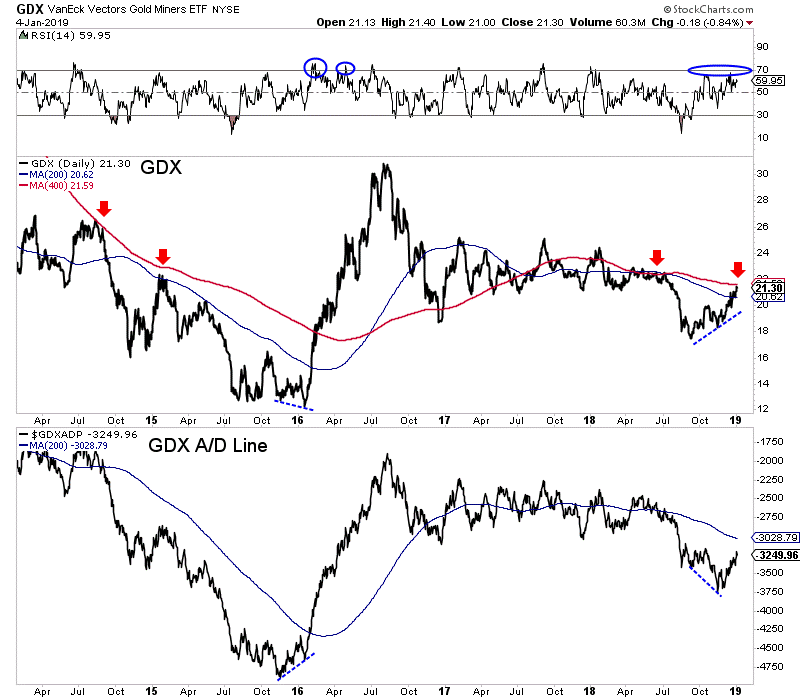

Meanwhile, Gold finally reached an RSI of +70 but after it occurred Gold formed a bearish reversal at strong resistance at $1300. That is why we want momentum to reach overbought conditions sooner rather than later.
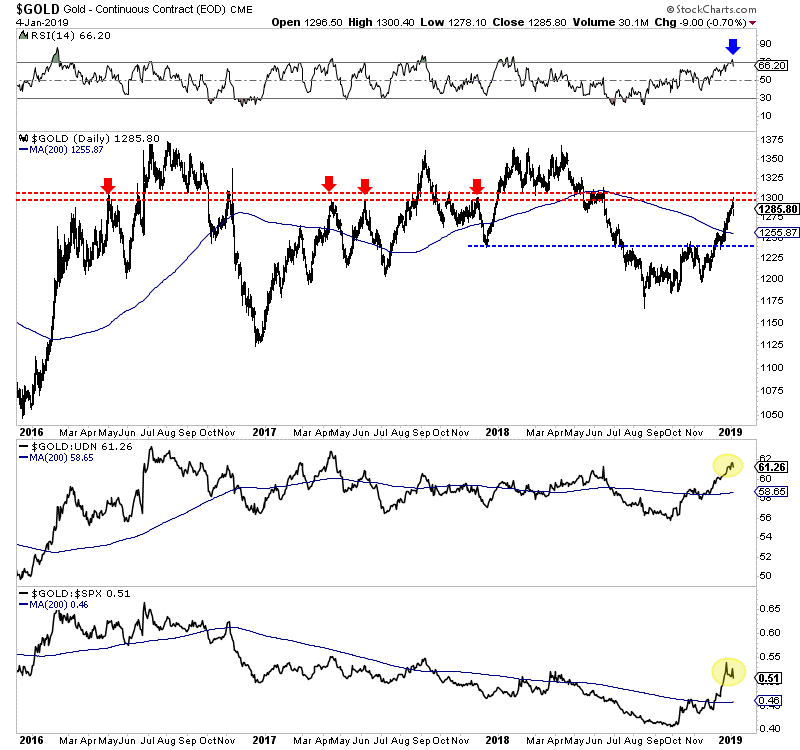

Silver (not shown) formed a similar bearish reversal as it approached resistance at $16.00.
Precious metals have tested resistance but with a lack of strong momentum and strong breadth. This implies that recent strength is probably not immediately sustainable.
Can precious metals digest and maintain recent gains or will they give most of them back as has been the case for years and years?
Assuming precious metals correct and consolidate, then there are multiple things we want to watch including breadth and relative strength against stocks and foreign currencies. In addition, we also should watch how the miners perform relative to Gold.
If Gold pushes past $1300 and the gold stocks surge past their 400-day moving averages it would signal a change in character for the market. At that juncture it would difficult to argue against a bull market.
In any case, it is not wise to chase strength until we get more evidence that a bull market has started. There will be plenty of time to get into cheap juniors that can triple and quadruple once things really get going. Note that many juniors began huge moves months after lows in January 2016, October 2008, May 2005 and November 2000. To prepare yourself for some epic buying opportunities in junior gold and silver stocks in 2019, consider learning more about our premium service.
The gold stocks’ young upleg is really growing, on a trajectory to become major. This contrarian sector is breaking out to the upside on multiple fronts technically, which is really improving sentiment. Traders’ extreme bearishness of late summer has mostly abated, with bullish shoots taking root. Fundamentals certainly justify the mounting gold-stock buying, with earnings set to surge on higher gold prices in coming quarters.
This baby new year should prove far happier for gold stocks than 2018. This sector’s performance is measured by the share price of the flagship gold-stock investment vehicle, which is the GDX VanEck Vectors Gold Miners ETF. This week it held shares worth $10.5b in 46 major and mid-tier gold and silver miners from around the world. GDX is now 60.1x larger than the next-biggest 1x-long major-gold-miners ETF!
2018 was rough for the gold miners, with GDX slumping 9.3%. Weaker gold prices were to blame, as gold is the dominant driver of gold-mining earnings. While the yellow metal recovered to a mere 1.6% loss last year, it slumped much lower in late summer. By mid-August extreme record gold-futures short selling had pummeled it down 9.9% year-to-date. That eviscerated gold-stock psychology, scaring traders out.
The major gold miners’ stocks suffered a brutal forced capitulation in that gold low’s wake as stop losses were triggered leading to cascading selling. So by mid-September, GDX had cratered 24.4% YTD. This bloodbath really turned traders off from this small contrarian sector. But as I warned just days later back in mid-September near the lows, that extreme selling heralded the birth of a major new gold-stock upleg.
GDX has indeed powered higher on balance ever since, rallying 20.0% in 3.4 months by Christmas Eve. That was fueled by the roughly-parallel young gold upleg that climbed 9.3% by the middle of this week. Things are really looking up for the gold stocks. Investors and speculators alike are starting to remember the big upside this small sector enjoys in major uplegs. Key breakouts are confirming one is underway.
Several weeks ago I wrote an essay analyzing the imminent upside triple breakout in GDX. Closing at $20.12 that day, GDX was on the verge of surging back over $21. That is an exceedingly-important level for the major gold miners technically. This updated chart shows why, and reveals the gold stocks are now enjoying their longest and best-foundationed upleg in years. And it is going to grow a lot larger as gold rallies.
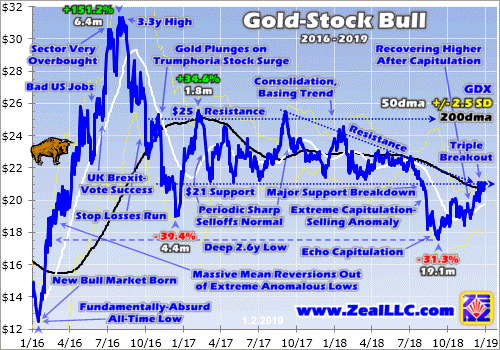

Three major upper resistance zones have converged at GDX $21. This was strong lower support for the gold miners’ stocks in a major consolidation basing trend that lasted for 21.5 months. It only failed in early August when gold was pounded by that extreme record futures short selling. Once they break, old support levels often become new resistance zones. Traders are wary to buy aggressively before they are overcome.
GDX $21 is also where the downward-sloping upper resistance line from gold stocks’ descending-triangle technical pattern has ended up. That connected the lower GDX highs that have vexed this sector since September 2017. The final and most-important resistance zone near GDX $21 is its key 200-day moving average. This essential line is usually the most-widely-watched by all the technically-oriented traders.
Market history has long shown 200dmas often prove the key dividing line between bull and bear markets. When prices surge back above their 200dmas after long periods underneath them, traders usually flood back in driving exploding upside momentum. 200dma upside breakouts often herald new bull markets or powerful uplegs within existing bulls. So GDX powering back over its 200dma is a major gold-stock buy signal.
While GDX has been meandering around $21 since Christmas Eve, that 200dma breakout has already happened! Since this leading gold-stock ETF’s 200dma is falling, the last time it was actually at $21 was in mid-November. This week the black 200dma line above has slumped to $20.72. A decisive breakout is 1% over that level. GDX achieved this milestone on December 18th, and has mostly maintained it since.
But with that 200dma still rounding to GDX $21, that is still the triple-resistance zone traders need to see left decisively behind. That critical upside breakout is happening before our very eyes! With GDX closing near $21.50, investors and speculators alike are going to consider the gold stocks off to the races. They will rush to buy and chase the upward momentum, accelerating it. This fuels major gold-stock uplegs.
The more capital traders deploy in gold stocks, the faster their share prices rise. The bigger their gains, the more traders want to buy. This virtuous circle of capital inflows has propelled past gold-stock uplegs to monstrous proportions. The last example of gold stocks powering higher out of major secular lows happened in largely the first half of 2016. The setup for that huge gold-stock upleg was very similar to today’s.
After being pummeled to a major secular low in mid-January 2016, selling was exhausted and buyers started to return. GDX began powering higher, spurred on by a parallel young gold upleg. GDX blasted up through its 200dma and capital flooded in. By the time that major buying ran its course, GDX soared an amazing 151.2% higher in just 6.4 months! Those kinds of returns are what give gold stocks their allure.
The necessary psychology to maintain that gold-stock momentum resulted from a relatively-minor 29.9% gold upleg in roughly the same span. The major gold miners of GDX leveraged and amplified gold’s gains by 5.1x! That was far better than the usual 2x to 3x because the gold stocks were so beaten down, trading at fundamentally-absurd levels when that upleg was born. Yet those huge gains still weren’t too exceptional.
Despite GDX’s mounting popularity as the leading gold-stock benchmark, this ETF is relatively new with a May 2006 birth. The previous secular gold-stock bull ran for 10.8 years, extending from November 2000 to September 2011. During that long span the classic HUI NYSE Arca Gold BUGS Index skyrocketed an astounding 1664.4% higher! The world’s most-hated sector today multiplied investors’ wealth by nearly 18x.
That was driven by a parallel 638.2% secular gold bull, which the major gold stocks of the HUI leveraged by 2.6x. The individual upleg cycles within that mammoth gold-stock bull show uplegs in this sector tend to be very large. Excluding the epic mean-reversion rebound out of late 2008’s first-in-a-century stock-market panic, the HUI enjoyed 11 normal uplegs. Their average gain was a staggering 80.7% over 7.9 months!
That last secular gold-stock bull offered traders 11 separate opportunities over 11 years to almost double their capital! So while GDX’s monster 151% upleg in H1’16 was definitely on the huge side, the last bull’s 81% average uplegs weren’t tremendously behind. When investment capital returns to gold stocks in a material way, their upside is massive. Today’s young GDX upleg could easily grow to 80%+ later this year.
Even a full-on doubling is fairly conservative considering how low gold stocks were hammered in early September’s cascading forced capitulation. GDX bottomed at $17.57 on September 11th, which was a deep 2.6-year low. A 100% gain from there would merely carry it to $35.14. That would be a new high for this gold-stock bull, as GDX last peaked at $31.32 in early August 2016. But GDX $35 is still relatively low.
Back in September 2011 as that last secular gold-stock bull crested, GDX peaked at $66.63 on close. It averaged $52.61 in the three full calendar years of 2010, 2011, and 2012. Gold-stock levels have been much higher on balance in the past. So seeing GDX double from its recent lows in this young upleg isn’t a stretch at all. And major gold-stock uplegs aren’t just a technical-buying-fueling-bullish-sentiment thing.
They are also supported by fundamentals. Gold-mining costs are essentially fixed during mine-planning stages. That’s when geologists and engineers decide which gold ore to mine, how to dig to it, and how to process that ore to extract the gold. Once hundreds of millions of dollars are spent to build the mines and mills, the mining costs generally don’t fluctuate much. Real-world data abundantly confirms this truth.
Every quarter I wade through the latest financial and operational reports of the top 34 GDX gold miners. They finished reporting their latest Q3’18 results in mid-November, which I painstakingly analyzed in an essay as usual. The top 34 GDX gold miners accounted for nearly 94% of this ETF’s total weighting. And their average all-in sustaining costs for producing each ounce of gold ran $877. That was right in line.
The previous four quarters’ top 34 GDX gold miners’ average AISCs came in at $868, $858, $884, and $856 averaging $867. So the major gold miners’ costs for producing gold don’t change much regardless of what the gold price is doing. Thus higher gold prices feed directly through to bottom lines in amplified fashion. Gold stocks’ earnings surge during gold uplegs, fundamentally justifying monster gold-stock gains.
In Q3’18 plenty of major gold miners actually reported that they expected AISCs to retreat in Q4’18 as production recovered out of various temporary setbacks. So I expect to see lower average AISCs among the top 34 GDX gold miners in their upcoming Q4 results. But let’s conservatively assume that Q3’18’s $877 average AISCs hold into Q4. Higher prevailing gold prices in Q4 portend bigger gold-mining profits.
The average gold price climbed 1.4% quarter-on-quarter in Q4 near $1228. That implies the major gold miners of GDX were earning $351 per ounce at $877 average AISCs. In Q3 the lower average $1211 gold price drove profits of $334 per ounce. So gold-mining earnings are likely to climb by at least 5.1% QoQ in Q4’18 results. That is 3.6x upside leverage to gold, so outsized gold-stock gains are righteous.
No one knows what gold will average in Q1’19, but I bet it’s going to be much higher than Q4’s $1228. Gold thrives during stock-market selloffs as investors remember diversifying their stock-heavy portfolios with alternative investments. And with burning stock markets rolling over into a young bear driven by full-speed Fed quantitative tightening, gold investment demand is likely to push gold higher for a long time to come.
But let’s assume gold does nothing on balance in Q1, and merely averages $1280 when the dust settles. That is still 4.3% higher sequentially from Q4. At $1280 gold prices and $877 AISCs, gold-mining profits in Q1 would run $403 per ounce. That is another 14.8% higher than Q4’s projected level, implying 3.4x earnings leverage to gold. As long as gold gradually climbs on balance, the gold stocks deserve to soar.
Because their profits surge much faster than gold, so do gold-stock prices. Gold stocks again tend to outperform gold by 2x to 3x during major uplegs. So if gold rallies 30%, GDX will usually power up 60% to 90%. The major gold miners’ stocks remain wildly undervalued relative to prevailing gold prices. Back in mid-October when GDX was just clawing back out of the $18s, I made that fundamental case in depth.
But while GDX is a fine sector investment vehicle with a lot to like, it’s not without its problems. In Q3’18 for example, the top 34 GDX gold miners saw their overall gold production retreat 2.9% year-over-year. The world’s 4 largest gold miners Newmont, Barrick, AngloGold, and Kinross suffered annual production drops of 2.0%, 7.6%, 14.6%, and 10.4% in Q3. Goldcorp’s plunged an anomalously-extreme 20.5% YoY!
These 5 major gold miners alone accounted for over 30% of GDX’s total weighting. Other gold miners among its top components are also struggling with production. While GDX has to own the biggest and best gold miners no matter how they are faring, their underperformance really drags down GDX’s upside. The biggest and fastest gold-stock price gains accrue in smaller mid-tier gold miners growing their production.
So instead of buying GDX, far better gains are highly probable from handpicking fundamentally-superior GDX-component stocks to own. These include mid-tier gold miners lower in GDX’s rankings that are still growing their production organically, or through new mine builds that recently came online or will soon be live. With plenty of great gold miners in this sector, investors and speculators have no need to hold laggards.
With GDX now enjoying a major upside breakout, massive new investment buying is coming. And the best gains by far will be won in smaller mid-tier and junior gold miners with superior fundamentals. While GDX itself will power dramatically higher despite the deadweight in its holdings, the better gold miners will generate much-greater wealth creation. Finding and owning these better gold-mining stocks is essential.
That’s one of my important missions at Zeal, relentlessly studying the gold-stock world to uncover the stocks with the greatest upside potential. The trading books in both our weekly and monthly newsletters are currently full of these better gold and silver miners. Most of these trades are relatively new, added in recent months as gold stocks recovered from deep lows. So it’s not too late to get deployed ahead of big gains!
To multiply your wealth in stocks you have to do some homework and stay abreast, which our popular newsletters really help. They explain what’s going on in the markets, why, and how to trade them with specific stocks. Walking the contrarian walk is very profitable. As of Q3, we’ve recommended and realized 1045 newsletter stock trades since 2001. Their average annualized realized gain including all losers is +17.7%! That’s double the long-term stock-market average. Subscribe today for just $12 per issue!
The bottom line is this young gold-stock upleg is growing. It is now surging in a major upside breakout that should unleash a flood of new buying. With gold climbing on balance too, everything is in place to fuel a major gold-stock upleg. That could easily portend a doubling in the major gold miners’ stocks from their recent deep lows. This sector’s technicals, sentiment, and fundamentals all support massive gains from here.
The higher gold stocks are driven, the more traders want to buy them to chase their outperformance. The more gold stocks rally, the more bullish sentiment becomes leading to mounting capital inflows. Higher gold prices justify all that fundamentally, as gold-mining profits leverage and amplify gold’s gains. This is the best gold-stock setup seen since early 2016, which led to GDX soaring 151% in just over a half-year.
Adam Hamilton, CPA
January 7, 2019
Copyright 2000 – 2019 Zeal LLC (www.ZealLLC.com)
- As the new year begins, gold continues to gain respect as the ultimate investment asset. Unfortunately, the same cannot be said for the U.S. dollar.
- Most investors tend to view the dollar as a “safe haven”, but the big bank FOREX traders that really move the currency market view the dollar as a risk-on asset class.
- They view gold and the Japanese yen as the main risk-off assets. So, when the dollar falls against the yen and gold as the U.S. stock market rises, all may not be quite as well as investors think it is!
- Please click here now: http://www.graceland-updates.com/images/stories/19jan/2019jan1usd1.png Double-click to enlarge. After building an immense sloping H&S top pattern, the dollar has collapsed against the yen and is now almost in “free fall”.
- That top pattern is technically a “head and shoulders (top) bear consolidation pattern”, and its implications are ominous.
- At my guswinger.com swing trade service (where I personally take all the trades myself), I’m short the dollar versus the yen (and short the dollar versus the yuan) in the FOREX market. Traders are making solid profits on these anti-dollar trades.
- We’re also long NUGT and Barrick. With John Thornton and Mark Bristow at Barrick’s helm, I now have a $200 long-term price target for Barrick. The NYSE stock symbol is set to change from ABX to GOLD tomorrow, and that’s positive news.
- Please click here now: http://www.graceland-updates.com/images/stories/19jan/2018jan1gold1.png Double-click to enlarge. As 2019 begins, investors need to think hard about whether it’s more important to predict a late cycle rally for the US stock market… or a much better idea to focus on the spectacularly bullish price action taking place on the long-term gold chart.
- India’s government is launching a new pro-gold policy within a few weeks. That will see gold become endorsed as a respected investment asset class by the government. A significant chop in the import duty will likely follow, and discussions are already underway with Russian entities about duty-free imports.
- In America, the current collapse in the dollar comes late in the business cycle. The big bank FOREX departments are almost universally negative on the dollar, and rightly so.
- Please click here now: http://www.graceland-updates.com/images/stories/19jan/2019jan1dow1.png Double-click to enlarge. The dollar melt-down against the yen is happening as the US stock market trades lower on ramped-up quantitative tightening that Fed chair Powell now says is on “auto pilot”. Investors who ignore quantitative tightening in the late stage of the US business cycle are making as big a mistake as ignoring quantitative easing at the 2009 trough of the cycle.
- Also, a Dow Theory sell signal could take place in 2019 if both the Transports and the Industrials cannot make new daily closing highs… and then break the current lows.
- I’m long the Dow now via UDOW but that’s just a technical swing trade, albeit a winner already. In the big picture, investors need to think about only one thing in 2019 and that is…
- While the job market is officially very tight, a lot of that tightness can be explained by the large number of part-time jobs. The labour department counts one worker working two part-time jobs as two people working. That’s arguably fraudulent accounting. Regardless, the huge number of part-time jobs is the main cause of the slow growth in wage inflation.
- Having said that, as the full-time jobs market tightens significantly in 2019, much more wage inflation will appear… and it will do so as corporate earnings fade towards the single digits growth range.
- In a nutshell: Welcome America, to the rebirth of… Stagflation!
- I’ve predicted that investors are making a mistake if they sit around and wait for Trump to “make things great” while the U.S. government debt rises ever-higher in the late stage of the business cycle. It’s an understandable mistake that comes from frustration with the hideous socialist and war-mongering policies of past U.S. administrations. The murderous war-mongering has been financed with gargantuan debt, making it even more vile.
- Regardless, the much wiser plan of action is to use Trump’s incredible work ethic and business acumen as personal inspiration to take professional action in the gold and silver market.
- On that note, please click here now: http://www.graceland-updates.com/images/stories/19jan/2019jan1si1.png Double-click to enlarge this awesome silver chart. I wanted to see a three-day close over $15.20, a Friday close over that same price, and I also hoped to see that “cake” iced with a 2018 year-end close above $15.20.
- All three technical events occurred! While the short-term target is the decent price area at $16, I am projecting much higher prices over the 2019-2022 time frame. It’s important that all precious metals investors understand that while gold soared above its 1980 high in 2010-2011, silver barely made it back to its 1980 high of about $50. That’s because the world has been in a general deflationary (lower rates) cycle since about 1980.
- Now, stagflation and higher rates over the long-term (like occurred in America in 1966 -1980) is beginning. When silver barely made it back to its 1980 high after 30 years, the price action was not “parabolic” like it was in the late 1970s. It was more of a modest blip related to gold dragging silver modestly higher in an overall risk-off play. What’s coming for silver now is much different than what happened in 2011. It will be parabolic (as stagflation reaches a crescendo, years from now), but it’s only barely beginning.
- Please click here now: http://www.graceland-updates.com/images/stories/19jan/2018jan1gdx1.png Double-click to enlarge. I’ve boldly referred to GDX as “Prince of Assets GDX” and called the entire $23 – $18 price zone the most important investor accumulation zone in the history of markets.
- With maverick money managers like Ray Dalio calling for a U.S. inflationary depression while amateur investors try to gamble on the late stage of the stock market cycle, I predict there’s a 90% chance that I’m proven correct.
- On this GDX chart, I’d like investors to note the bullish action, the enormous volume, and also take a close look at the $21.67 resistance area that GDX has already closed above repeatedly since arriving there. All the price action is positive, and it’s poised to become much more positive as January trading gets underway. Perhaps I should let “Queen Gold” and “King Silver” have the final word as 2019 begins, which is: Happy New Year to the entire world gold community!
Special Offer For Website Readers: Please send me an Email to freereports4@gracelandupdates.com and I’ll send you my free “Silver Stocks Rock!” report. I highlight the SIL and SILJ ETF component stocks that are poised to enter January like silver bullets shot out of a golden gun! I include key tactics to keep investors on the winning side of the action in both the short and long term!
Stewart Thomson
Graceland Updates
Stewart Thomson is a retired Merrill Lynch broker. Stewart writes the Graceland Updates daily between 4am-7am. They are sent out around 8am-9am. The newsletter is attractively priced and the format is a unique numbered point form. Giving clarity of each point and saving valuable reading time.
Risks, Disclaimers, Legal
Stewart Thomson is no longer an investment advisor. The information provided by Stewart and Graceland Updates is for general information purposes only. Before taking any action on any investment, it is imperative that you consult with multiple properly licensed, experienced and qualified investment advisors and get numerous opinions before taking any action. Your minimum risk on any investment in the world is: 100% loss of all your money. You may be taking or preparing to take leveraged positions in investments and not know it, exposing yourself to unlimited risks. This is highly concerning if you are an investor in any derivatives products. There is an approx $700 trillion OTC Derivatives Iceberg with a tiny portion written off officially. The bottom line:
Are You Prepared?
Stock markets are forever cyclical, an endless series of alternating bulls and bears. And after one of the greatest bulls in U.S. history, odds are a young bear is now gathering steam. It is being fueled by record Fed tightening, bubble valuations, trade wars, and mounting political turmoil. Bears are dangerous events driving catastrophic losses for buy-and-hold investors. Different strategies are necessary to thrive in them.
This major inflection shift from exceptional secular bull to likely young bear is new. By late September, the flagship US S&P 500 broad-market stock index (SPX) had soared 333.2% higher over 9.54 years in a mighty bull. That ranked as the 2nd-largest and 1st-longest in U.S. stock-market history! At those recent all-time record highs, investors were ecstatic. They euphorically assumed that bull run would persist for years.
We humans naturally extrapolate present conditions lasting way out into the indefinite future. But long centuries of stock-market history have painfully proven that no bull lasts forever. Eventually they all lead to inherently-unsustainable fundamental, technical, and sentimental excesses. These can only be bled away and ultimately normalized by bear markets. So bull markets have always been followed by bears.
Bulls and bears are easily defined technically, 20%+ SPX moves uninterrupted by opposing 20%+ moves. The greatest stock bull in US history was the SPX’s 417.0% run over 9.46 years between October 1990 to March 2000. That climaxed in the tech-stock bubble, when wild optimism about stock-market fortunes reigned. Yet that soon gave way to tears as the subsequent bear mauled the SPX 49.1% lower in 2.6 years!
Stock investors suffering their wealth getting cut in half is typical in major bears. But the losses extend well beyond capital into far-more-scarce time. After that turn-of-the-century secular-bull peak, the SPX wouldn’t power decisively above those levels again until 12.9 years later in early 2013! That’s nearly a third of the 40 years average investors have between the ages of 25 to 65 to generate wealth to finance retirement.
If you can’t afford to lose half your stock-market wealth, and you don’t have time to wait for well over a decade for stock prices to fully recover, you better take this quarter’s market developments very seriously. Something snapped in the U.S. stock markets in early Q4’18, and the price action and volatility since reeks of a young new bear. While that diagnosis can’t be certain until the SPX falls 20%+, the signs are ominous.
As Q4’18 dawned, the U.S. Federal Reserve ramped its quantitative-tightening campaign to full speed. QT is necessary to start unwinding 6.7 years of quantitative easing ending in October 2014, during which the Fed conjured $3625b out of thin air to monetize bonds! QE was considered necessary to stimulate the economy after the Fed forced interest rates to zero in December 2008 during the first stock panic in a century.
Those trillions of dollars of QE capital injected by the Fed directly levitated the stock markets, artificially inflating an already-mature bull market to monstrous proportions. All those bonds accumulated on the Fed’s balance sheet, which skyrocketed 427% higher over that relatively-short QE span! The Fed can’t maintain $3.6t of bonds on its books forever, so it finally started letting them gradually roll off at maturity in Q4’17.
That unprecedented QT capital destruction started small, but was ratcheted up each quarter until Q4’18 when it reached its terminal velocity of $50b per month. The SPX achieved its latest all-time record high in late September, and then October was the first month ever of full-speed QT. The QE-levitated stock markets wilted under this QT onslaught, which was inevitable sooner or later. I warned about all this in advance.
Just a week after the SPX peaked in late September, I published one of my most-important essays ever. I unambiguously titled it “Fed QT is Bull’s Death Knell”, and it explained the stock-market impact of Fed QE in depth and why full-speed QT was certain to slay this bull. With the SPX just 0.6% under its recent record high on that final day of Q3’18, that warning fell on deaf ears. Maybe investors will pay attention now.
Fed QT is no flash in the pan, it is a long-term persistent threat to these lofty stock markets. In order to merely unwind half of that unfathomable $3.6t of Fed QE, full-speed QT at $50b per month will have to run for 30 months starting in Q4’18. Heading into 2019 the stock markets face another 27 months of this! And the Fed is loath to slow or stop its QT now underway on autopilot, as that could unleash panic-grade selling.
The Fed has long asserted the reason it is undertaking QT and has hiked rates 9 times since December 2015 is the US economy is strong. It wants to rebuild easing-ammunition stores to use in the inevitable coming recession. If the Fed caves on QT before its balance sheet shrinks much lower, traders will assume the Fed fears the US economy is in serious trouble. So they would flee stocks pummeling them far lower.
The die is cast on Fed QT, guaranteeing the long-overdue next stock bear. And the losses seen so far are just a small vanguard of what’s to come. This first chart superimposes the mighty SPX bull of the past decade on its so-called fear gauge, the VIX S&P 500 implied-volatility index. The recent Q4 trading action in both is unlike anything yet seen in this entire bull. It is looking far-more bear-market-like in character.
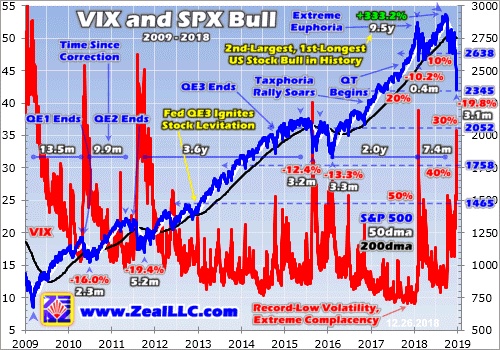

Major stock-market selloffs are defined based on size. Anything under 4% isn’t worth classifying, it is just normal market noise. Then from 4% to 10%, selloffs become pullbacks. In the 10%-to-20% range they grow into corrections. And of course beyond that at 20%+ they are in formal bear-market territory. This selloff snowballed darned close to beardom on Christmas Eve, the SPX plunging to a 19.8% loss over 3.1 months!
Just 4 trading days earlier before the latest FOMC decision, it was only down 13.1%. While that latest Fed rate hike was expected, the future-rate-hike outlook among top Fed officials wasn’t dovish enough for stock traders. Despite all the market carnage since the previous dot plot, their effective forecast for future rate hikes was merely lowered from 4 more to 3. So the SPX plunged 7.7% over the next 4 trading days!
Even before that this selloff hasn’t behaved like a normal bull-market correction. Their purpose is to vent excessively-bullish sentiment, rapidly bleeding off greed. Sharp selloffs are necessary to do that. Traders don’t get worried until stocks fall fast enough and far enough to shatter their complacency. So normal bull-market corrections are usually front-loaded with sharp selloffs that trigger soaring levels of fear.
Prevailing fear levels are inferred by the VIX, which technically measures the implied volatility in 1-month SPX options. Before last peaking in late September, the SPX suffered 5 bull-market corrections within its epic secular bull. Heading into July 2010 the SPX fell 16.0% in 2.3 months. That spawned some real fear, as evident in the VIX soaring to a 45.8 peak. The effective fear ceiling outside of panics and crashes is a 50 VIX.
The next SPX correction cascaded 19.4% lower over 5.2 months ending in October 2011. Despite its long span, the VIX skyrocketed as high as 47.5 in its midst. That was real fear, the kind necessary to slay exuberant greed and rebalance sentiment to keep an ongoing stock bull healthy. After that the SPX went a near-record 3.6 years without a single correction-grade selloff in an extraordinary levitation driven by the Fed.
That’s when its unique open-ended third quantitative-easing campaign was in full swing. QE3’s peak year was 2013 which saw the Fed monetize a staggering $1020b of bonds! The SPX soared 29.6% higher that year on such vast liquidity injections. But 2014 saw QE bond buying collapse to $450b as the Fed tapered QE3. The SPX only rallied 11.4% that year, its gains shrinking 62% in proportion with QE3’s 56% decline.
The QE3-goosed stock markets wouldn’t correct again until well after QE3 ended, the SPX sliding 12.4% over 3.2 months into August 2015. Again the VIX surged to 40.1, which is up in the very-high fear zone. The next debatable correction followed right after. The SPX didn’t achieve new highs after the previous one, so it was technically one compound correction instead of two separate ones. Analysts render it both ways.
That second correction or second part of the longer one saw the SPX fall 13.3% over 3.3 months into February 2016. That was the only bull-market exception that didn’t see a high VIX, it merely climbed to 28.1 at best. But since the VIX had just recently surged over 40 in a fear climax, another one apparently wasn’t necessary. That rolling-over SPX action into early 2016 actually looked more bear-like than bull-like.
Provocatively it took fully 13.7 months after that May 2015 topping for the SPX to finally hit new highs confirming its bull was alive. The thing that short-circuited what felt like a young bear was hopes for more European Central Bank easing after the UK’s surprise Brexit vote in late June 2016. Then the SPX again exploded higher in November 2016 after Trump’s surprise presidential victory with Republicans controlling Congress.
Optimism and greed exploded on hopes for big tax cuts soon, fueling a powerful stock-market surge into early 2018. The SPX then corrected sharply into early February with a 10.2% plunge in just 0.4 months. The VIX shot up to 38.8 on that, showing real fear. All bull-market corrections with the lone exception of the second part of that compound one exhibited telltale fear spikes averaging VIX peaks way up at 43.1.
But the recent SPX selloff of Q4’18 coinciding with the first-ever full-speed Fed QT looks way different. It has been mostly an orderly, gradual selloff generating modest fear. The highest VIX close between late September and pre-FOMC in mid-December was merely 25.8! Even on Christmas Eve it only hit 35.8. These are too low for normal sharp bull-market corrections, this fear profile is looking more like a bear downleg.
While bull-market corrections are supposed to shock and scare, bear-market downlegs start more subtlety. Instead of plunging fast then stabilizing, bear selloffs start slow then gather steam later. Bears begin in stealth mode, only gradually rolling over to prevent fear from spiking. Without big fear to wake them up and scare them out, investors complacently stay deployed as their losses slowly and inexorably mount.
Like the proverbial frog slowly being boiled alive, investors don’t realize the peril their capital is in during bear markets until way too late. The lack of normal bull-market-correction fear spike during this latest correction-grade selloff disturbingly suggests a new bear has awoken. And coming after such a massive and largely-artificial QE-inflated stock bull, the fearsome bear QT has to spawn should be proportionally large.
On Christmas Eve the SPX was forced close to a 20% bear-cub loss at 2345. That level was first seen in February 2017, and represents nearly 3/4ths of the post-Trump-election taxphoria rally being wiped out. 30% would drag the SPX back down to 2052, which were November 2014 levels right after the QE3 bond monetizations ended. 40% would crush the SPX to 1758, back to October 2013 levels killing 4.9 years of gains.
But after one of the biggest and longest stock bulls in U.S. history, it would be shocking if the subsequent bear didn’t lop off at least 50%. Especially given this bull’s artificial QE-inflated nature in an era where QE-conjured capital is being destroyed by QT. A 50% SPX loss from late-September’s peak would leave it at 1465. Those levels were first seen in this bull all the way back in September 2012, 6.0 years earlier.
While a 50%+ bear warning may sound sensational or overly dramatic, it’s actually fairly conservative. The SPX already suffered two bear markets since the tech-stock bubble peaked in March 2000. The first one ending in October 2002 mauled the SPX 49.1% lower over 2.6 years. The second one climaxing in the first stock panic in a century drove a far-worse 56.8% SPX decline in just 1.4 years ending in March 2009.
50% bears are totally normal after large bulls, even when they don’t have the amplifying dynamics of the first-ever colossal-scale Fed QE and QT. This overdue next bear has a great chance of growing bigger than normal after such a monstrously-grotesque bull. Most investors won’t figure this out until too late. Unlike bull-market corrections, high-fear VIX spikes soaring into the 40-to-50 range don’t ignite until later in bears.
While the extreme Fed tightening under this unprecedented full-speed QT campaign could easily drive a major stock bear alone, so could excessive valuations. When the SPX peaked in late September, its 500 elite stocks were collectively trading at literal bubble valuations! Extreme valuations are what usually cause stock bears, which exist to force stock prices back into line with corporations’ underlying earnings.
The classic honest way to measure valuations is through trailing-twelve-month price-to-earnings ratios. These take companies’ last four quarters of actual hard GAAP earnings, add them up, and divide them by companies’ prevailing stock prices. Unlike fictional forward earnings, real past results aren’t mere guesses about the future. Over the past century and a quarter or so, the U.S. stock markets averaged a 14x TTM P/E.
That’s long-term historical fair value, which is logical and reasonable. The reciprocal yield of 14x is 7.1%, an interest rate that is mutually beneficial to both pay and be paid for investment capital. Twice that at 28x earnings is the formal bubble threshold. As of the end of September just after the SPX peaked, its elite companies averaged a TTM P/E well into bubble territory at 31.4x earnings. They were dangerously overvalued.
This next chart looks at average SPX valuations in TTM P/E terms over the past couple decades or so. The 500 SPX components’ simple-average P/E is rendered in light blue. The dark-blue line shows it instead weighted by companies’ market capitalizations. The SPX is superimposed over the top in red, while a hypothetical fair-value SPX at 14x earnings is shown in white. This valuation picture is ominously damning.
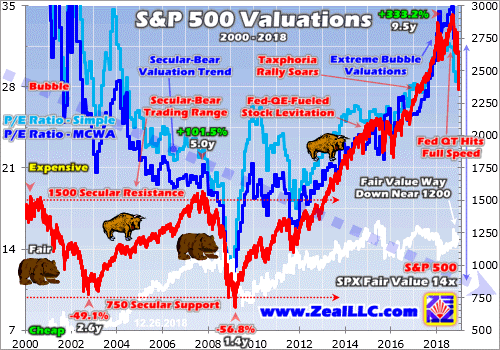

The bubble valuations around the SPX’s late-September peak were nothing new. They had been above that 28x threshold continuously for 14 months since July 2017. Stocks were already expensive before Republicans swept the November 2016 elections kindling those exuberant big-tax-cuts-soon hopes. But they got a lot more expensive after that as stock prices soared way faster than corporate earnings since.
Again excessive valuations are what normally spawn stock bears. Stock prices get bid up too fast during bull markets for underlying earnings to justify. So bears follow bulls to drag stocks lower or just sideways for long enough for corporate profits to catch up with prevailing stock prices. These mean reversions after large bulls usually see valuations overshoot towards the opposite extreme before bears give up their ghosts.
So odds are this young stock bear won’t head back into hibernation until the stock markets’ average TTM P/E ratio per the elite SPX components actually falls under 14x. Major bears usually bottom with the SPX P/E in the 7x-to-10x earnings range, the former being half fair value when stocks are very cheap and screaming buys. Late in the last stock bear climaxing in March 2009, the SPX’s TTM P/E slumped to 12.6x.
But let’s be conservative and just assume this next bear, even with Fed QT, merely mauls stocks long enough to force a fair-value 14x P/E with no overshoot. Assuming corporate earnings don’t grow much which is a real possibility during a serious stock bear, that implies 51% downside from the SPX’s late-November levels. That was the latest month-end valuation data available when this essay was published.
Historical fair value sans earnings growth implies a bear-market bottom near SPX 1356, or 53.7% under late September’s peak! That’s right in line with historical major bear markets, nothing unusual. As bears generally last a couple years or so, modest underlying corporate-profits growth could lift that valuation-based bottoming target maybe 10% or so. That still implies a 49.1% total bear which isn’t to be trifled with.
The combination of wildly-unprecedented full-speed Fed QT slamming QE-inflated stock markets trading at bubble valuations is incredibly menacing. Seeing bear-market-like rolling-over selling behavior without big fear spikes in recent months strongly argues the overdue bear has awoken. But since all that selling has been concentrated fully within a single quarter, odds are most investors don’t realize how bad things are.
The biggest group of investors with the most capital are casual retirement investors who don’t closely follow the markets. They avoid much work and stress by paying other people to manage their money. These investors get statements showing their portfolios’ fortunes after every calendar quarter. At the end of Q3’18, everything still looked awesome with the SPX just 0.6% under its all-time high of a week earlier.
So the Q4’18 statements due out in January could prove shocking, spawning fear and galvanizing bearish psychology. The most-widely-held stocks in investment funds are the biggest and best ones led by the market-darling mega techs. While they were radically overvalued at the end of Q3, no one cared at that point. Everyone owned the largest US stocks including Apple, Amazon, Microsoft, Alphabet, and Facebook.
Add in the last FANG Netflix, and these 6 stocks alone commanded over 1/6th of the entire market cap of the SPX just before the Q4 selling started! Their average TTM P/E was a scary 80.2x earnings, 2.6x the entire SPX’s. Yet these beloved companies were believed to have such amazing businesses that they should be immune to economic slowdowns or stock-market selloffs. That myth was obliterated in Q4.
This SPX selloff first hit 10%+ correction territory on Black Friday with a 10.2% loss from its peak. On that same day, mighty Apple, Amazon, Microsoft, Alphabet, Facebook, and Netflix had collapsed 25.8%, 26.4%, 10.8%, 19.9%, 39.4%, and 38.2% from their recent all-time highs! They averaged 26.8% losses, or 2.6x the SPX’s. Many if not most investors’ Q4’18 portfolio results are going to look even worse than the SPX.
Will they start fleeing and adding to the selling pressure when these gaping holes in their precious capital are revealed? And while record Fed tightening and a mean reversion lower out of bubble valuations are the primary bear-market risks, they aren’t the only ones. The trade wars between the US and China and other countries are intensifying, and U.S. political turmoil will soar next year with Democrats controlling the House.
The epic corporate stock buybacks that helped levitate the stock markets in recent years will wane as the Fed forces interest rates higher. Trillions of dollars of these buybacks were debt-financed over the past decade. And as stock markets fall, Americans will feel poorer and spend less. This negative wealth effect will really weigh on record corporate profits, potentially driving them lower forcing valuations even higher.
The Fed’s QT isn’t the only howling central-bank headwind stock markets face. The European Central Bank is also halting its own massive QE bond monetizations starting in January! That will suck even more capital out of the system. Many of these bearish factors for stocks feed on each other too, with all combined wreaking more havoc on sentiment and stock prices than individual ones ever could in isolation.
Investors really need to lighten up on their stock-heavy portfolios, or put stop losses in place, to protect themselves from this young bear market. It’s only just beginning, with sub-20% SPX losses at worst a far cry from 50%+. Cash is king in bear markets, since its buying power grows. Investors who hold cash during a 50% bear market can double their stock holdings at the bottom by buying back their stocks at half-price.
Put options on the leading SPY S&P 500 ETF which perfectly mirrors the SPX can also be used to hedge downside risks. But options trading is risky, with 100% losses possible if the timing doesn’t work out. And cash doesn’t appreciate in value. So the best bear-market investment is gold, which tends to rally on surging investment demand as stock markets weaken. Gold investment grows wealth during stock bears.
Gold surged 30% higher in essentially the first half of 2016 in a new bull initially sparked by those late-2015 and early-2016 SPX corrections. Investors fled burning stocks and flocked to gold. And the gold miners’ stocks really leveraged those gains, rocketing 151% higher in that same timeframe. The gold stocks are not only wildly undervalued, but just breaking out technically which should accelerate their upside.
Absolutely essential in bear markets is cultivating excellent contrarian intelligence sources. That’s our specialty at Zeal. After decades studying the markets and trading, we really walk the contrarian walk. We buy low when few others will, so we can later sell high when few others can. While Wall Street will deny the growing stock-market bear all the way down, we will help you both understand it and prosper during it.
We’ve long published weekly and monthly newsletters for speculators and investors. They draw on my vast experience, knowledge, wisdom, and ongoing research to explain what’s going on in the markets, why, and how to trade them with specific stocks. As of Q3, we’ve recommended and realized 1045 newsletter stock trades since 2001. Their average annualized realized gain is +17.7%! That’s double the long-term stock-market average. For just $12 per issue, you can learn to think, trade, and thrive like contrarians. Subscribe today!
The bottom line is a young stock bear sure looks to be awakening. Q4’s rolling-over stock-market selling without big fear spikes is ominously classic bear-market behavior. And after such a monster bull, the next bear is long overdue. Unprecedented full-speed Fed QT colliding with bubble-valued U.S. stock markets artificially inflated by long years and trillions of dollars of Fed QE can’t end well. The reckoning is upon us.
Major bear markets follow major bull markets, often cutting stock prices in half over a couple years or so. And these inexorable bull-bear cycles are very unforgiving, as it can take over a decade for stock markets to regain bull highs once a bear starts ravaging. Gold is the refuge of choice, seeing investment demand surge as stock markets swoon. Prudent investors deploying in gold can grow their wealth during stock bears.
Adam Hamilton, CPA
December 31, 2018
Copyright 2000 – 2018 Zeal LLC (www.ZealLLC.com)
Weary investors who endured the September and October stock market “crash season” felt they should be richly rewarded for their incredible patience… with a wondrous Santa Claus rally
Please click here now. The traditional Santa Claus rally has morphed into a hideous Santa Claws mauling of millions of US stock market price chasers. It’s a gruesome sight. The good news, clearly, is that my prediction has come true and both gold and senior miners have leaped into the limelight.
They are happily basking in their new role as safe haven beacons of safety for smart money investors. Please click here now. Double-click to enlarge this “Queen of Assets” gold chart.
While the stock market incinerates, gold is in a mighty uptrend. Note the fabulous flat line event taking place now on my 14,7,7 Stochastics oscillator at the bottom of the chart. This type of technical action is extremely positive. The world’s mightiest metal is poised to surge above the uptrend channel supply line and roar straight to my $1300 target price zone!
Please click here now. Double-click to enlarge. Silver has held its own against the dollar and higher price enthusiasts will likely get the rally they deserve in 2019. Because silver is used extensively in industrial applications, it tends to lag gold as the business cycle peaks. Demoralized stock market investors don’t see signs of aggressive growth in inflation yet, so they leave silver alone.
Once inflation begins to pick up more aggressively and US GDP growth contracts more substantially, silver will start to rally as aggressively as gold and the senior miners are rallying now.
I see that happening by the second half of 2019, but a three-day close over $15.20 would be a strong indication that commercial traders anticipate stagflation and are getting invested in this superb metal ahead of time.
As 2018 got underway, I urged investors to focus on President Trump’s success in the private sector and use his fabulous work ethic, organization, and planning skills as an inspiration to act professionally in the major markets.
Unfortunately, many investors believed that Trump’s power as president gave them a free pass to act unprofessionally in the major markets.
They believed the incredible success that America achieved in the 1880s “Golden Age” and the 1950s could be re-created by Trump… even though America’s demographics are now essentially the opposite of what they were in those two glorious time frames.
These investors essentially devolved into maniacal US stock market price chasers, and they ignored the clear “safehavenization” of senior gold stocks that was taking place.
The bottom line: Investors will always pay a price for sloppy actions in the market and they will always reap incredible rewards for high-level professionalism.
Please click here now. Double-click to enlarge. I developed the STL (Stewart’s Traffic Lights) system to provide clear green and amber light signals for an array of assets over both the short and long term.
Horrifically, the Dow Jones Industrial Average is now flashing a weekly chart amber STL. Amateur investors like to “wait for a rally” to sell. I like to obey traffic lights.
If the light turns amber, I don’t race my stock market car through the intersection, especially when a quantitative tightening freight train on central bank “auto pilot” is barrelling through that intersection. I don’t predict when the STL will turn green. I wait for it to turn green, and then I buy.
At my guswinger.com swing trade service, I have the “party people” short USD versus the yen, long GDX via triple-leveraged NUGT, and short the stock market via SDOW. It’s certainly a very Merry Christmas today for all the GU Swinger partygoers!
This year, America awakes on Christmas day with the socialist “demorats” back in control of the House, the stock market on a major sell signal… and with gold and the senior miners acting like the brightest Christmas lights in town!
Please click here now. Double-click this superb GDX “chart of champions”. As the Dow tumbled 600 points, GDX surged above the $21 resistance zone on a closing basis!
Note the enormous rise in volume. There’s also a flat line event taking place with the Stochastics oscillator. From a technical perspective, this chart is a bullish masterpiece that looks like Michelangelo created it.
Santa Claws came to U.S. stock market town, but Santa Claus came down every gold bug’s chimney with wondrous higher priced gold and senior miner tidings! Enjoy! Enjoy, because the current market themes in play are poised to dramatically accelerate in 2019. Best wishes to the entire global community!
Stewart Thomson
Graceland Updates
Email:
stewart@gracelandupdates.com
stewart@gracelandjuniors.com
stewart@guswinger.com
Stewart Thomson is a retired Merrill Lynch broker. Stewart writes the Graceland Updates daily between 4am-7am. They are sent out around 8am-9am. The newsletter is attractively priced and the format is a unique numbered point form. Giving clarity of each point and saving valuable reading time.
Risks, Disclaimers, Legal
Stewart Thomson is no longer an investment advisor. The information provided by Stewart and Graceland Updates is for general information purposes only. Before taking any action on any investment, it is imperative that you consult with multiple properly licensed, experienced and qualified investment advisors and get numerous opinions before taking any action. Your minimum risk on any investment in the world is: 100% loss of all your money. You may be taking or preparing to take leveraged positions in investments and not know it, exposing yourself to unlimited risks. This is highly concerning if you are an investor in any derivatives products. There is an approx $700 trillion OTC Derivatives Iceberg with a tiny portion written off officially. The bottom line:
Are You Prepared?
As we’ve been saying, the stock market will have great influence on Gold. It has been easy to see in recent months.
The S&P 500 has cracked, losing both its 200-day and 400-day moving averages. Gold and gold stocks have benefitted and gained in recent months even with a stable to rising U.S. Dollar.
The past 65 years of history shows us that in almost any context (but not all) the time between the Fed’s last rate hike and first rate cut is exactly when you want to buy gold stocks.
We don’t know if December is the last rate hike. No one does.
What we do know is the stock market is approaching an extreme oversold condition and is likely to begin a counter trend rally very soon.
In the chart below we plot five indicators that can help define an extreme oversold condition. These include the Vix, the put-call ratio and several breadth indicators. All but the Vix are in extreme oversold territory.
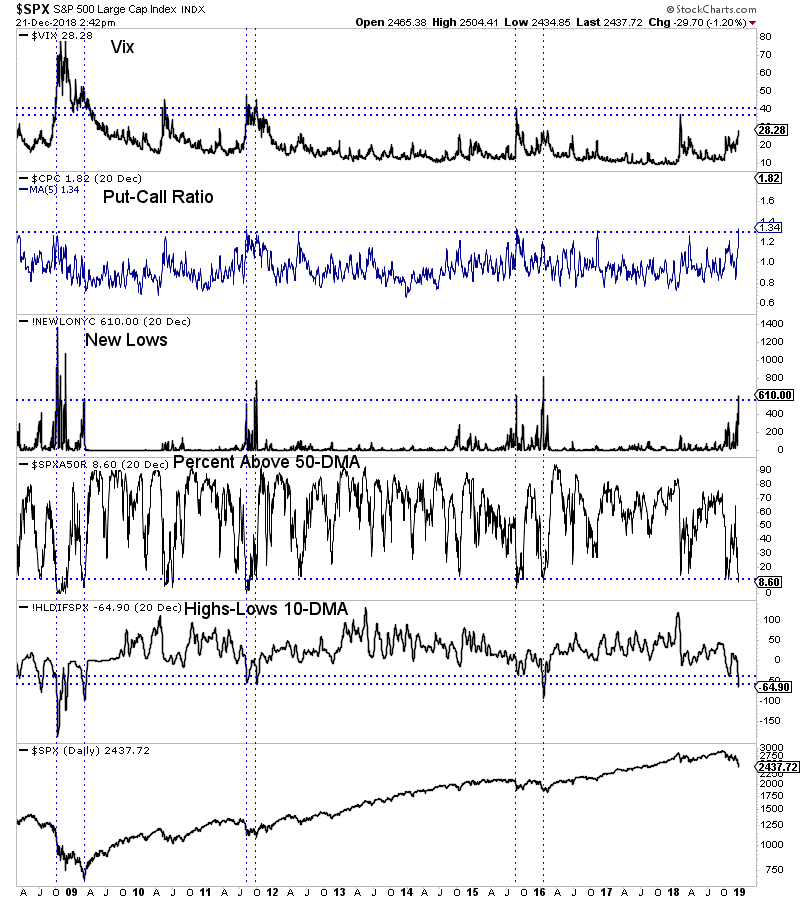

As we pen this article, the S&P 500 is trading at 2436.
The 40-month moving average, which has provided key support and resistance over the past 20 years (including the 2016 and 2011 lows) is at 2395 while the 50% retracement of the 2016 to 2018 advance is at 2380.
The setup for a bullish reversal is in place.
Meanwhile, despite the recent carnage in stocks, precious metals have been unable to surpass resistance.
Gold is set to close the week right below a confluence of resistance at $1260-$1270. Perhaps it will close right on its 200-day moving average at $1258.
The gold stocks (GDX, GDXJ) have been strong since Thanksgiving but appear to have been turned back at their 200-day moving averages.
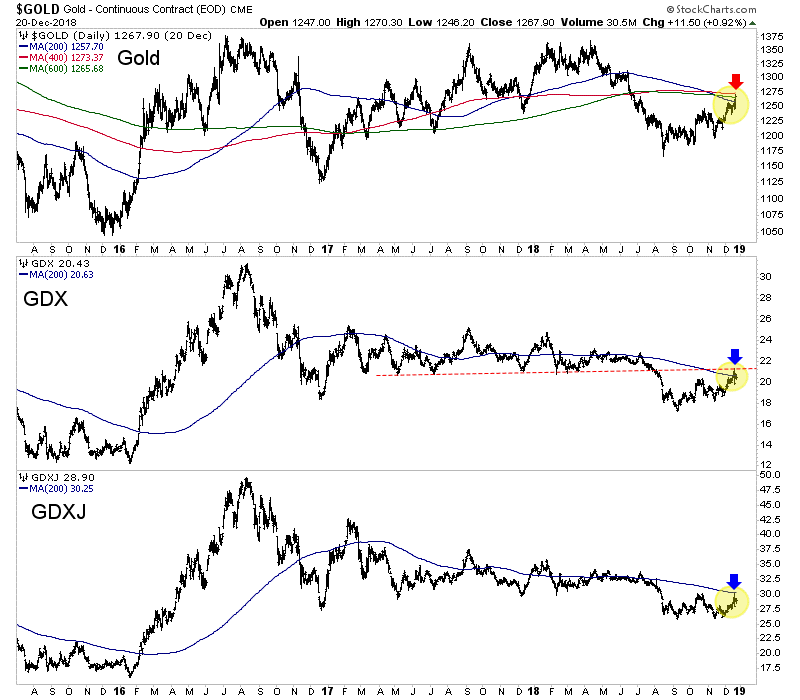

So in recent days the selloff in the S&P 500 accelerated but precious metals (at least to this point) failed to capitalize in a bullish fashion.
If the S&P 500 is within one or two days of a rally then we should not expect much more upside in Gold and GDX in particular. Those were the markets that benefited most from weakness in the S&P 500.
As we noted last week, the weakness in the stock market (and the economy) has not done enough to change Fed policy yet.
Over the past 65 years, the start of bull markets and big rallies in gold stocks coincided with the start of rate cuts. When the market sniffs the first rate cut, we will know precious metals are beginning a sustained advance and not another false start.
Until Gold proves its in a bull market (and the market begins pricing in a rate cut) it would not be wise to chase strength. There will be plenty of time to get into cheap juniors that can triple and quadruple once things really get going. To prepare yourself for an epic buying opportunity in junior gold and silver stocks in 2019, consider learning more about our premium service.
If you would like to receive our free newsletter via email, simply enter your email address below & click subscribe.
CONNECT WITH US
Tweets
Tweet with hash tag #miningfeeds or @miningfeeds and your tweets will be displayed across this site.
MOST ACTIVE MINING STOCKS
Daily Gainers
        |
RTG.TO | +60.00% |
    |
ERL.AX | +50.00% |
    |
MRQ.AX | +50.00% |
        |
AFR.V | +33.33% |
    |
CRB.AX | +33.33% |
        |
GCX.V | +33.33% |
        |
RUG.V | +33.33% |
        |
CASA.V | +30.00% |
        |
BSK.V | +25.00% |
        |
PGC.V | +25.00% |
Articles
FOUND POSTS
Arras Minerals (TSXV:ARK) Updates on Elemes Drill Program in Kazakhstan
December 19, 2024
Potential Trump Tariffs Could Reshape Copper Market Dynamics in 2025
December 17, 2024












